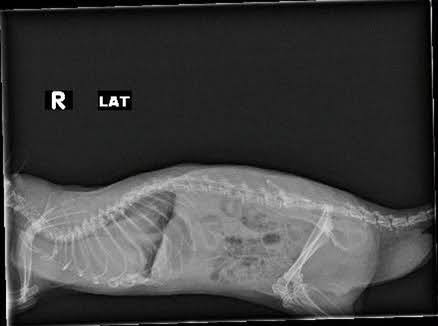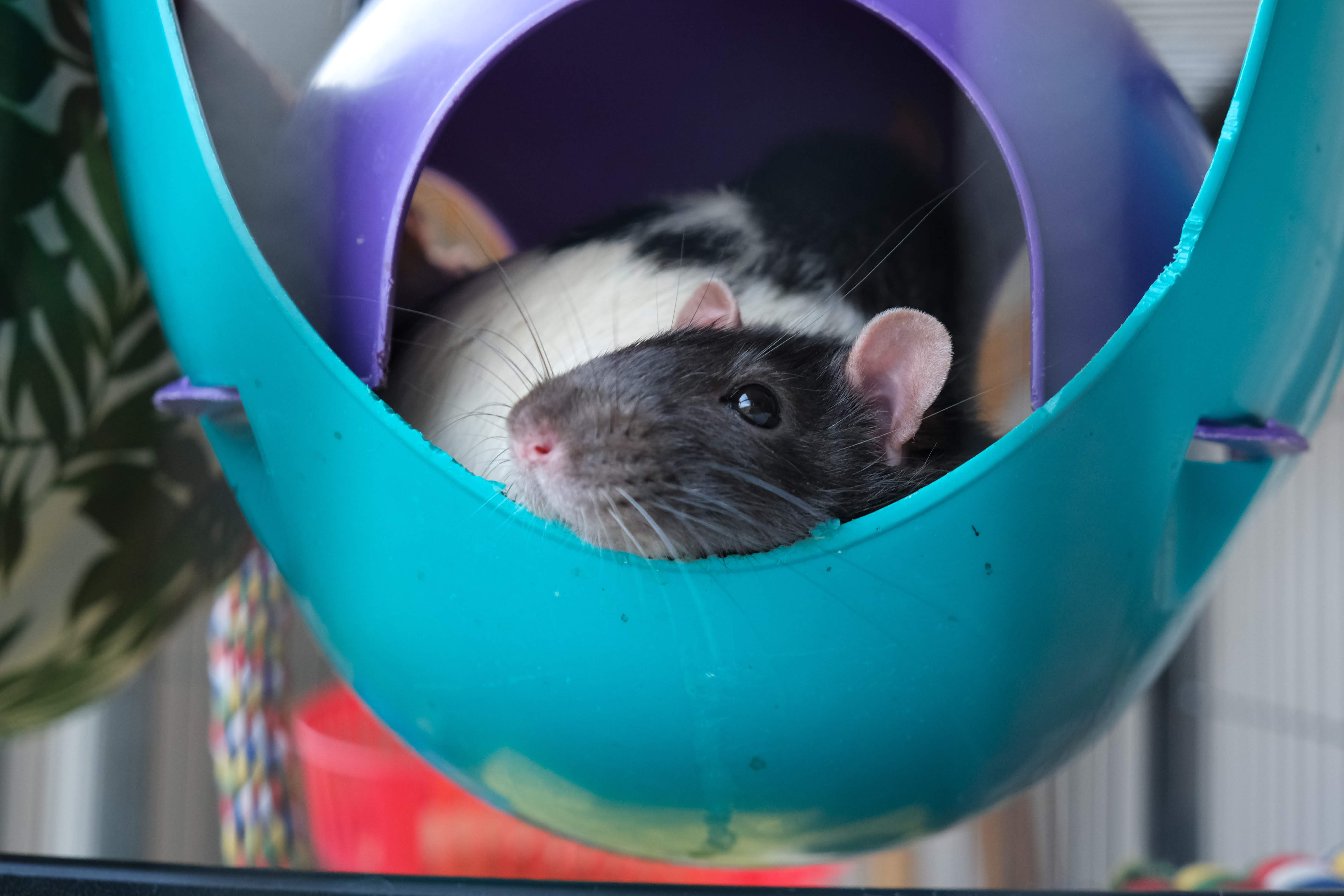
It is important to figure out what is wrong with rats who are unwell as quickly as possible. Oftentimes, it can be difficult to understand what is going on due to scattered, sometimes outddated, information across the web. This page serves as a living library
with new cases and conditions being added as they arise within the community.
WARNING: Graphic imagery and descriptions are present. Read at your own risk.
Please use the index below to jump to a specific category
Abscesses are one of the most commonly seen skin conditions in rats. Easily mistaken for tumours depending on the location, these arise seemingly “overnight” and grow rapidly over the course of a few days to a week. Abscesses are typically self-limiting, and will resolve following a rupture of the site. In extreme cases however, they may require veterinary intervention in which the site is lacerated and drained. The veterinarian may also prescribe antibiotics to help reduce risk of sepsis.
Common locations for abscesses to form:
1. Preputal/Scrotal: typically occurring after neutering, these will usually resolve on their own. Be mindful that the swelling does not affect the rat's ability to urinate.
2. Eye: abscesses can occasionally appear near the eye or on the eyelids, and cause minimal concern after ruling out ZGT
3. Ear: abscesses near the base of the year are usually indicative of a cancerous tumour known as a Zymbals Gland Tumour. These require immediate veterinary intervention
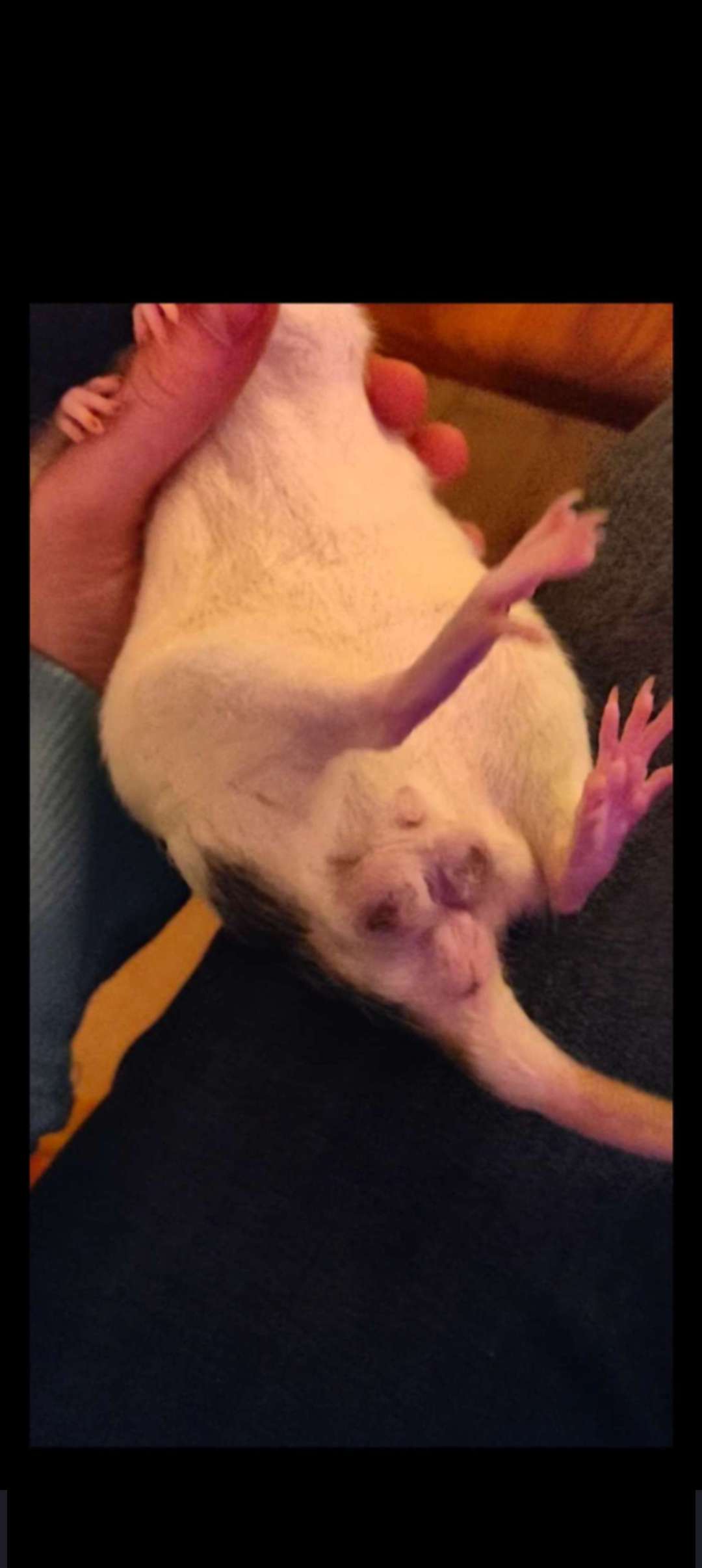
Credit: @listarat on Discord
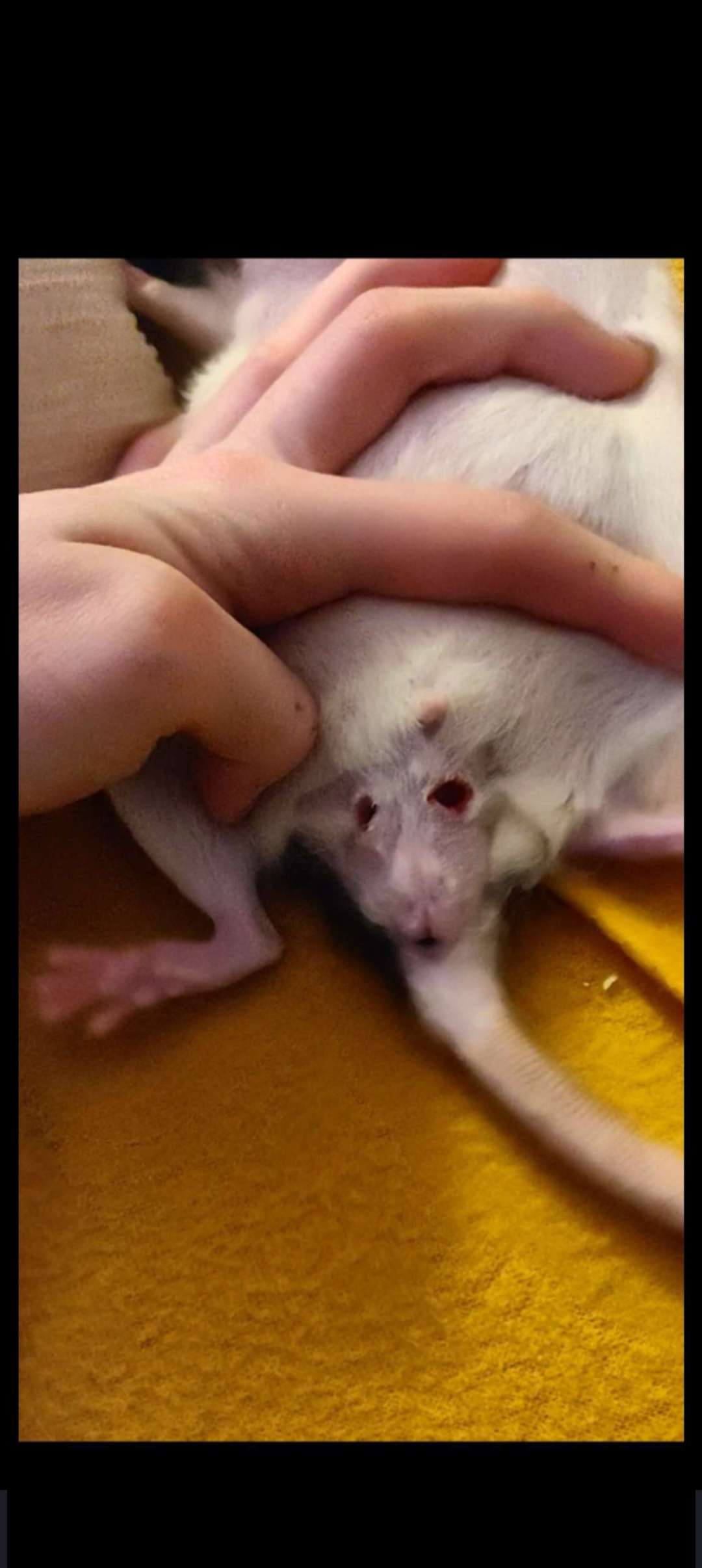
Same abscess following drainage
Credit: @listarat on Discord
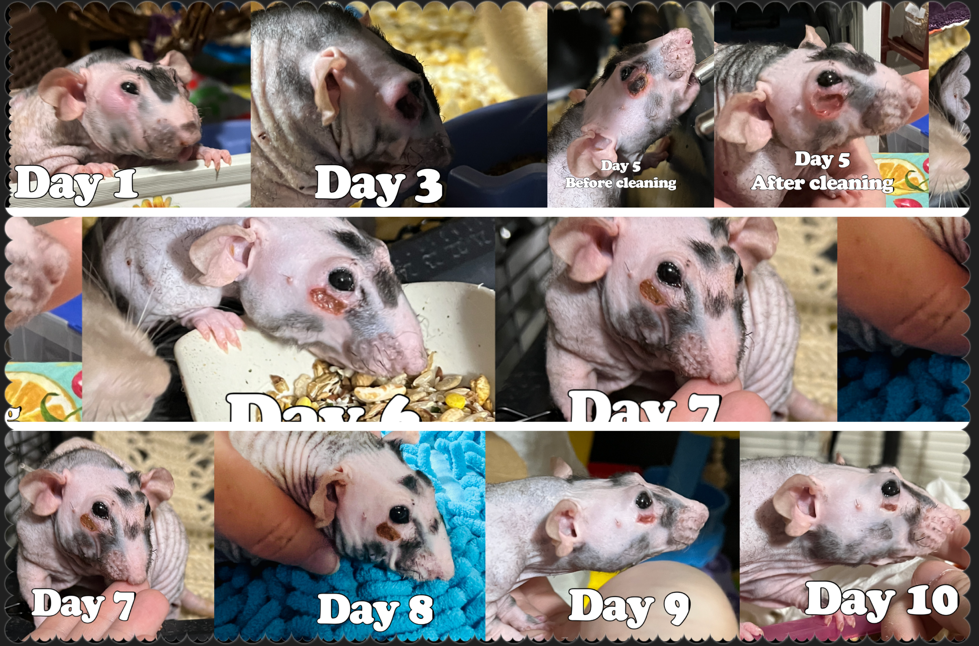
Healing process following veterinarian confirmation that it was not a ZGT. Credit: RatRandomness on Youtube
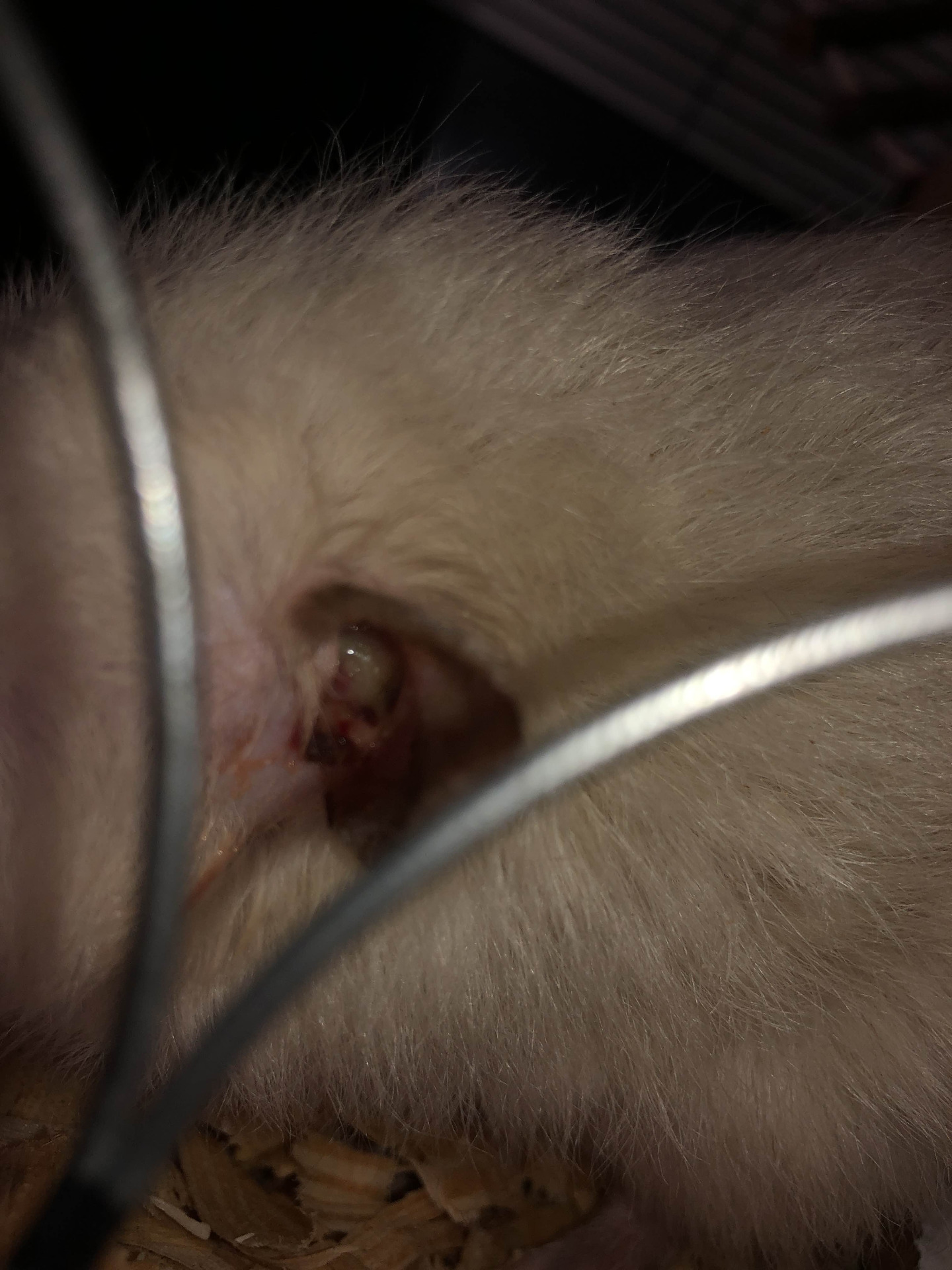
Likely due to a ZGT, an abscess of the inner ear has ruptured, leaving pus

Credit: @klaidon on Discord
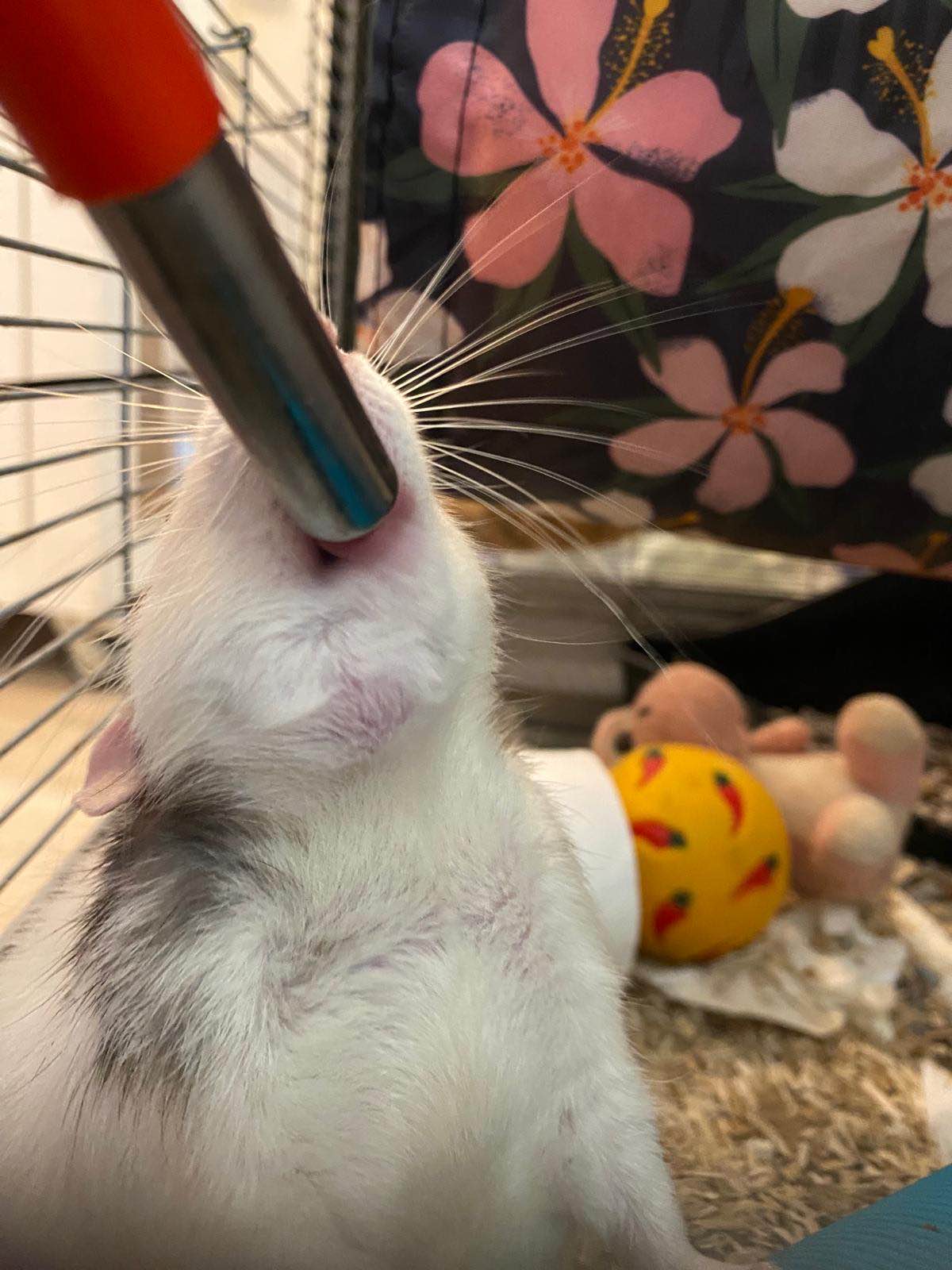
Example of a non-cancerous, general abscess. Credit: @angel1cccccc on Discord
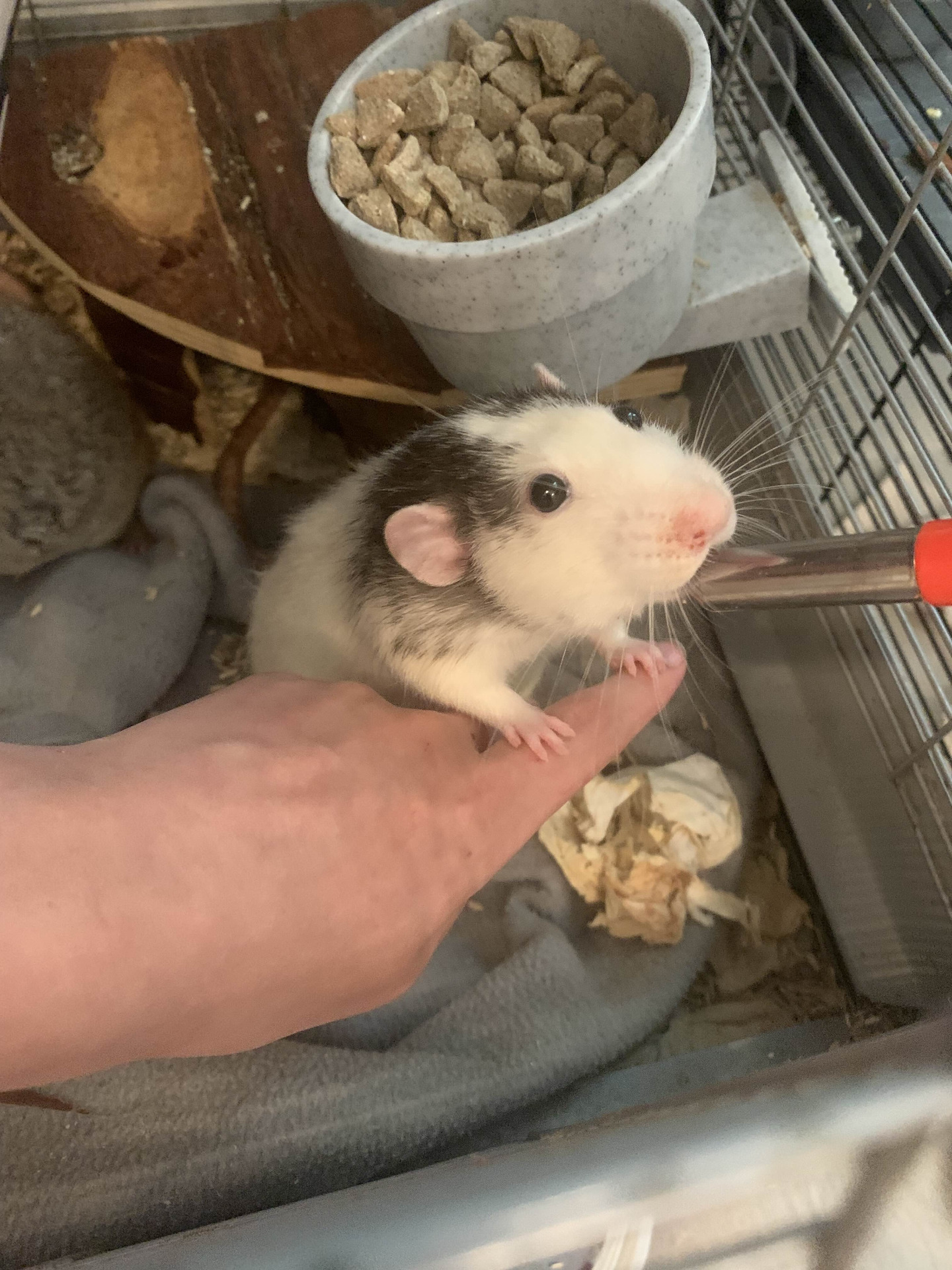
Abscess ruptured and rat made full recovery.
Credit: @angel1cccccc on Discord
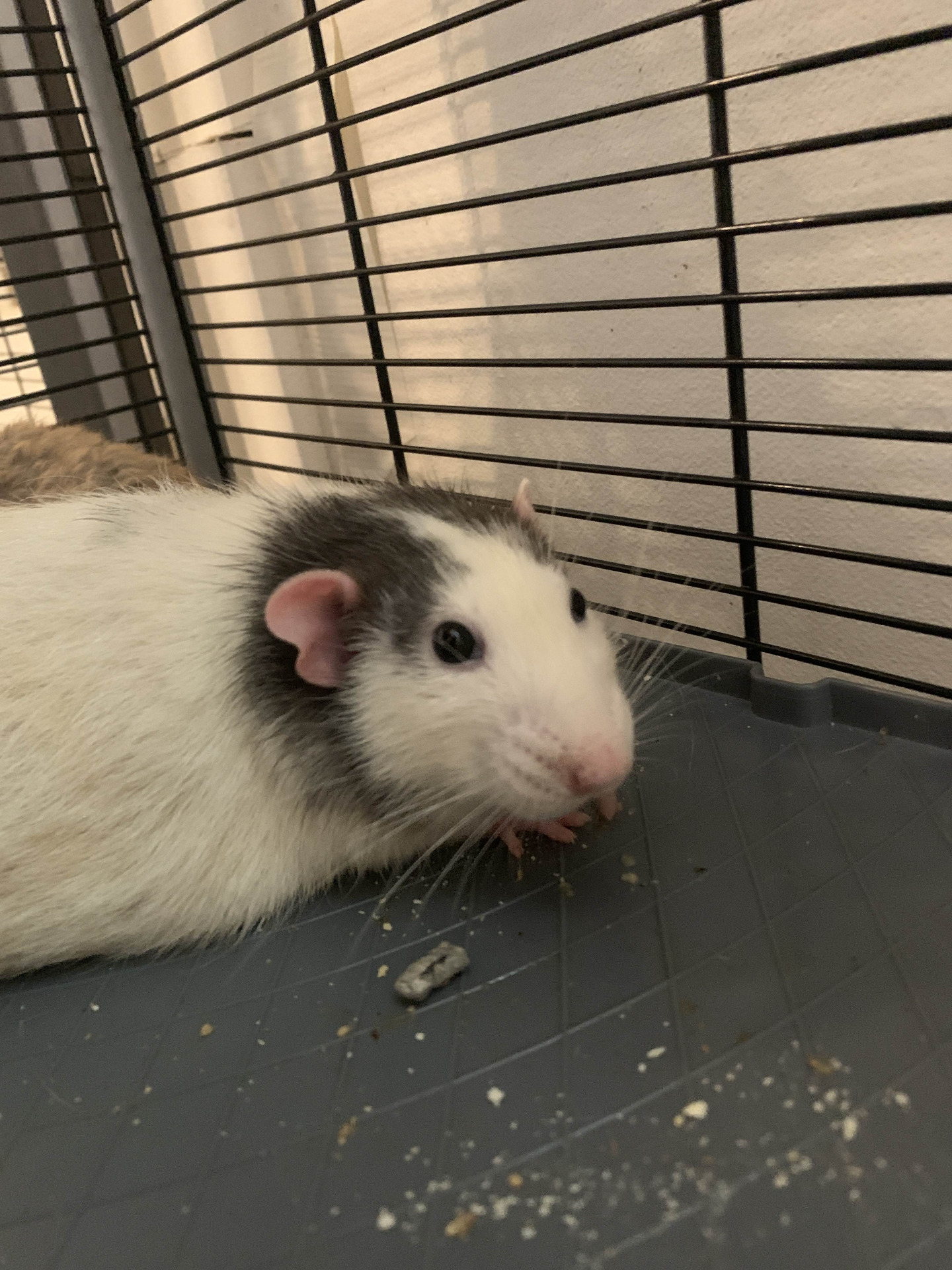
Almost healed cheek absces Credit: @angel1cccccc on Discord
Barbering is characterised by patches of balding with scabbing or lesions absent. The fur may appear shortened or thinned out in areas that are not entirely bald. Caused by the overgrooming of a particular area, it is most commonly seen behind the ears, on the arms or legs, and on the scrotum in males. This is a harmless behavioural quirk in most cases, but can be indicative of stress. It is not considered aggression if carried out by a more dominant cagemate to another, as this should only be of concern if fur pulling, not overgrooming, is occurring.
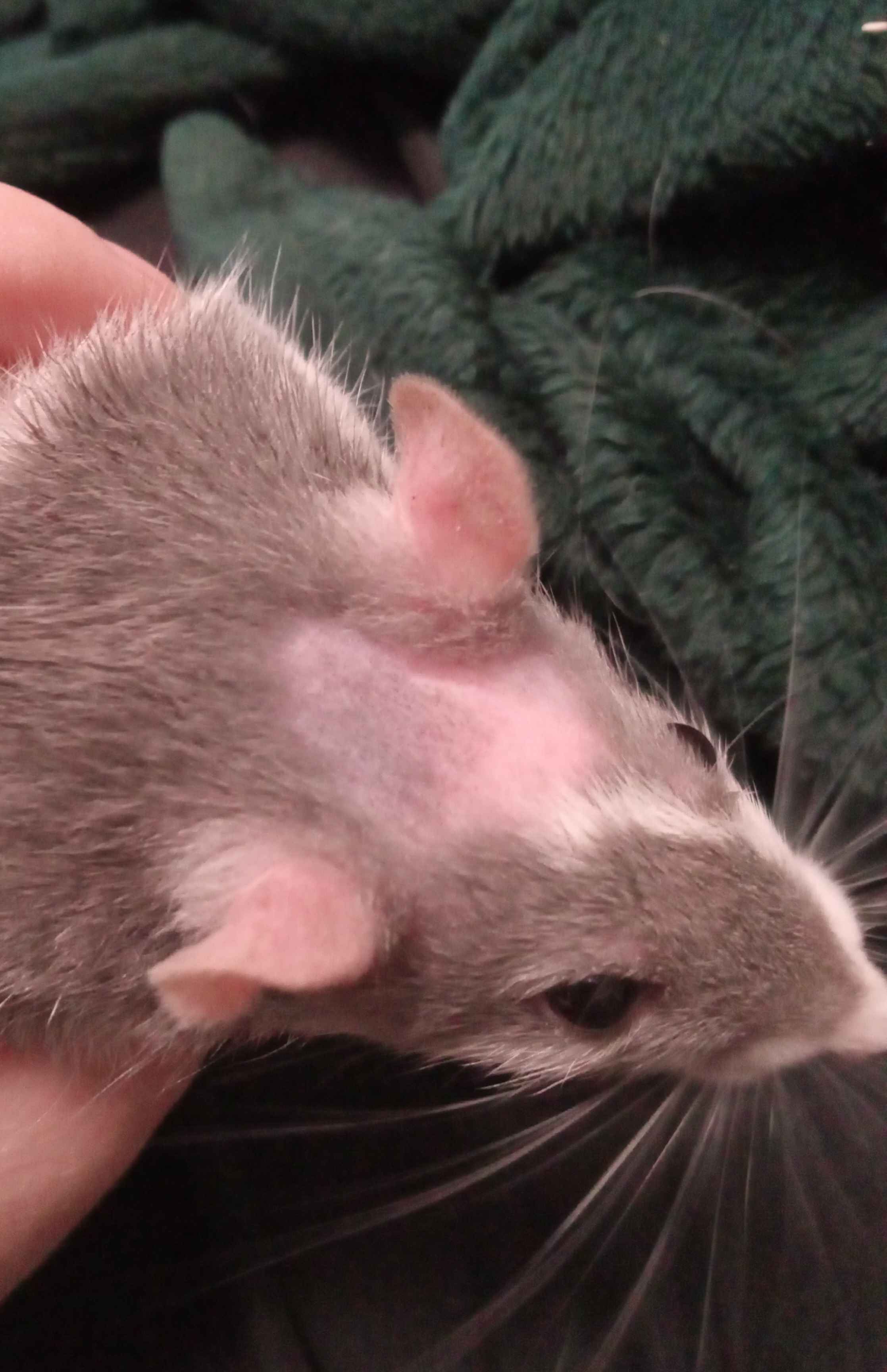
An exceptionally common spot for barbering done by cagemates
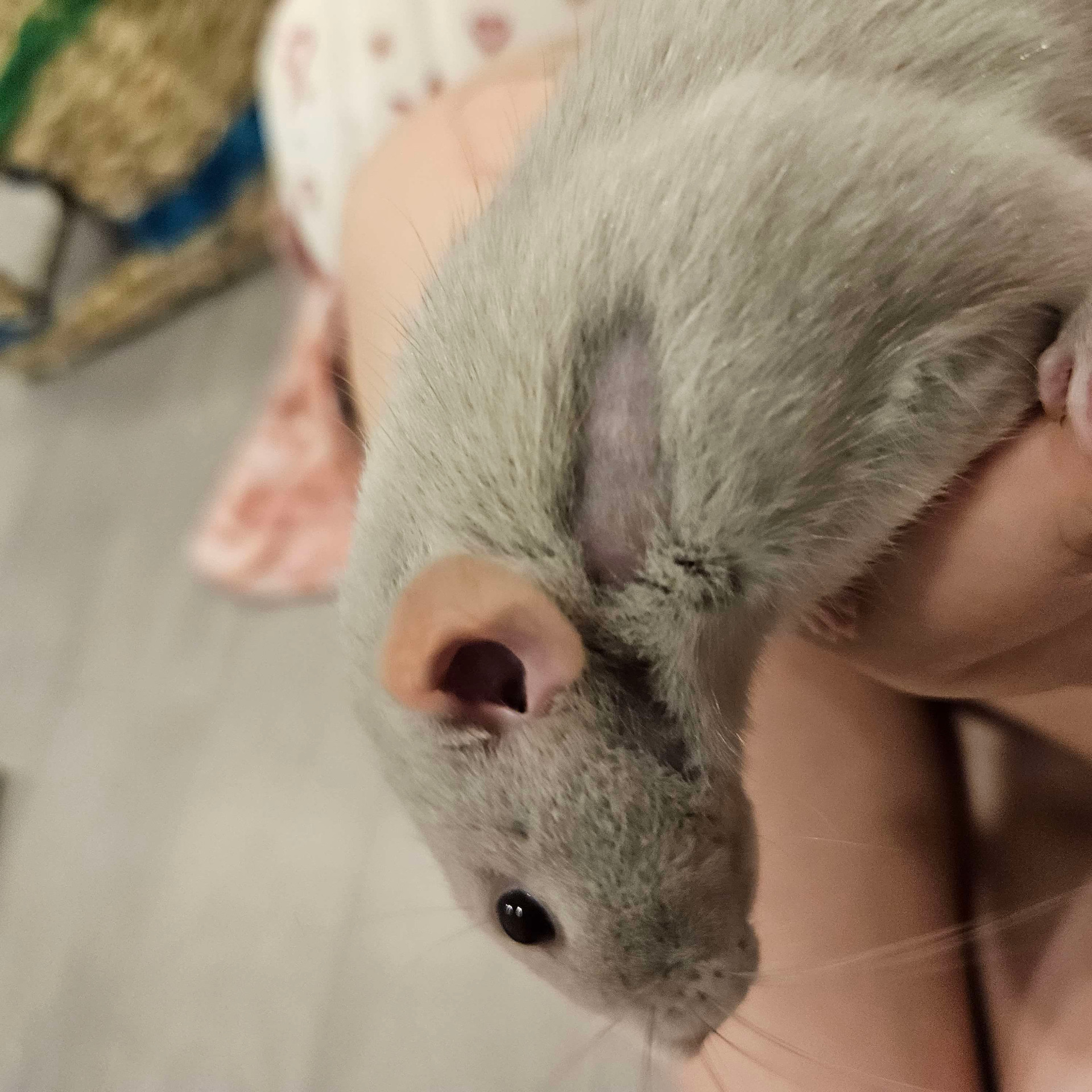
The shoulders are another common spot for cagemate barbering to occur (Credit: @potats on Discord)
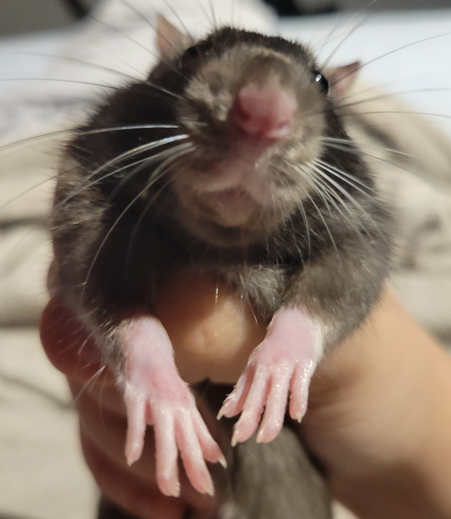
Barbering of the arms or legs is typically self-inflicted
Credit: @silly_set on Discord
Bites can occur if an aggressive rat is interacting with a cagemate or being introduced into a new mischief. This will be significantly different in appearance to that of a scrape, which will be extremely surface-level. Rat bites are serious and require immediate medical attention if it is deeper than just the top layers of skin. If muscle and bone are visible, stitches will be required.
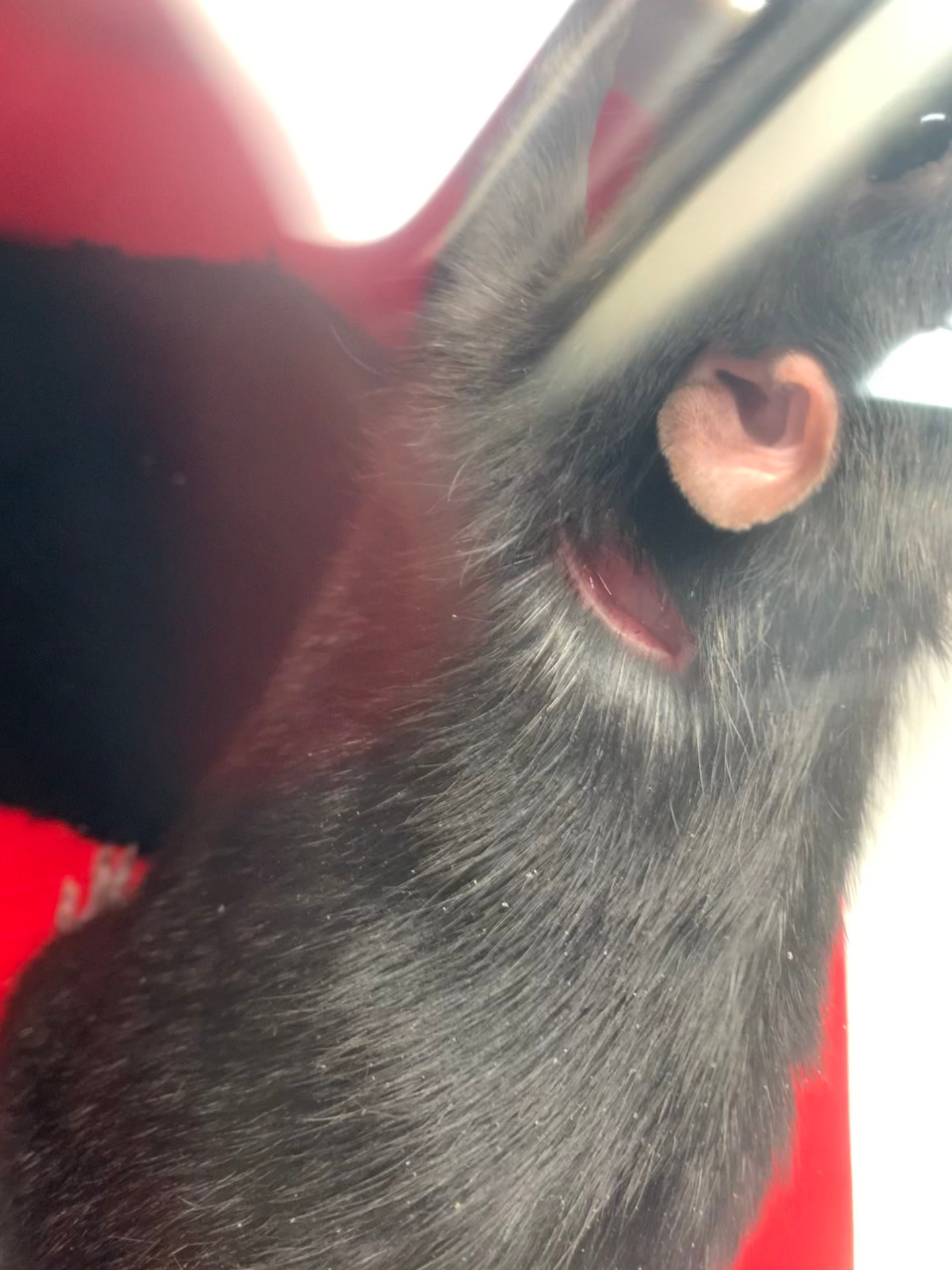
Credit: @kira.t_ on Discord
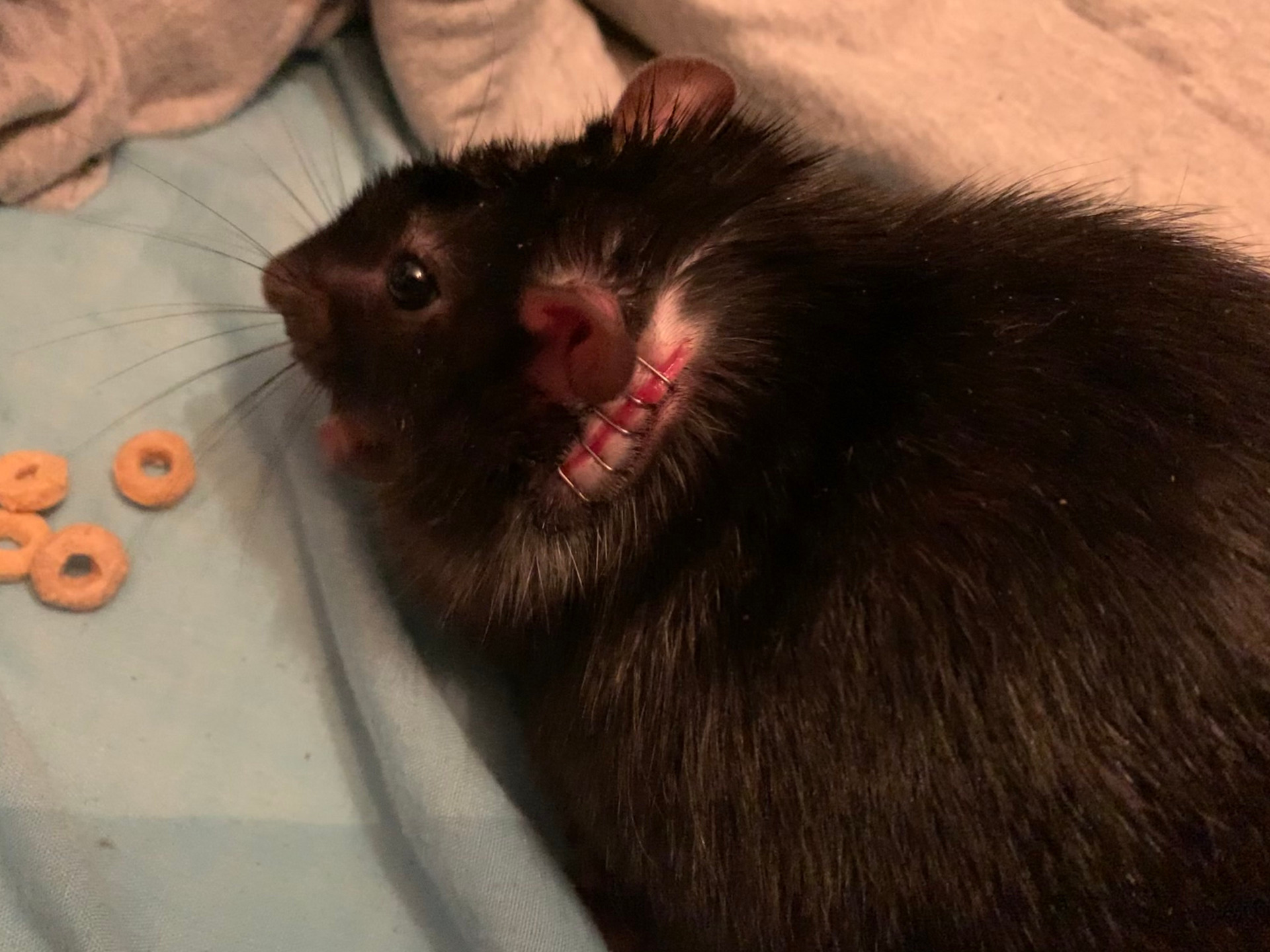
Post-wound staple
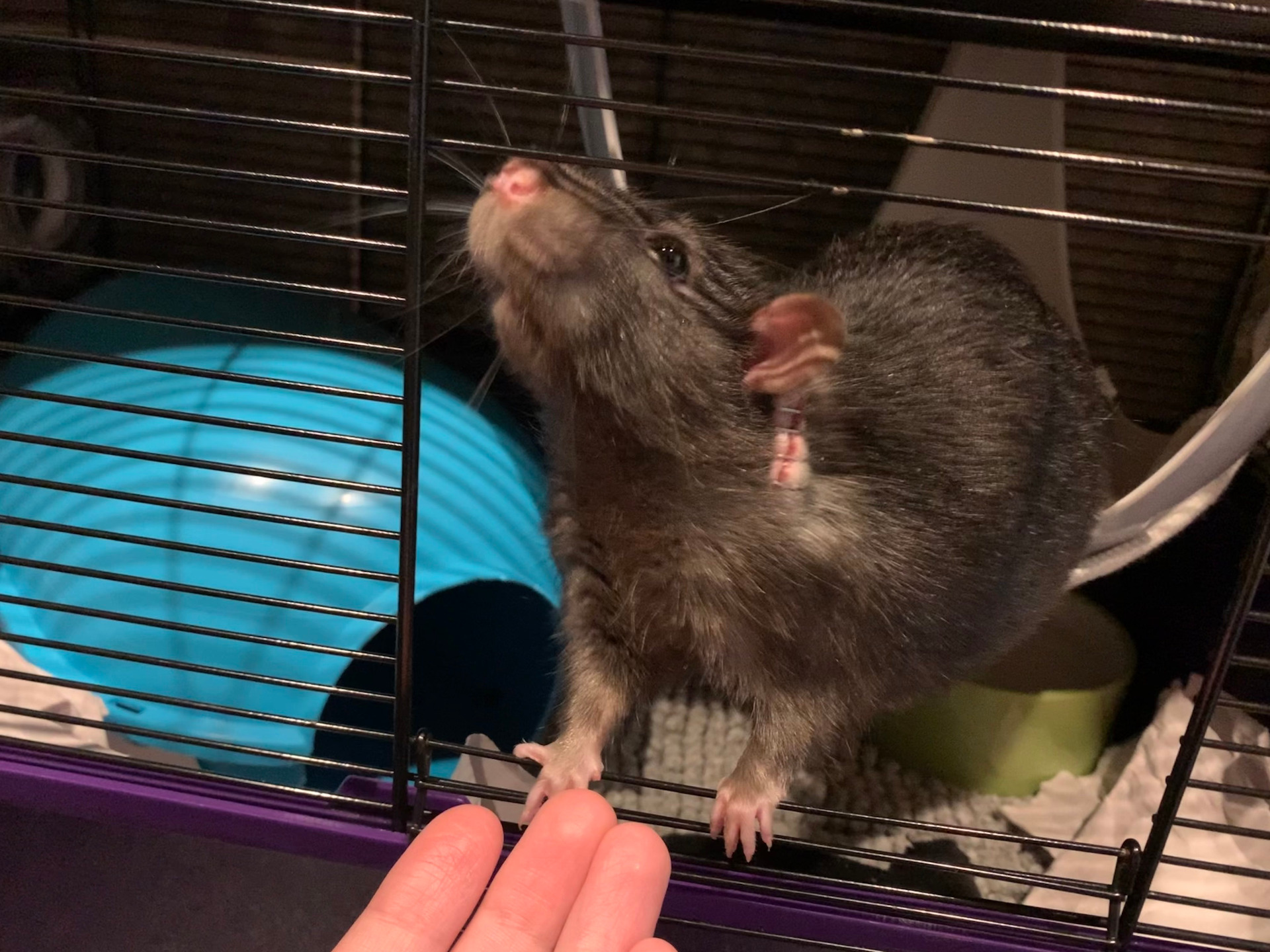
Day 1 post-staple
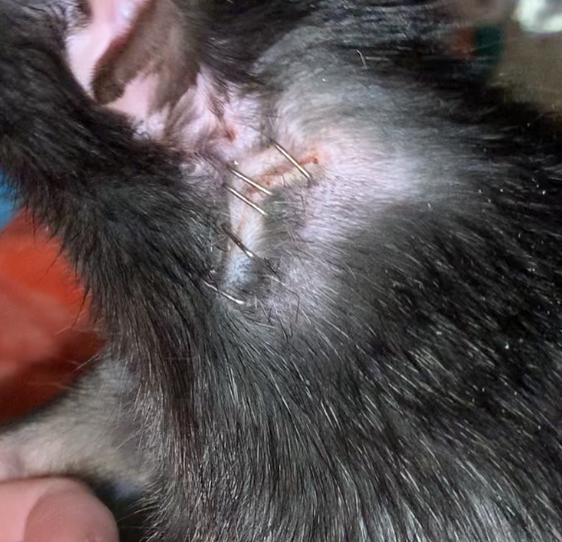
Day 5
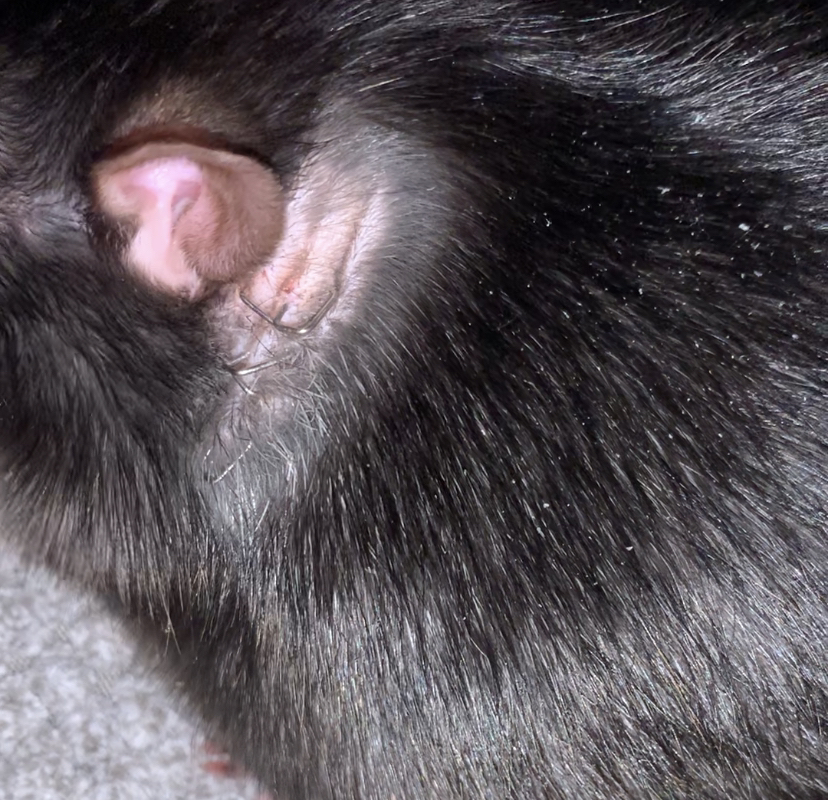
Day 8
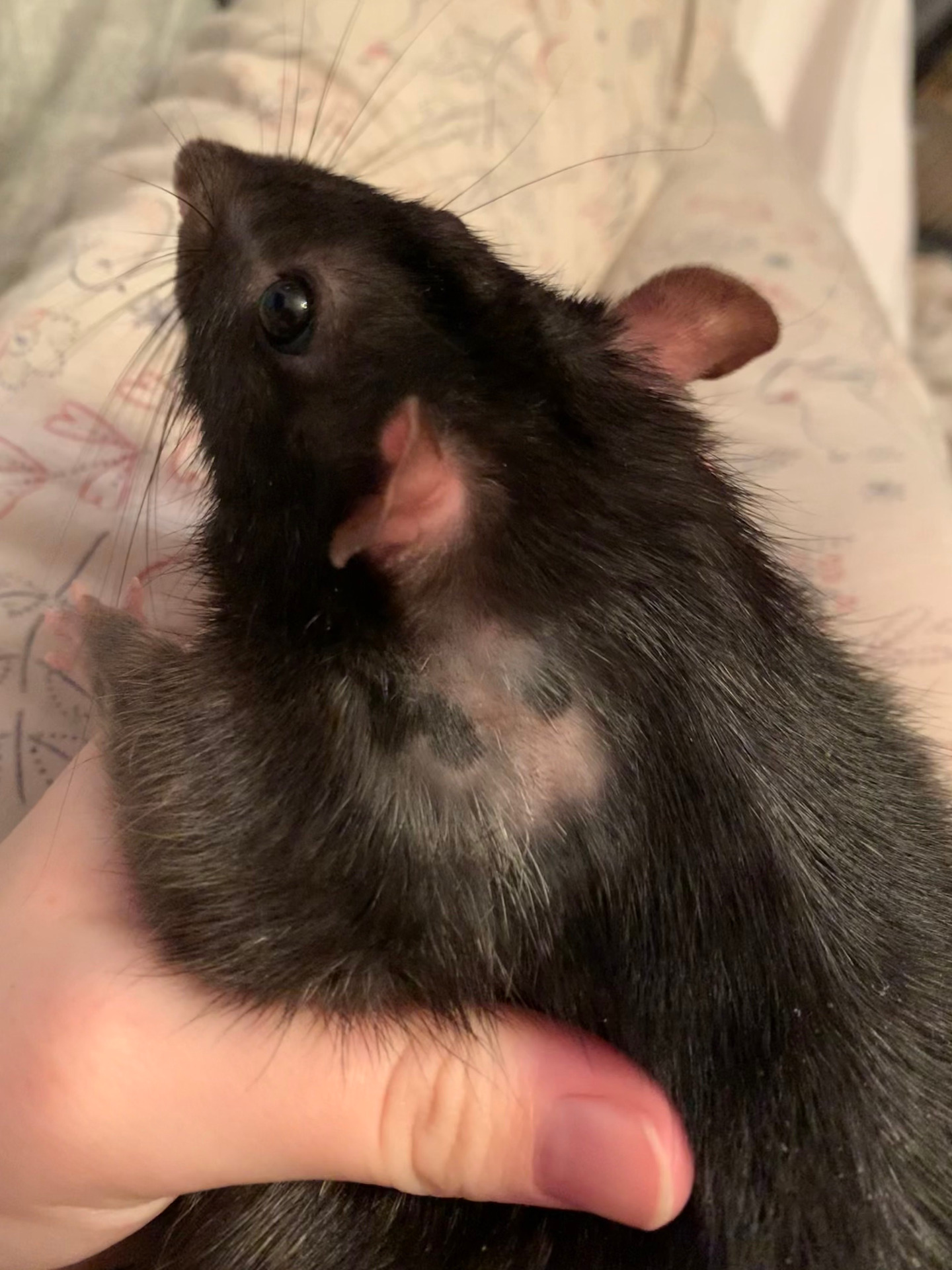
Removal occurred 10d post-bite
Also known as ulcerative pododermatitis, this is most commonly seen with rodents housed on wire floors (which is why it is not recommended to house your rats on any form of wire flooring). Due to the harshness of wire floors on the feet of rats, wounds result. These wounds can then become irritated by contaminants such as faecal matter and bacteria, resulting in infection. The constant exposure the bottoms of their feet have to their environment causes wounds to repeatedly break open even after scabbing over, resulting in painful lesions. Bumblefoot must be treated. If left untreated, infection can result in the amputation of the foot, sepsis, and eventually, death.
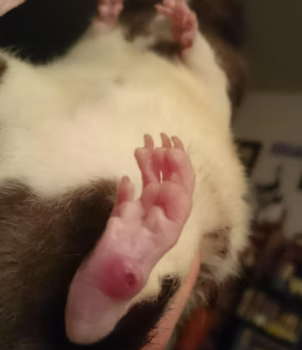
A mild case of bumblefoot that can be treated at home
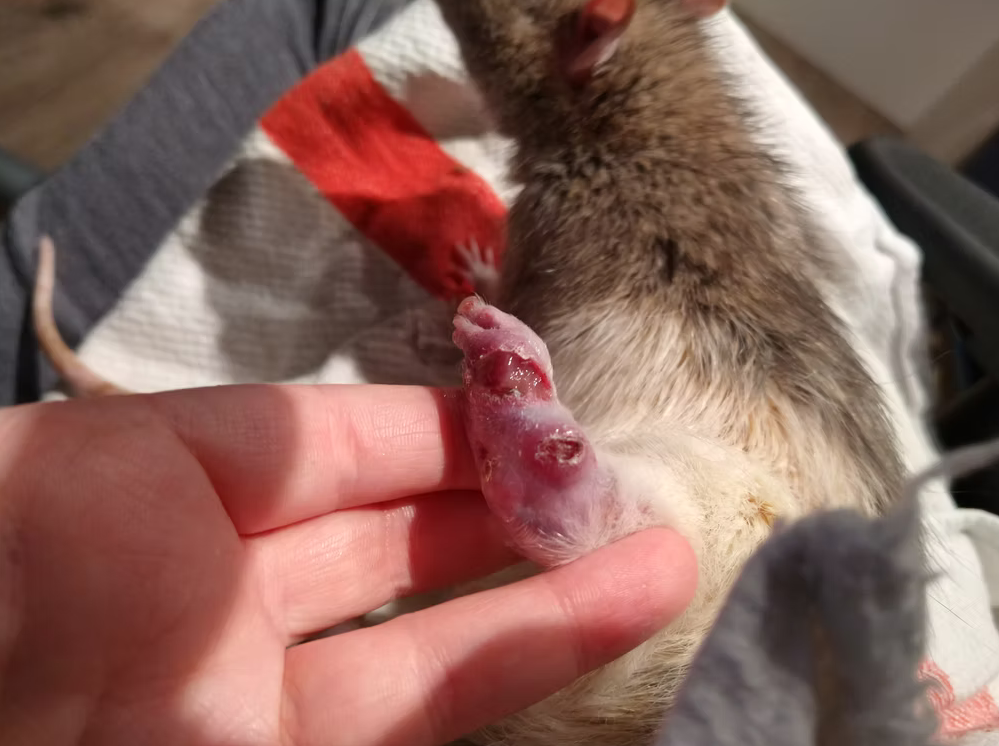
A foot at risk of amputation due to the severity of skin lesions.
When caught early on, this can be easily treated at home by cleaning the affected area with hibiscrub or betadine solution once a day followed by the application of antiseptic cream twice daily. The cage should be thoroughly disinfected and inspected to identify any potential sources of where the rat could have received a cut from.
A veterinarian should be seen if:
Most commonly seen on tails due to their length and size, degloving is the result of the top layers of skin being separated from the connecting tissues and muscle underneath. This is often the result of trauma to the tail, such as it being caught between a cage door or being torn by another animal. Severe tissue damage, bleeding, and the exposure of the tailbone can be present. This can lead to necrotic tissue spreading past the injury, infection, and self mutilation due to discomfort. Veterinary treatment must be sought to prevent this. For moderate injuries that are not actively bleeding, a vet should be seen within the next 24 hours. However, for severe injuries, an emergency visit should occur immediately. Typically, this injury has a good prognosis, especially if it is only a small portion of the tail affected.
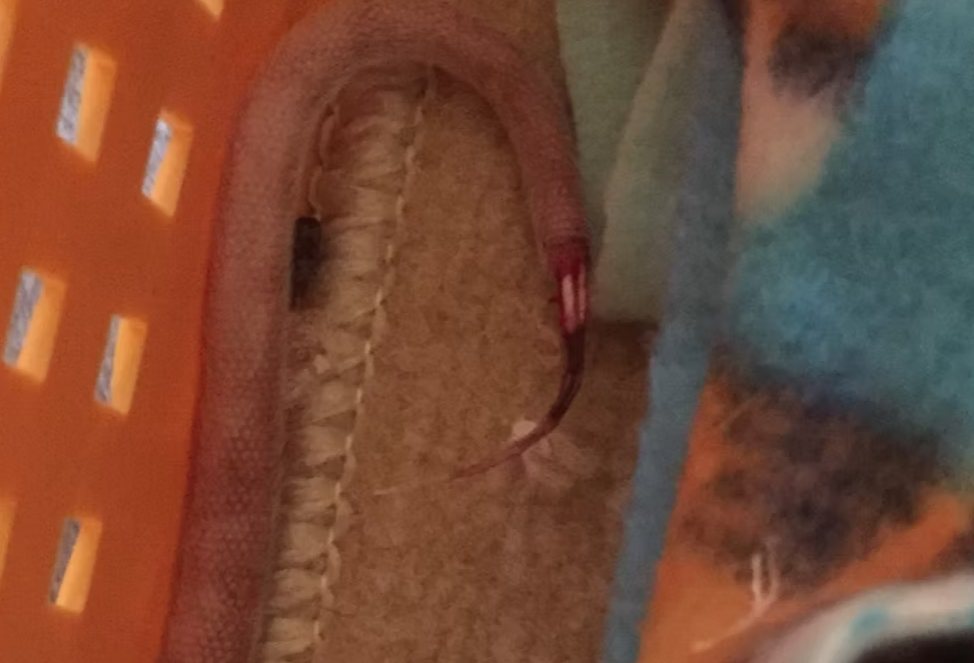
Relatively fresh moderate injurty. Injuries like this should be seen by a vet for an amputation.
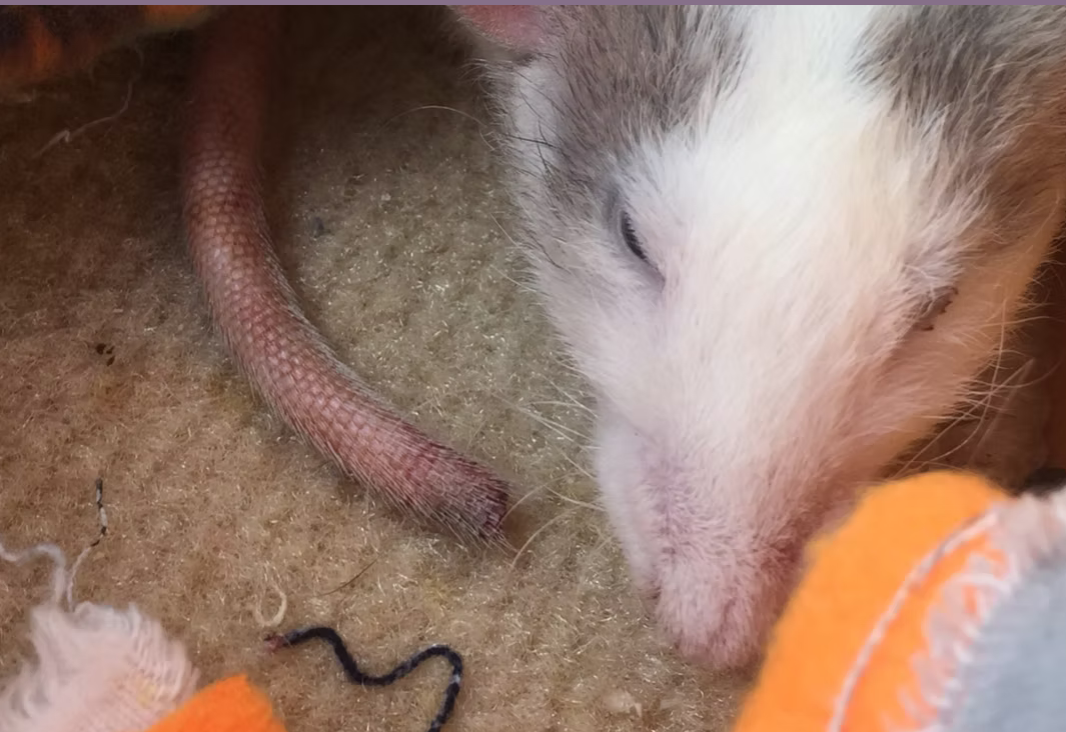
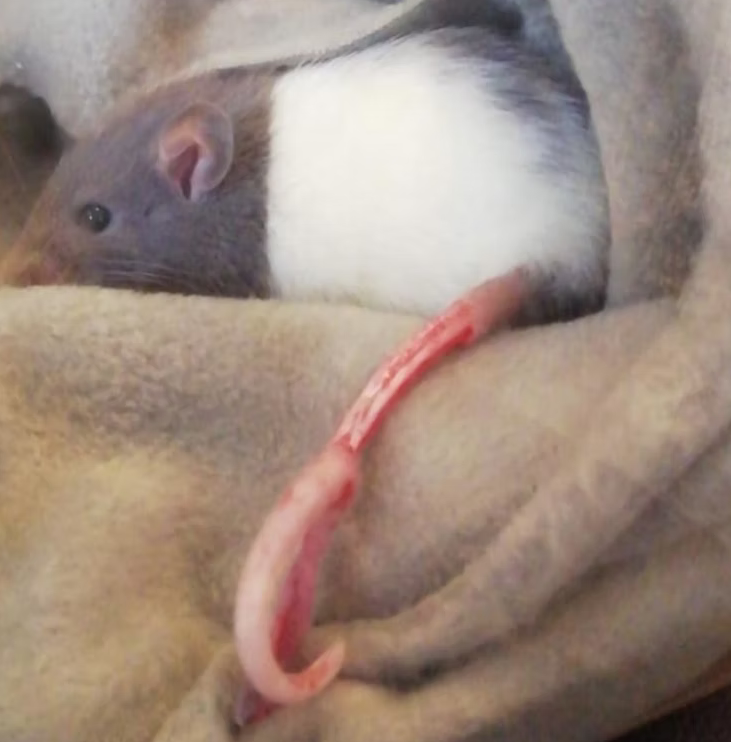
Severe degloving case that needs immediate veterinary intervention (Credit: Silver's Rattery - Medical Library)
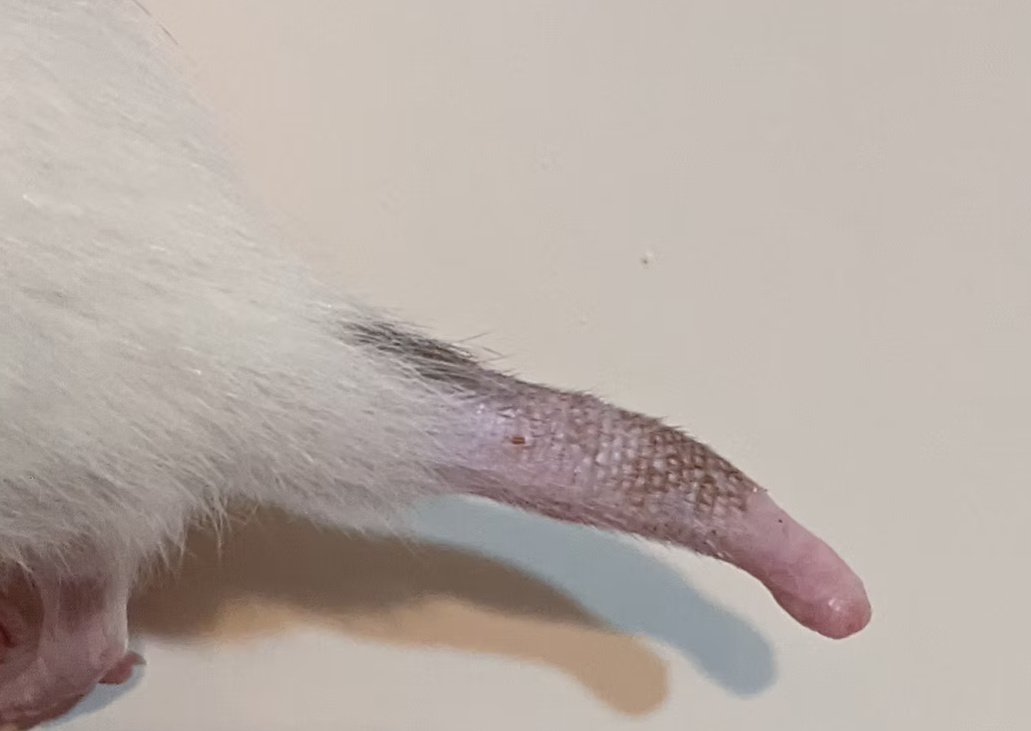
Healed result following amputation. Most of the tail has been removed due to severity of incident (Credit: Silver's Rattery - Medical Library)
Just like humans, rats have the potential to develop dermatitis. Often associated with an overgrowth of the skin-dwelling bacteria Staphylococcus aureus, the condition is characterised by dry, flaky skin that is often itchy. Scabbing, balding, and excessive itching can also be seen in rats with dermatitis. This is often caused by protein sensitivities and allergic reactions, and is most commonly seen in Harley rats when given diets high in protein.
Treatment involves:a) ruling out ectoparasites such as lice and mites, b) identifying potential sources of sensitivities to certain foods, and c) cleaning of irritated or wounded area with saline or hibiscrub. For more severe cases, seeking a veterinarian’s advice during a routine appointment is advised. Ensuring that the rat’s nails are trimmed frequently to prevent further skin damage and promote healing has also been proven to be exceptionally beneficial in addition to topical treatments.
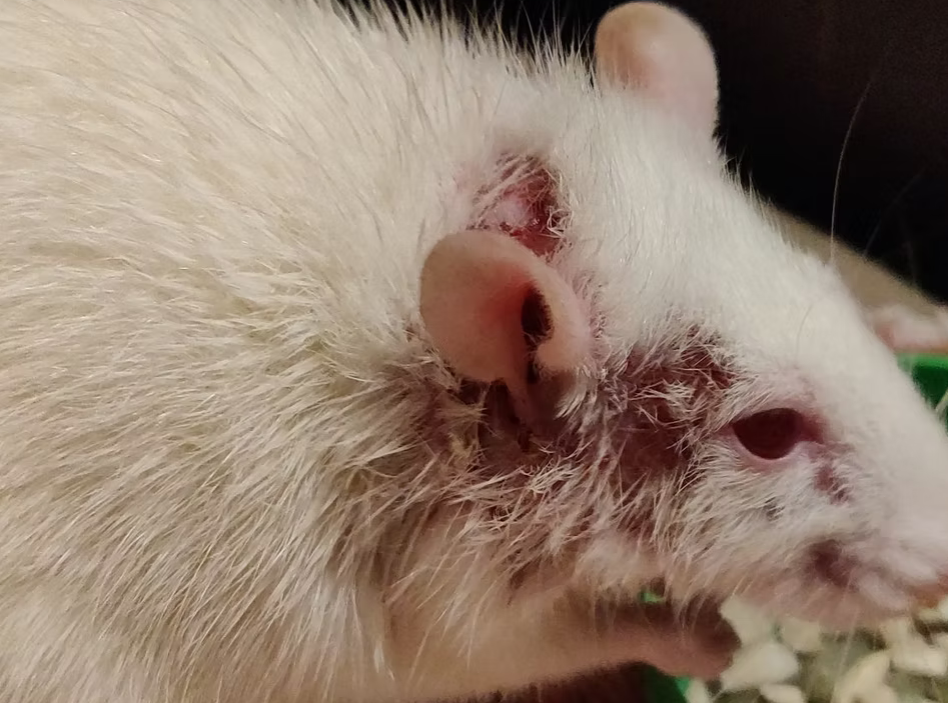
Credit: Silver's Rattery - Medical Library
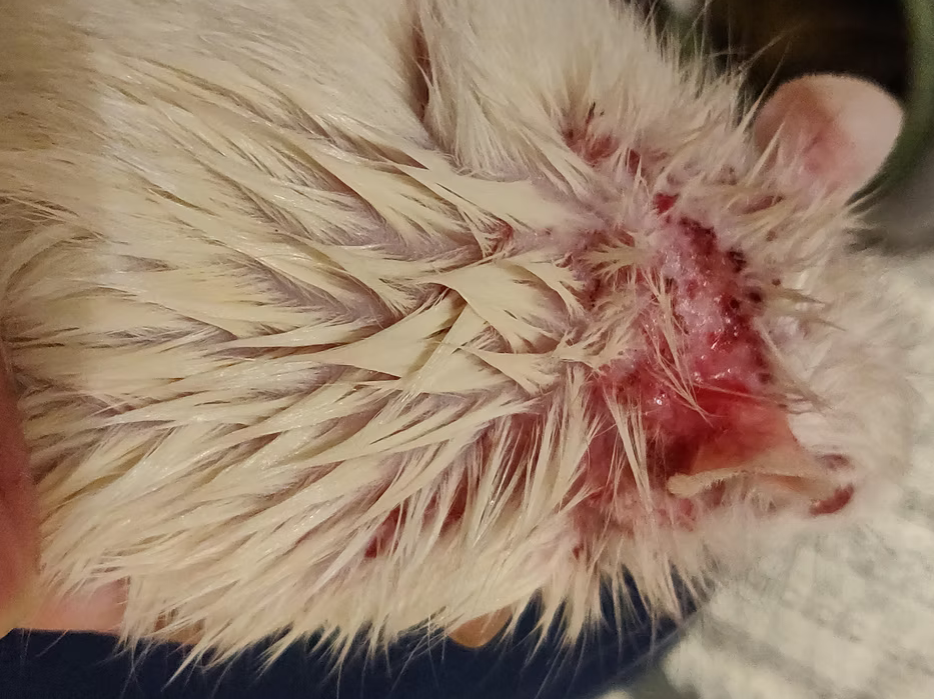
Closer look at the untreated dermatitis, following application of saline
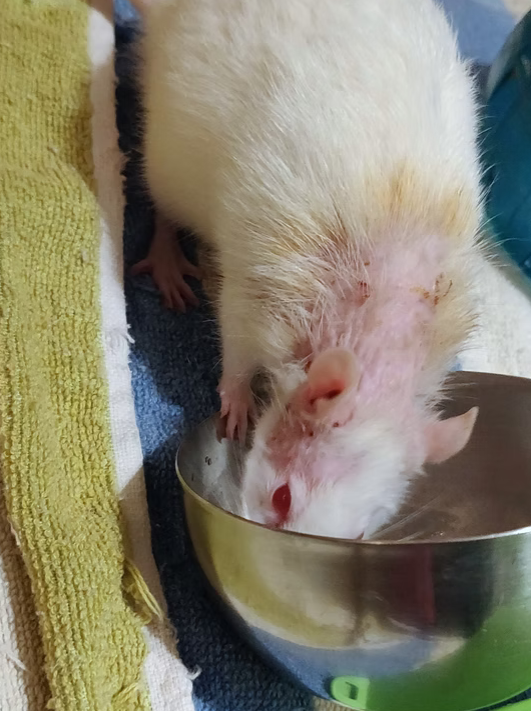
After one week of treatment, the skin has improved. Fur will take time to grow back
Gangrene is exceptionally rare, but has been observed once in a rat following being bit. Occurring as a result of a lack of blood flow to tissue or secondary to an infection, tissue becomes necrotic and begins to slough off. If not treated, the condition is fatal. In the case observed, gangrene developed on the arm. An initial wound was very small, but caused more damage under the skin than originally expected. Rat began to favour the uninjured paw over the next few days as the injured arm started swelling, and grip strength was impeded. Medication provided temporary improvement of the swelling, but the rat began itching and biting at the wound site. The following day, massive scabbing was found underneath the fur on the arm, and an emergency vet visit was prompted. Tissue on the arm was found to be gangrenous and surgery was required to debride the area of necrotic tissue. The rat thankfully made a full recovery and had no mobility issues following.
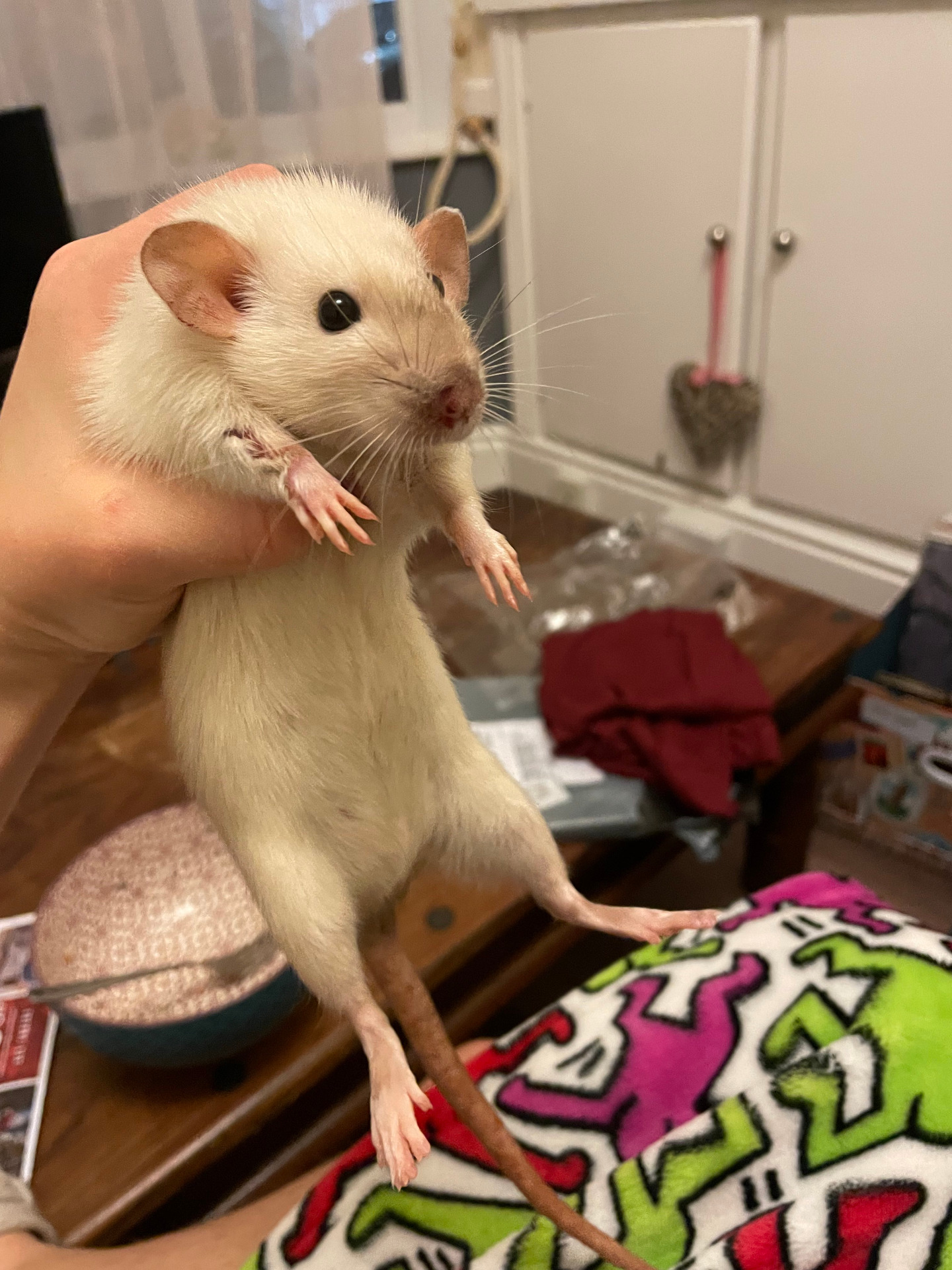
Lesion started small on the right arm
Credit: @antares_anta on Discord
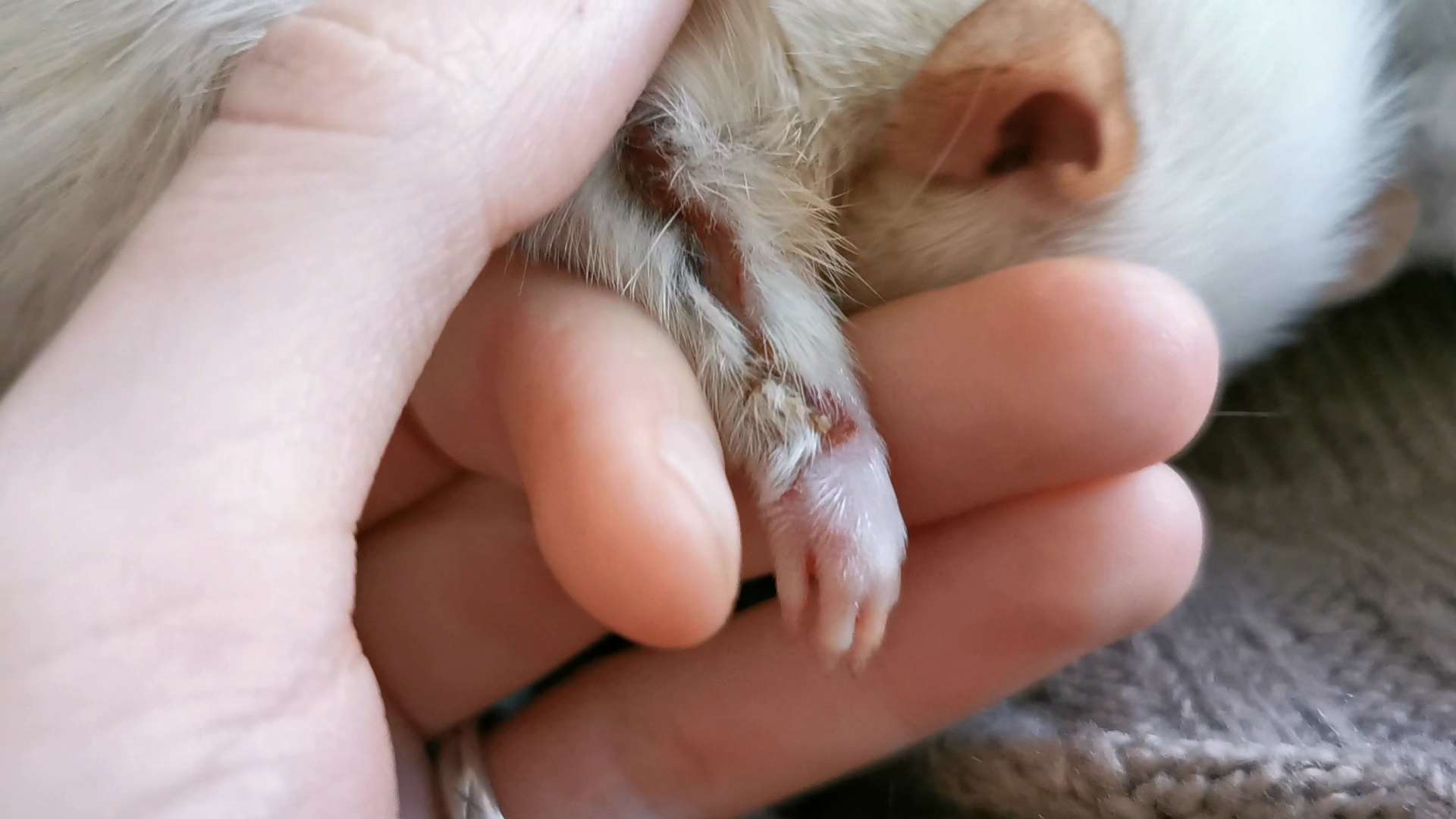
Rat began to bite at area, causing further damage
Credit: @antares_anta on Discord
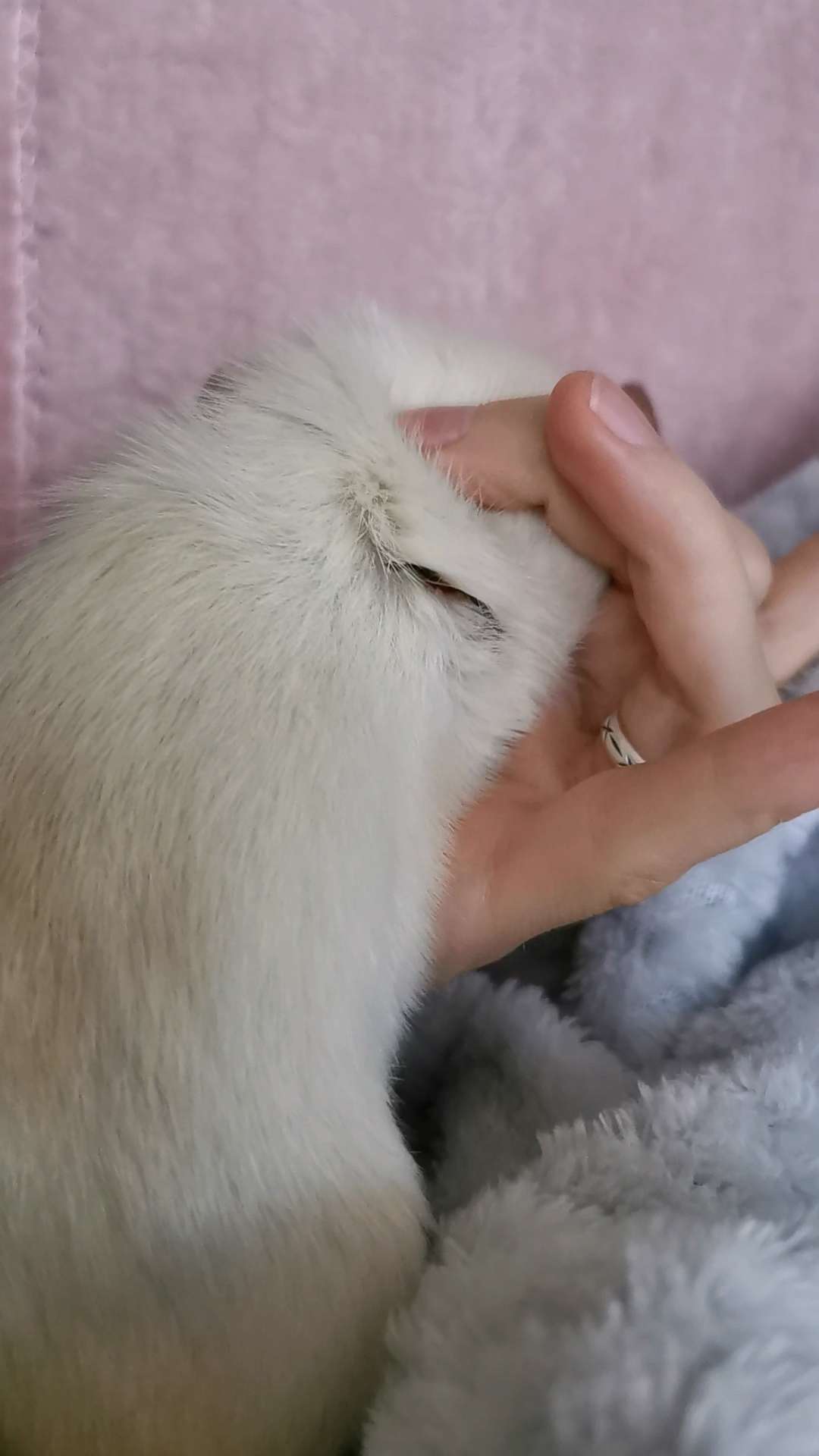
Gangrene spread up the arm to the apex of the shoulder blade
Credit: @antares_anta on Discord
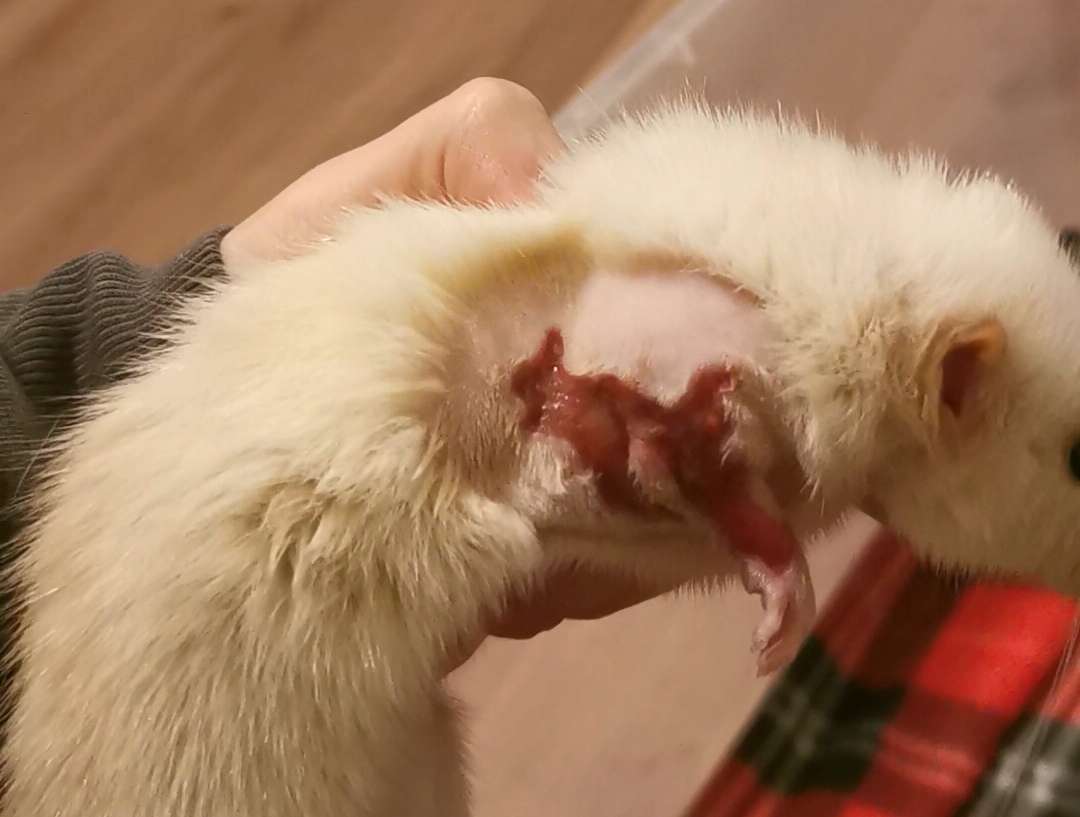
Necrotic tissue was surgically debrided
Credit: @antares_anta on Discord
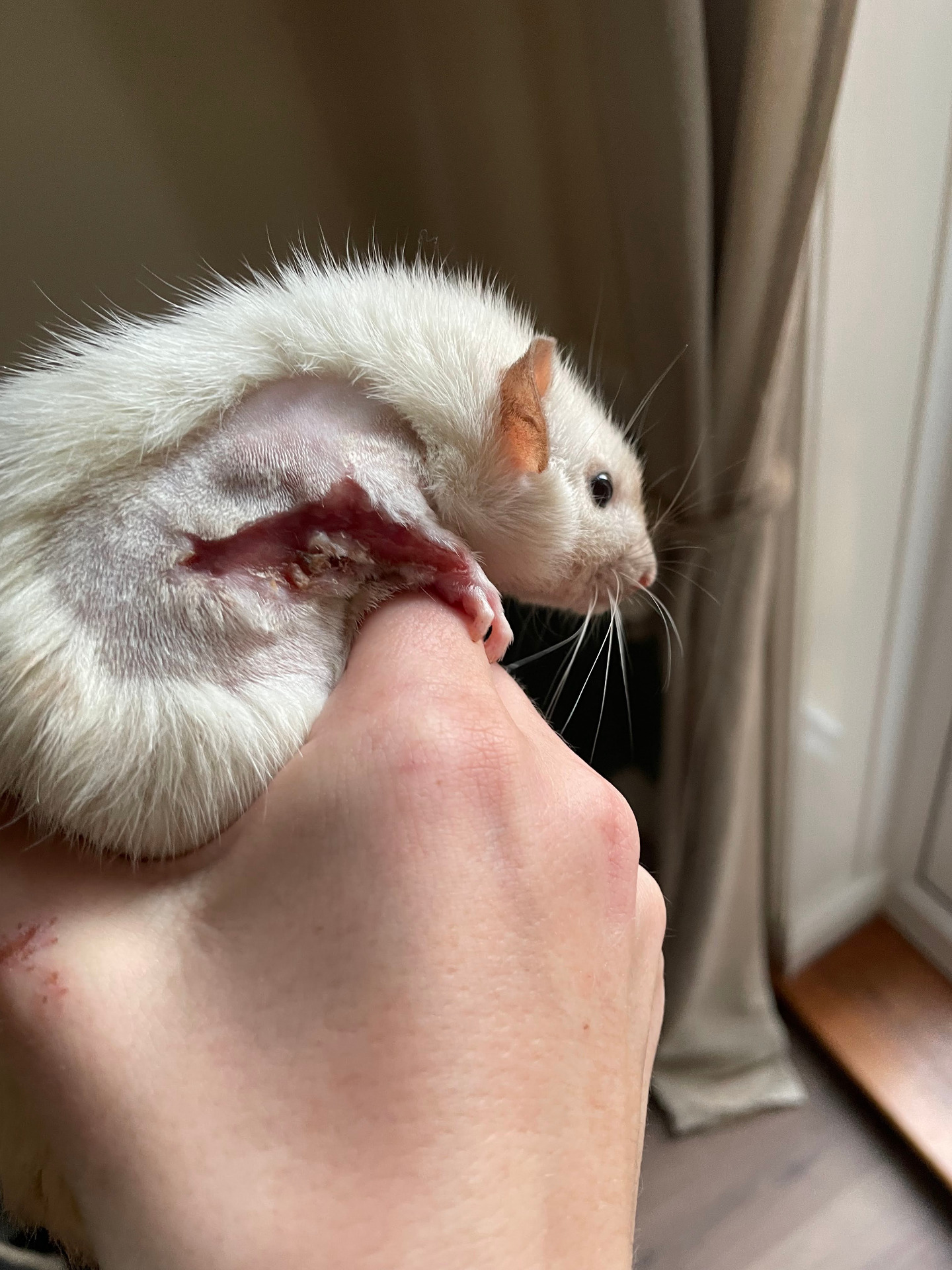
1 day post surgical debridement
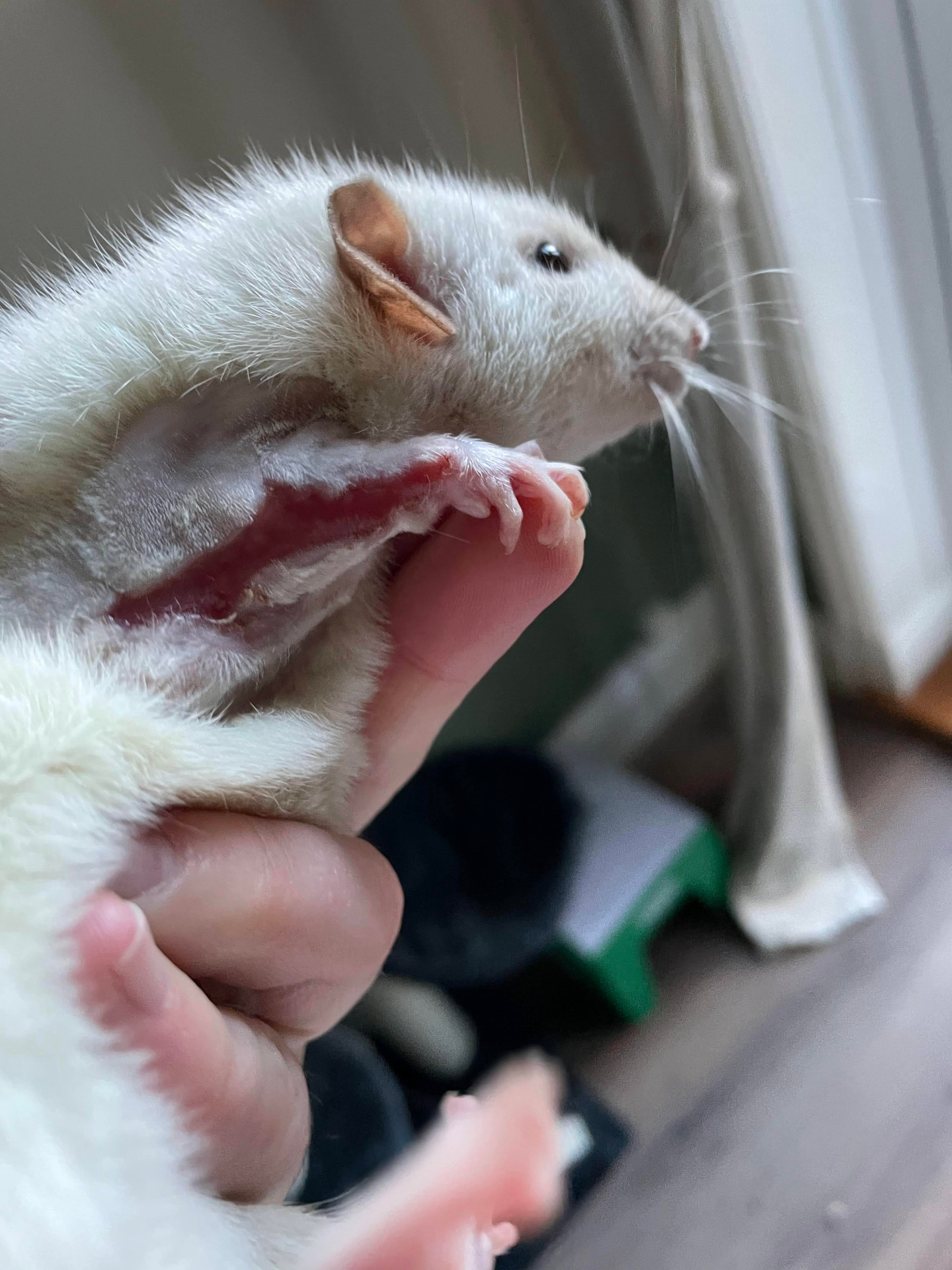
Wound site healed relatively quickly and began to scab ~48h after surgical intervention
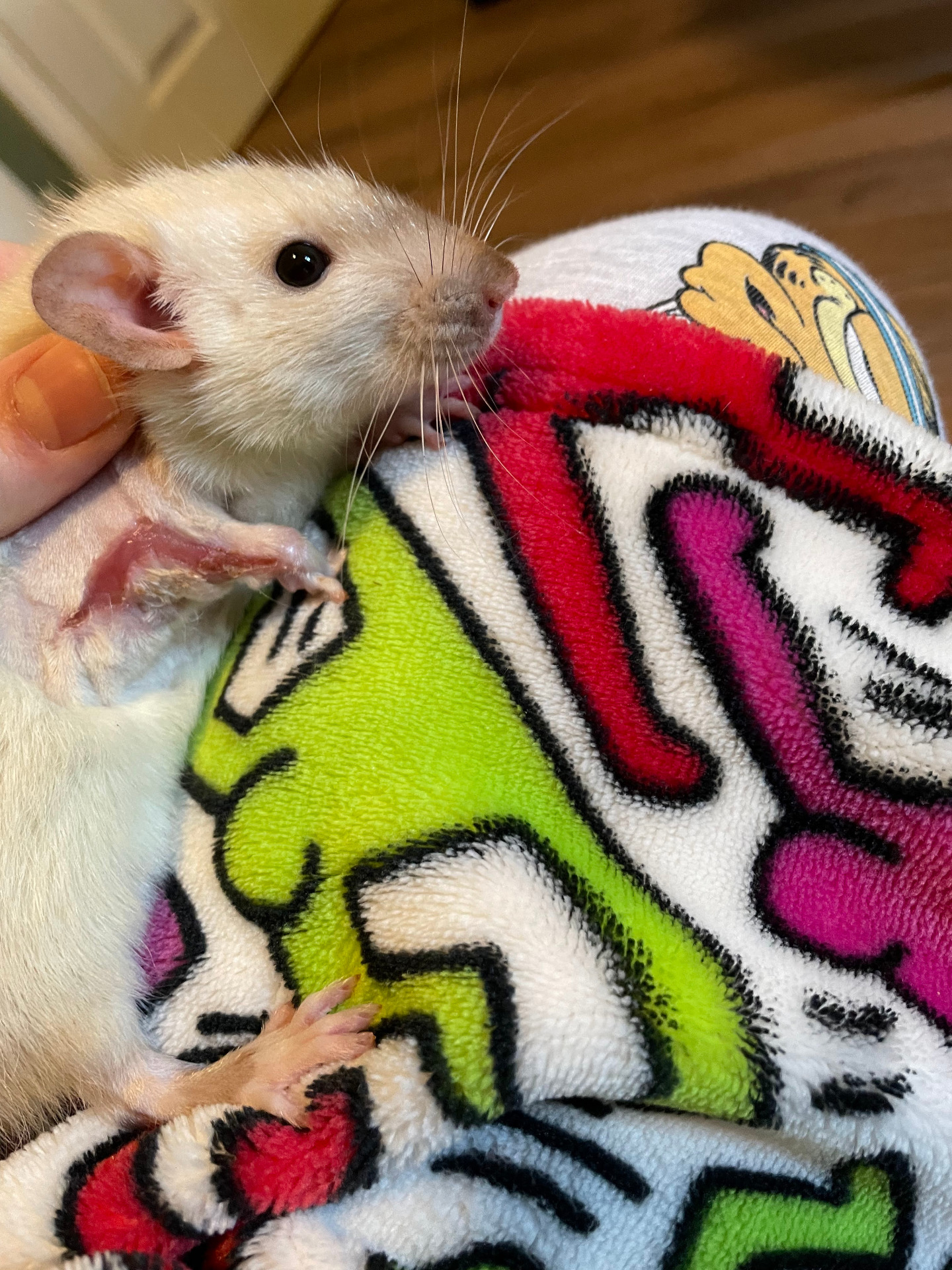
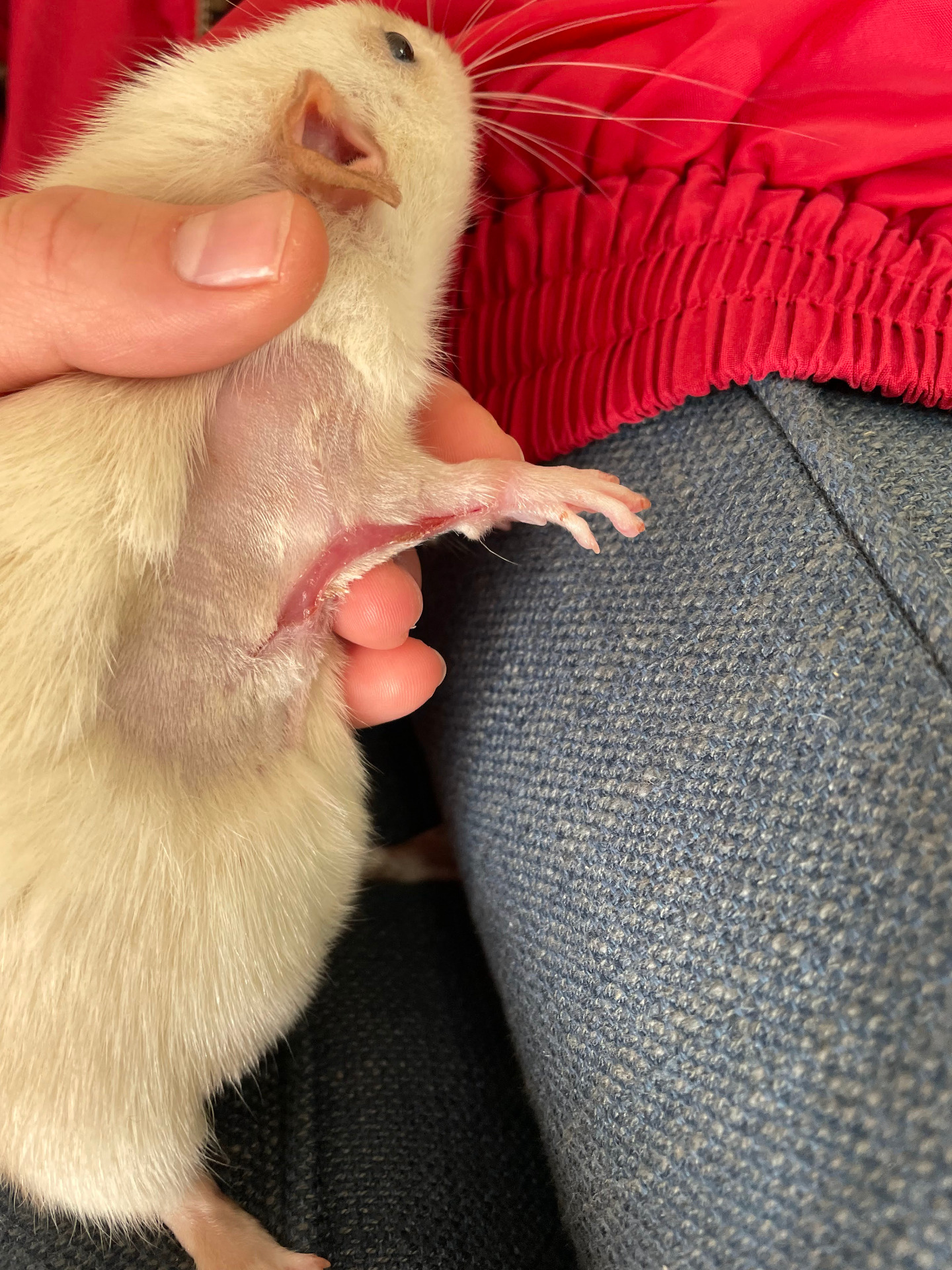
One week following surgical intervention
Unfortunately, tumours are exceptionally common in rodents. Cancers typically seen:
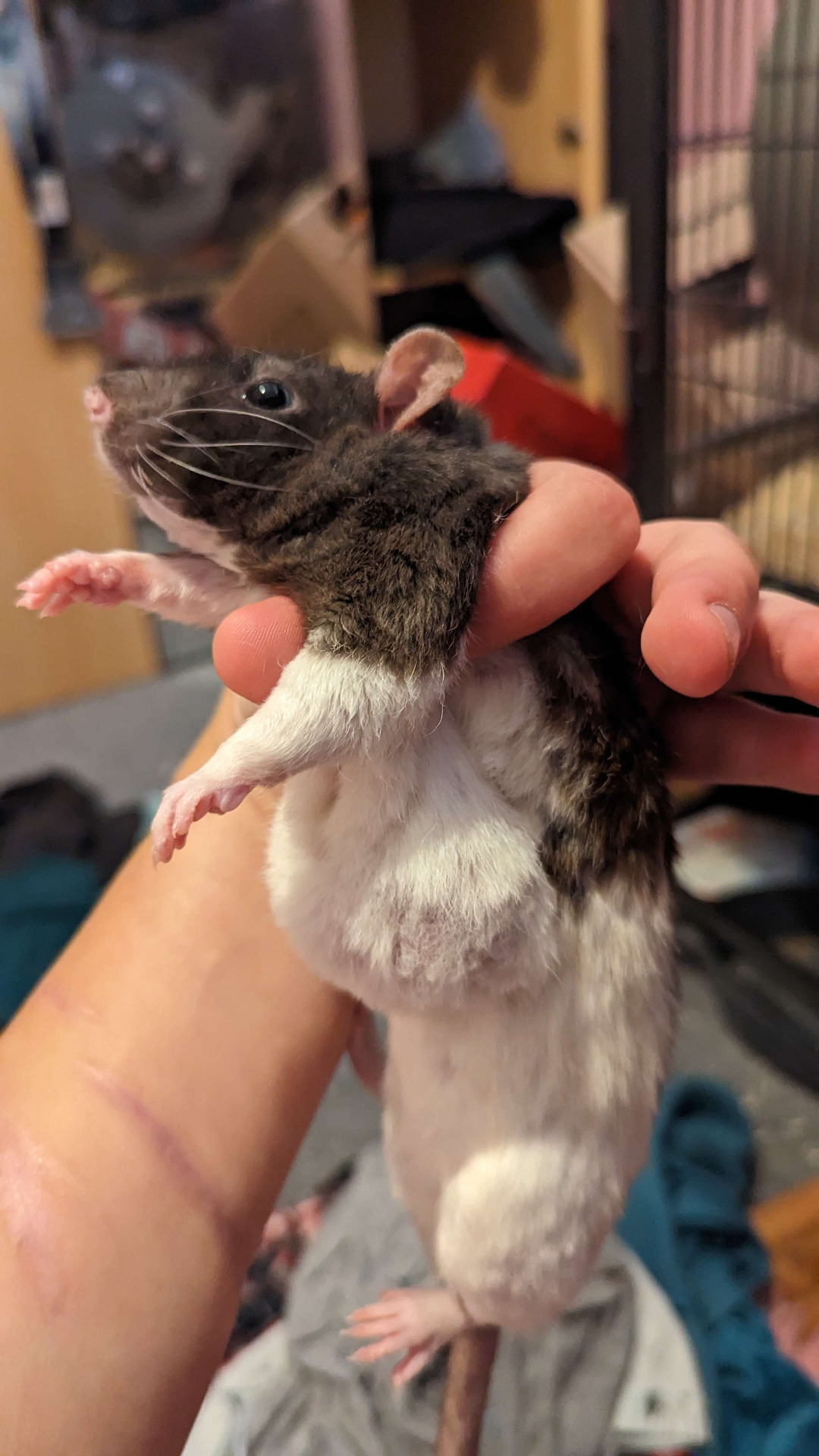
Credit: @gillian_anderson on Discord
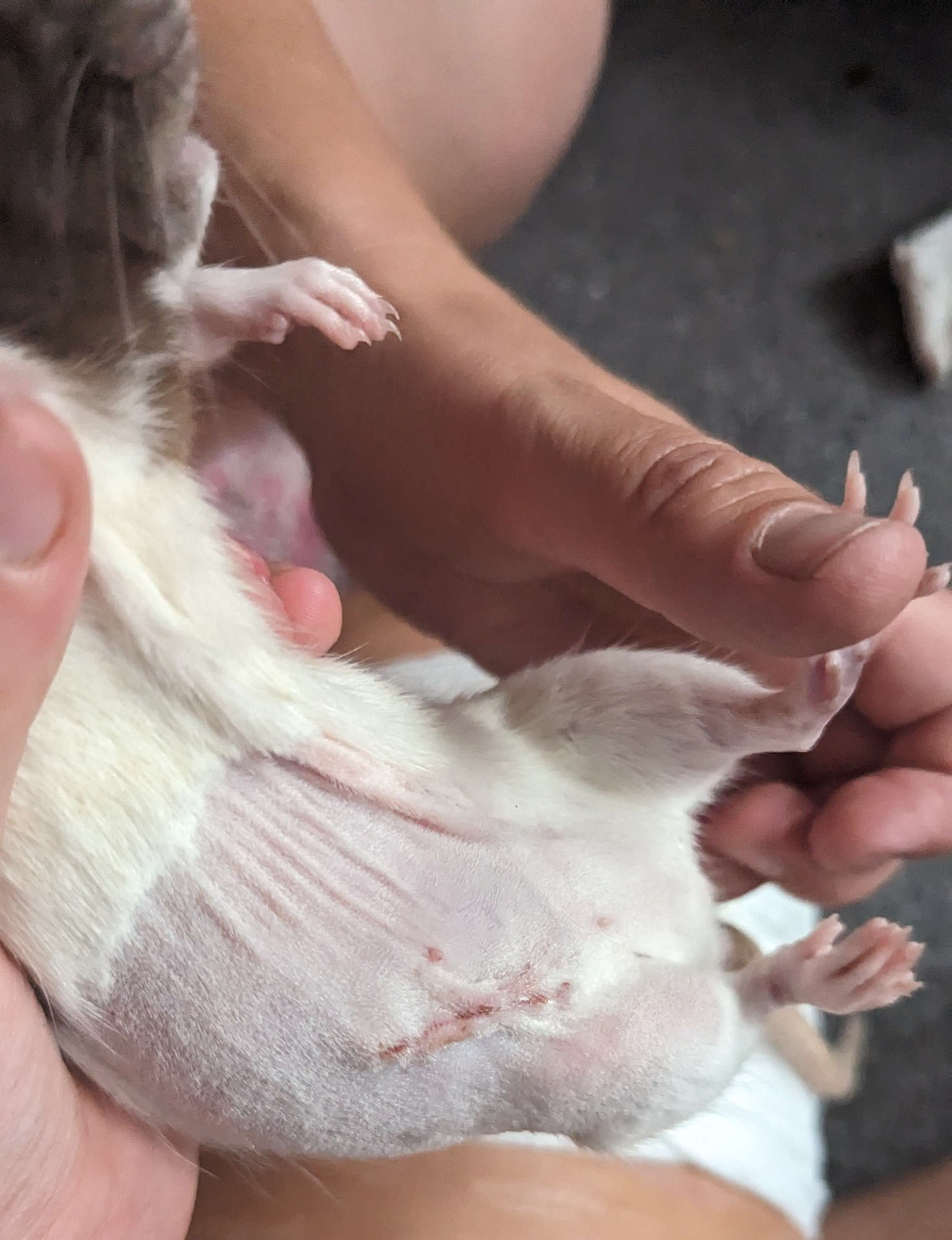
The tumour was removed and healed successfully

Credit: @klaidon on Discord
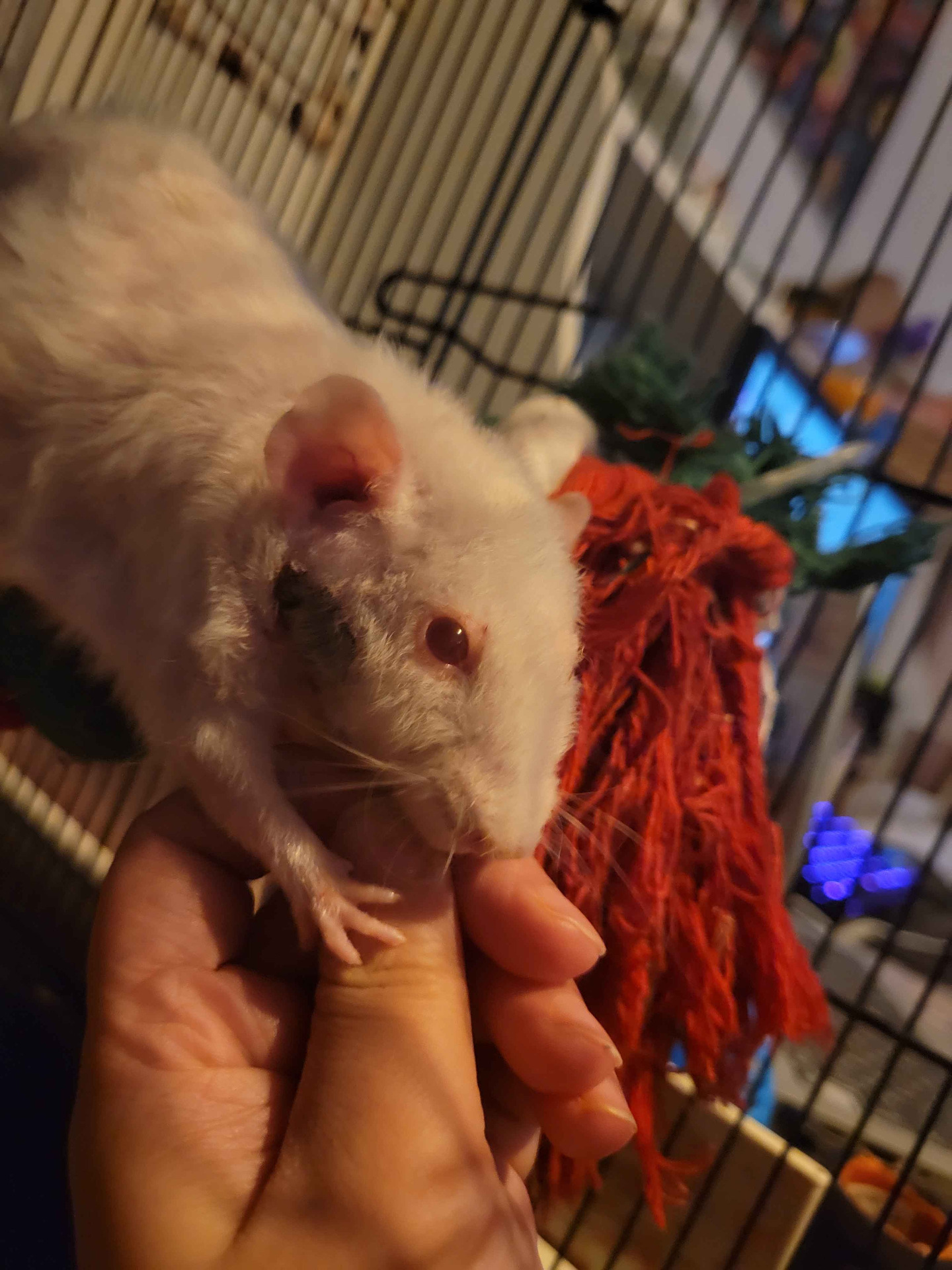
Credit: @klaidon on Discord
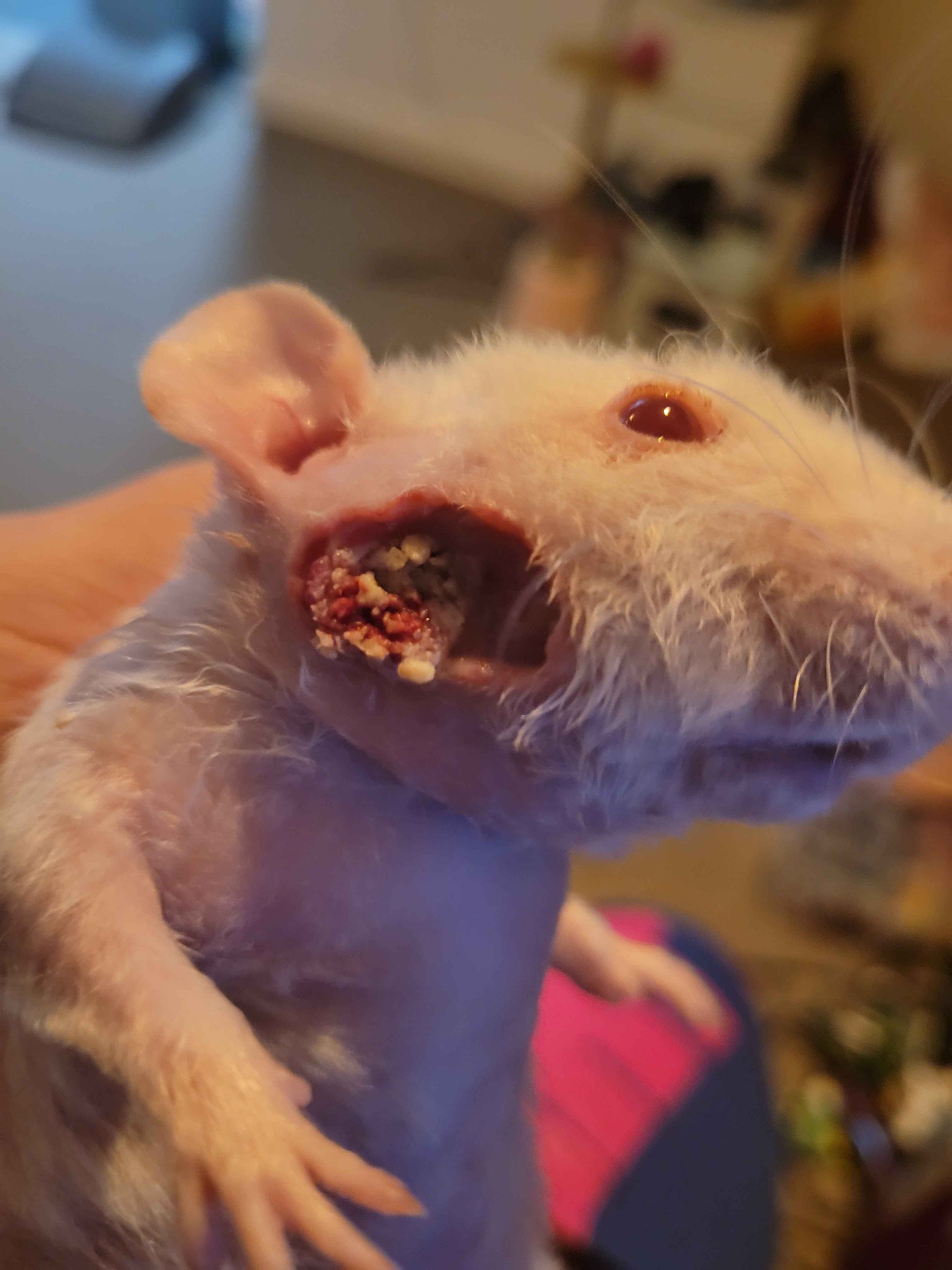
Severe lesion showing bone erosion as a result of ZGT
Credit: @klaidon on Discord
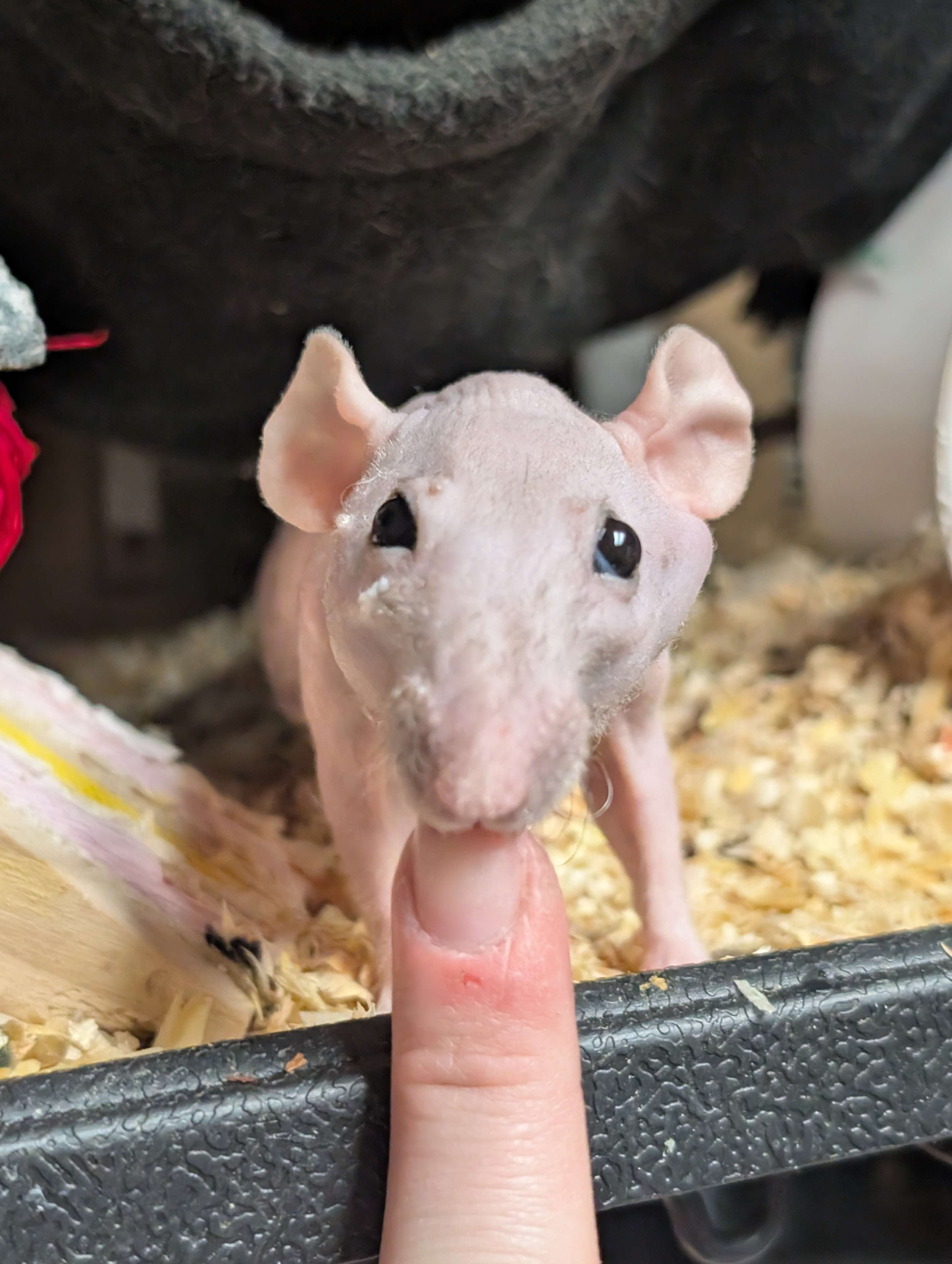
Pressure of the ZGT caused the left eye to bulge out of its socket. Credit: @jennah181 on Discord
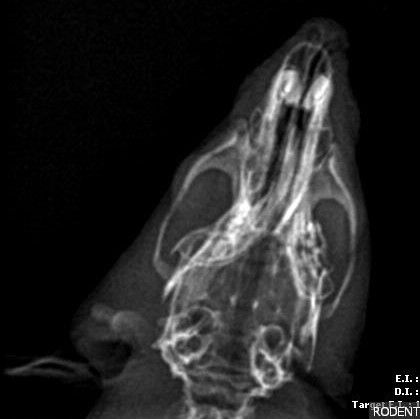
ZGT on the left side of the rat, with weakening of bone structure present. Credit: @jennah181 on Discord
Ectoparasites are found externally on the host within or on the skin and are a main cause of dermatological conditions in rodents. These are typically caused by mites (Radfordia ensifera), and to a lesser extent lice (Polyplax spinulosa). All ectoparasites cause excessive itching, balding, and scab formation.
Radfordia ensifera - The rat fur mite
Naturally-occurring on all rats, these mites typically are of no concern. Found on the interscapular and dorsal-cervical regions, clinical signs are not typically observed unless there is a heavy infestation. Heavy infestations occur when the host becomes immunocompromised
The most common clinical signs are excess scratching and grooming accompanied by tiny, pinpoint scabs on the shoulders/face/behind the ears. Cases resolve within a week following administration of a topical antiparasitic drug such as ivermectin or selamectin.
Polyplax spinulosa - Rat Louse
All species of mammals have a species-specific louse counterpart. This is a sucking louse, and feeds on the blood of rats. Typically found in the midbody, shoulders, and neck regions of the host. Symptoms are similar to that of mite infestation, with the only difference being that lice are VISIBLE. Treatment includes administration of a topical antiparasitic drug (typically selamectin or ivermectin) and removal of lice and nits with a flea comb. Please note: there is NO concern of you getting a louse infestation by handling pet rats with lice, as they only feed on rats.
Ctenocephalides felis/canis - Dog/Cat Flea
While VERY rarely found in rat-only households due to the fact that rats have no outdoor exposure, cat and dog fleas can arise in cases when other furred mammals have been in the home. Fleas are exceptionally difficult to miss, and are characterised by their brown exoskeleton and thick cuticle. Flea infestations can be difficult to control at first but are easily managed with regular flea-combing and administration of ivermectin/selamectin.
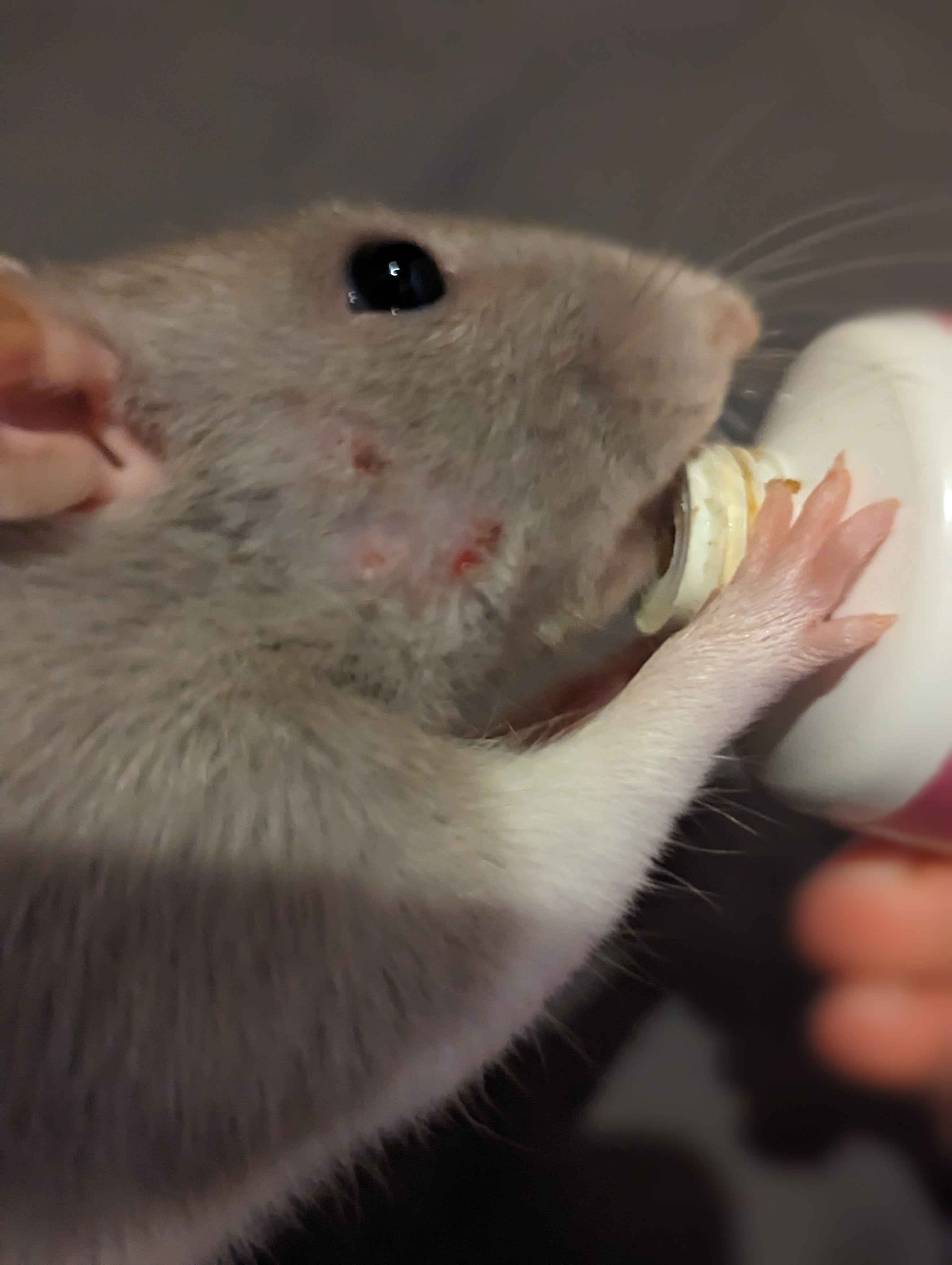
Credit: @dougie_is_cool on Discord
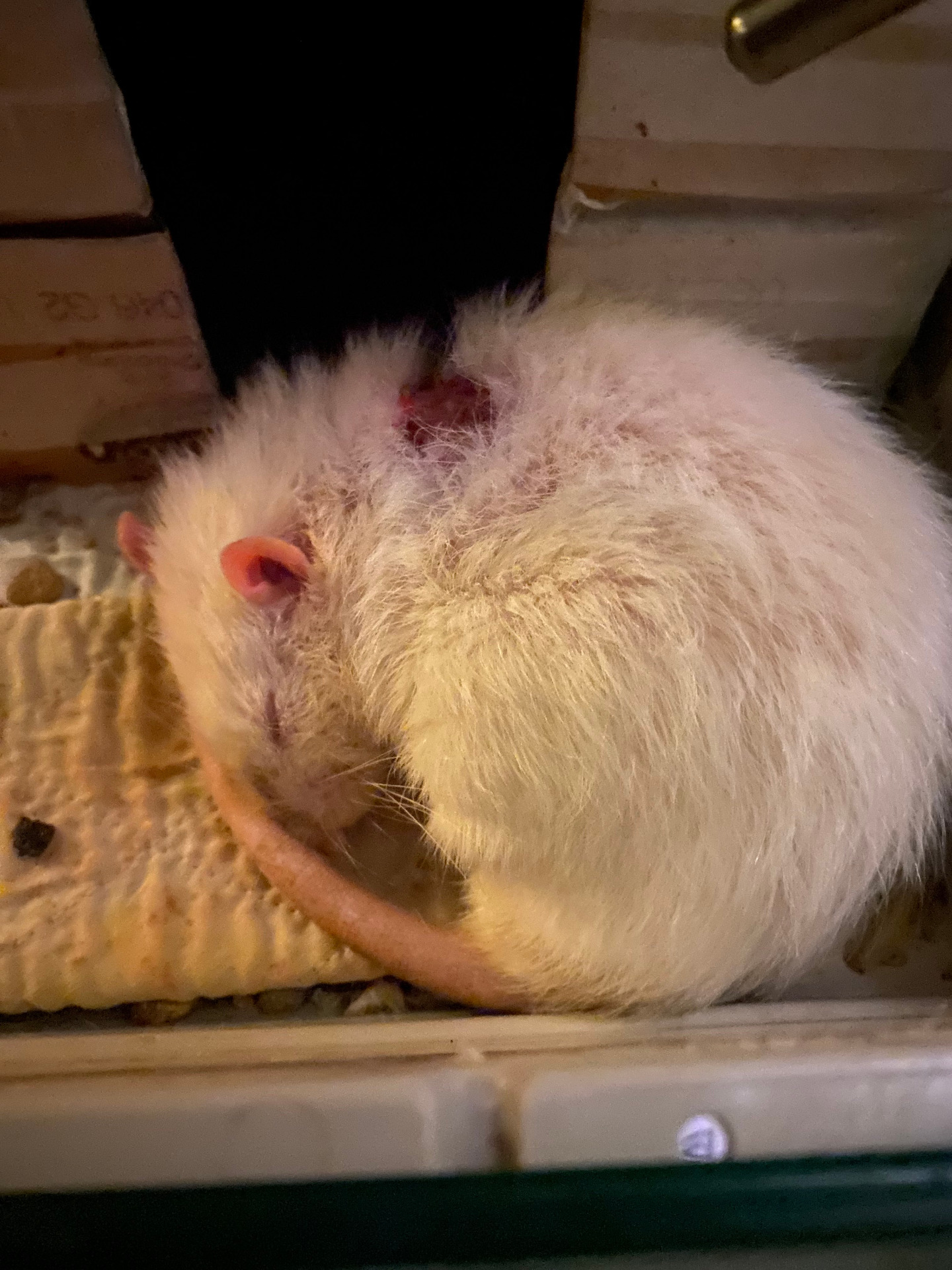
Credit: @imurnumbr1 on Discord
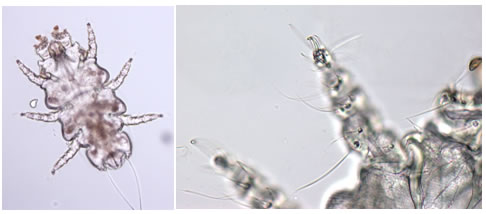
Mites like these are microscopic, and will not be visible to the naked eye
Credit: University of Missouri CVM
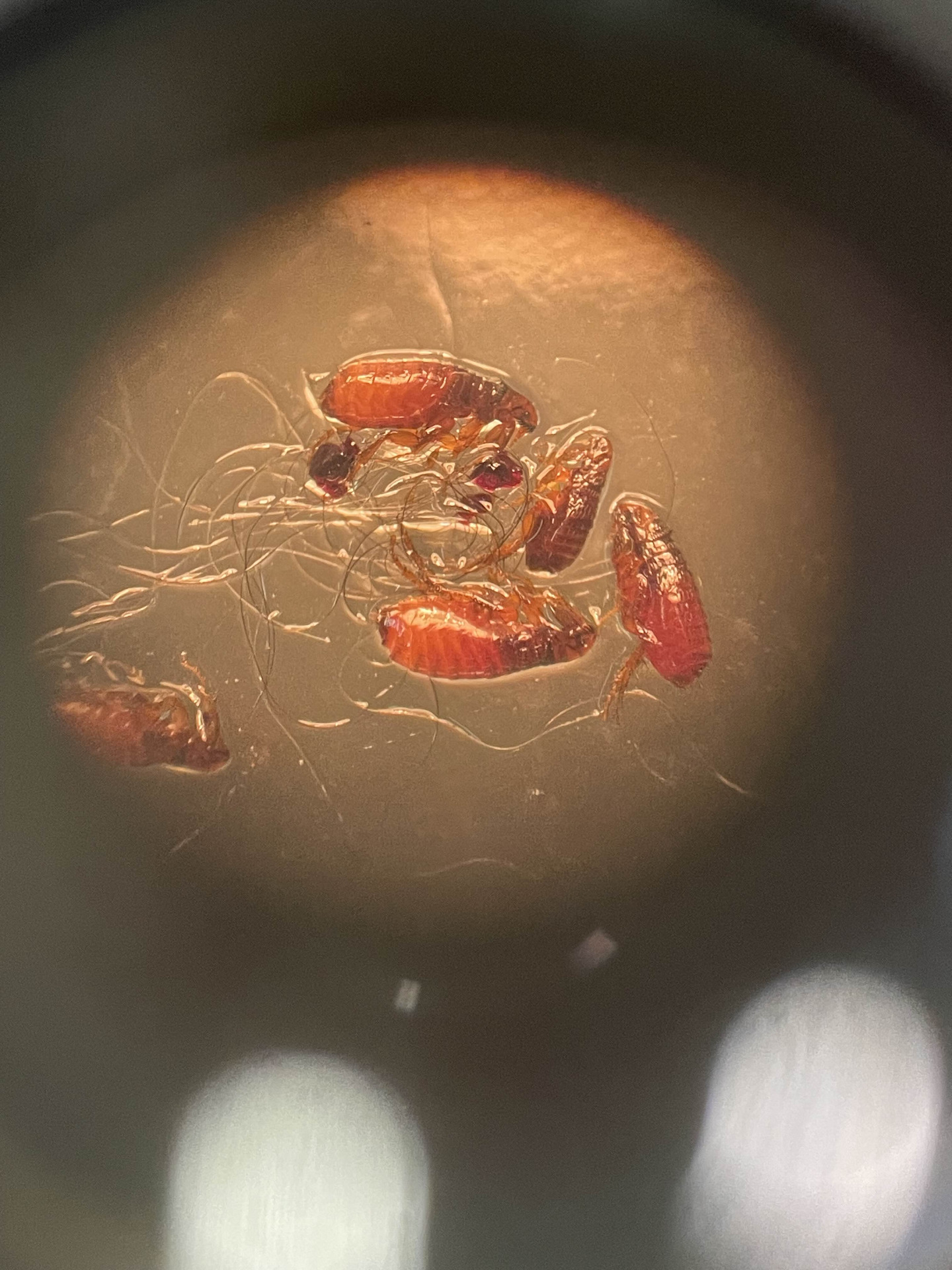
Fleas are roughly the size of a sesame seed when full grown
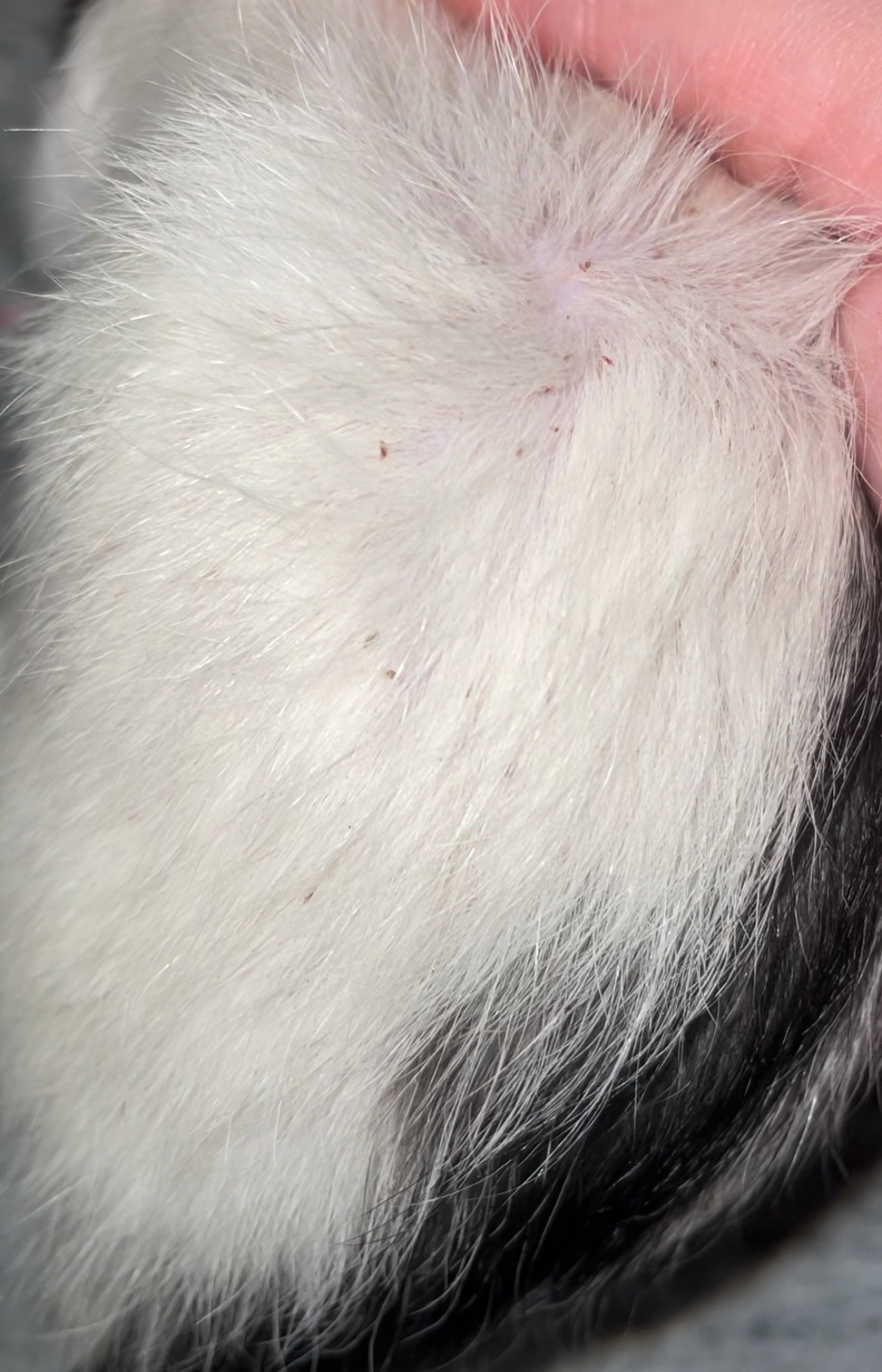
Lice will appear as tiny, moving specks.
Credit: @shinymawile on Discord
An example of a rat louse infestation in the fur of a rat
Credit: @shrewzs on Discord
Ringworm, commonly known as athlete’s foot or jock itch, is caused by fungi such as Microsporum and Trichophyton. Transmitted by direct contact with infected animals, it is characterised by scaly, circular lesions with crusty edges. Hair loss is often accompanied in rats.
Treatment is often oral antifungals prescribed by a veterinarian, as over the counter antifungal creams made for humans are too weak for rats and dangerous if ingested. If ringworm is suspected, all rats within the cage should be treated regardless of showing symptoms, as carriers can be asymptomatic. It is important to maintain proper hygiene when handling rats with ringworm, as it is contagious to both humans and other animals in the household. However, most people have already been exposed to ringworm in their life and do not show symptoms unless they are immunocompromised.
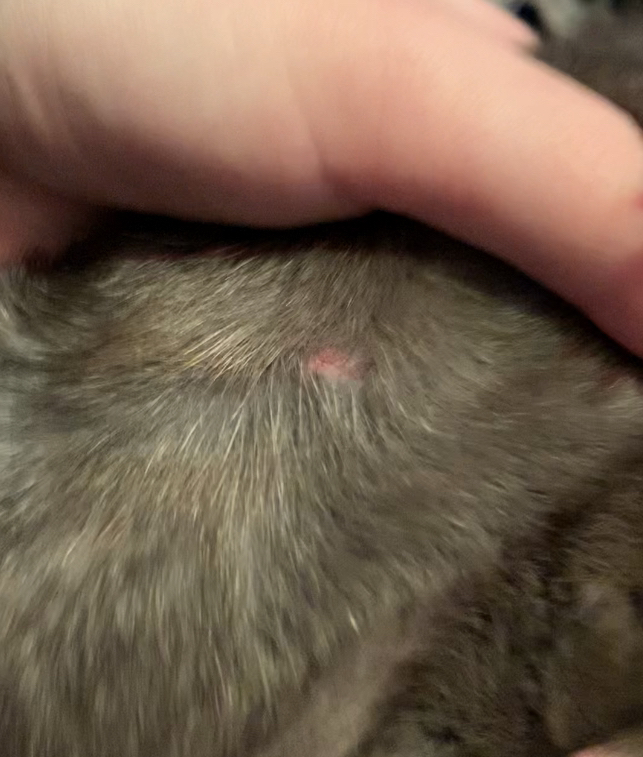
Beginnings of a lesion forming
Credit: @kira.t_ on Discord
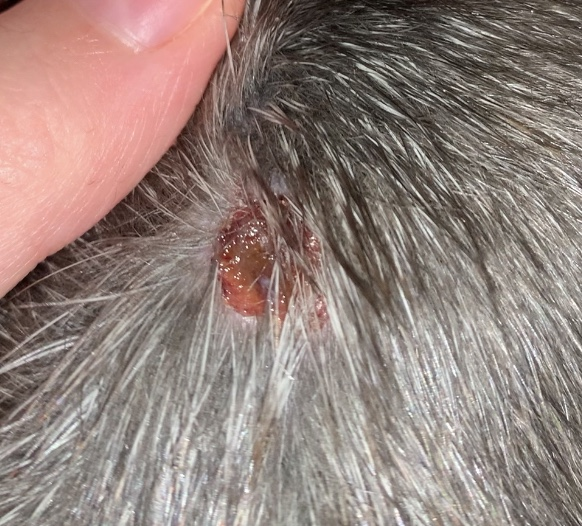
Lesion in need of treatment, as rat has irritated the area
Credit: @kira.t_ on Discord
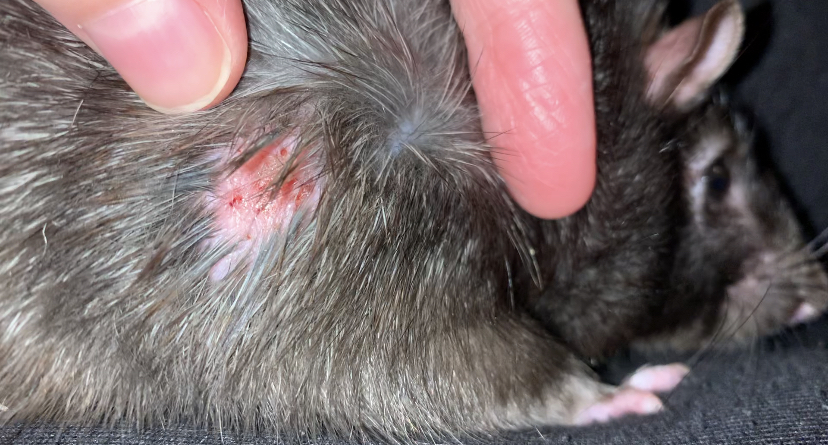
Lesion healing in progress
Credit: @kira.t_ on Discord
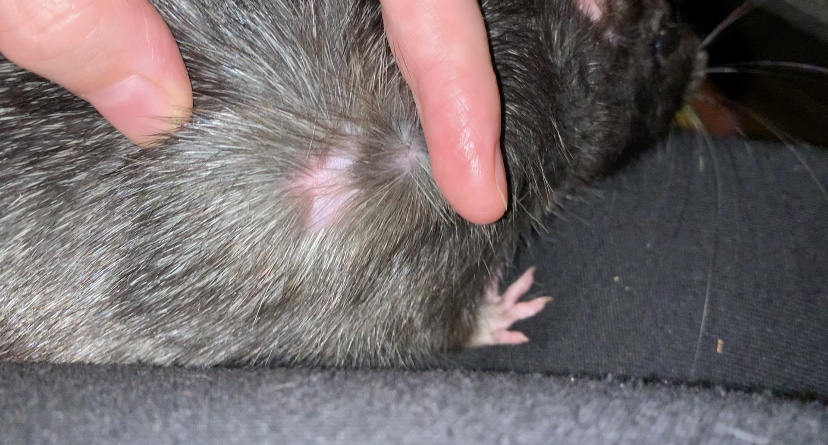
Lesion resolution following application of antifungals
Credit: @kira.t_ on Discord
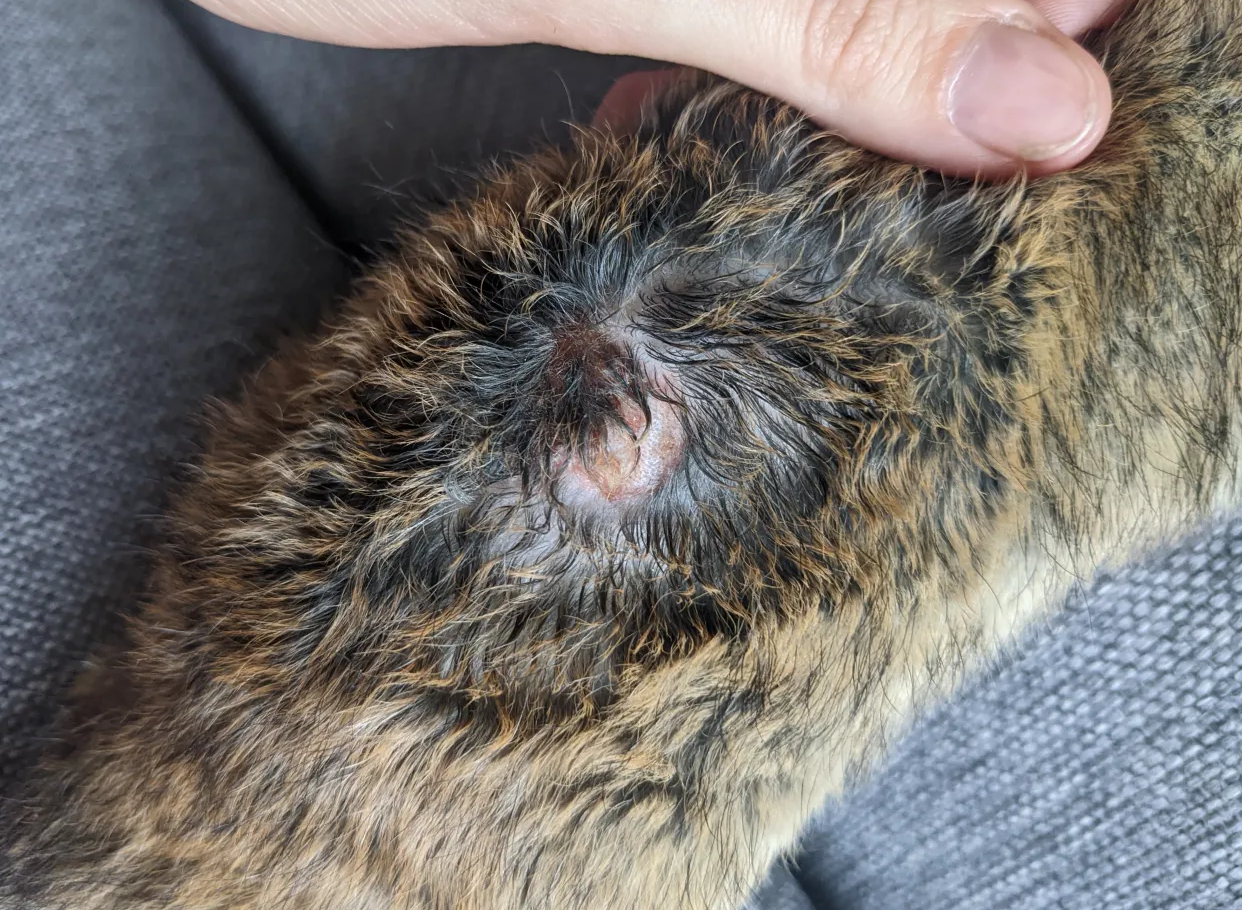
Note crustiness and fur loss
Credit: @auraya_ on Discord
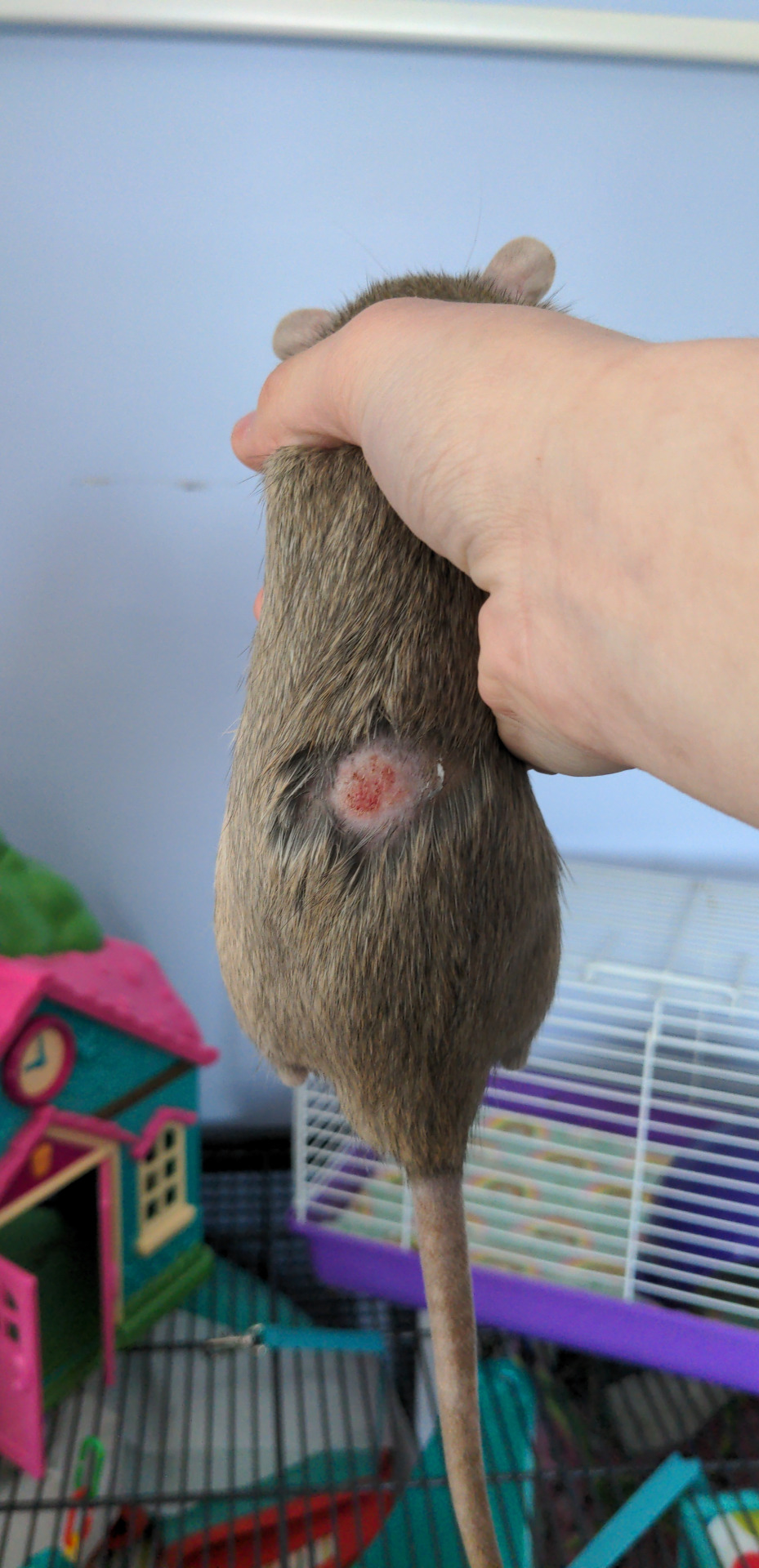
Note redness and scaly appearance coupled with significant hair loss. Credit: @gnat on Discord
Warts are not unheard of in rats, especially as they age. Just like warts in humans, they are typically harmless. Warts will generally resolve on their own over time, but if the rat begins to excessively irritate the area, it is recommended to book a vet visit to prevent infection.
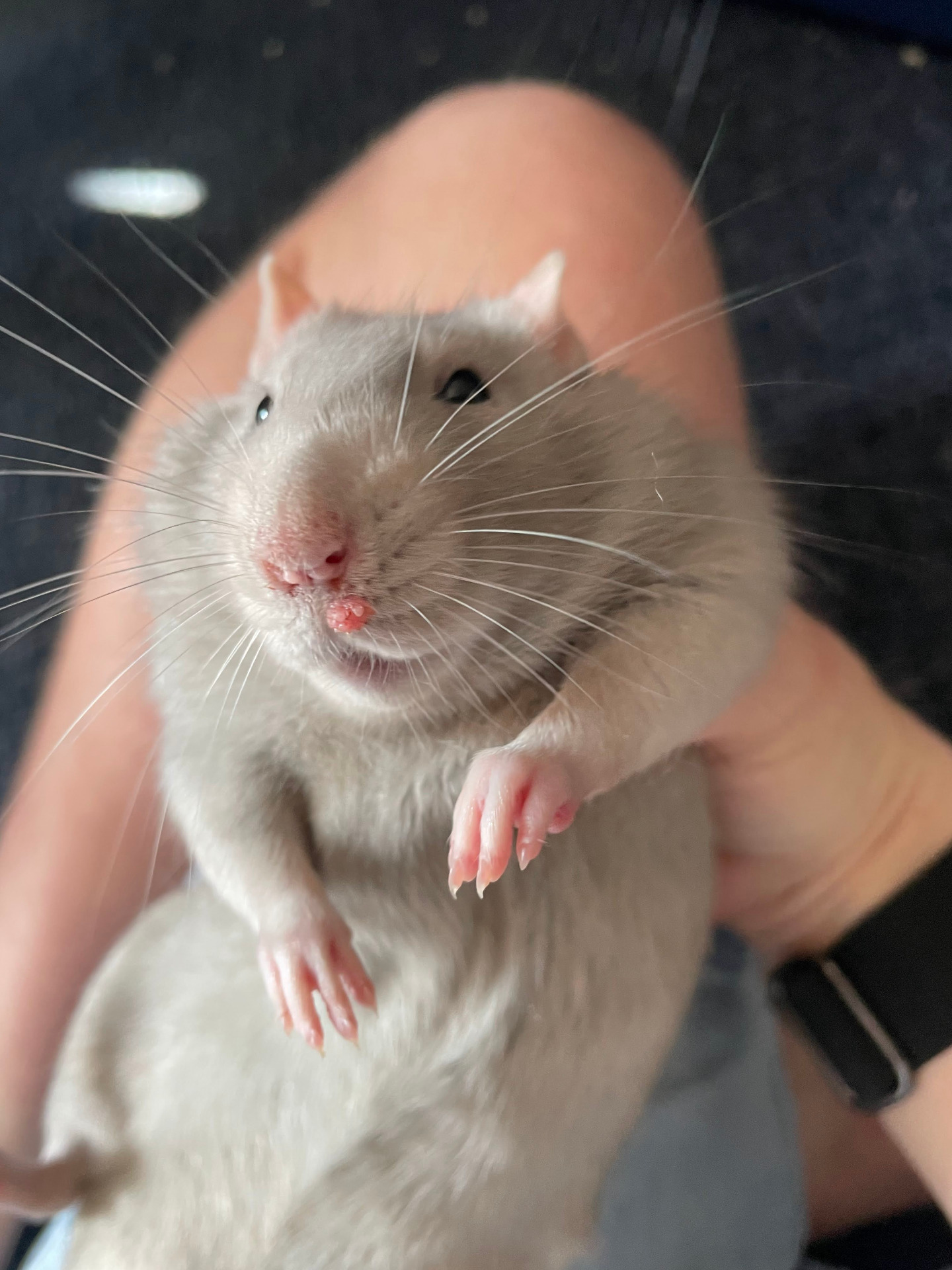
An example of a wart on Zabu's snout

Caused by the protozoa Giardia muris
Related to the species of giardia that causes giardiasis in humans, Giardia muris is a protozoa that resides in the small intestine as trophozoites (the “adult” form). The organisms then divide by binary fission to replicate. Additionally they have a secondary lifecycle form known as a “cyst”. When a cyst is ingested by an uninfected host, they differentiate into the trophozoite form and adhere to the small intestine. Cysts are shed in the faeces of the rat, which can then spread from cagemate to cagemate. Infection is typically asymptomatic and does not cause harm to humans or infected rats. However, in heavy infection cases, lethargy, appetite reduction, and loose stools can be reported.
This is a genetic disorder similar to that of Hirschsprung’s disease in humans characterised by a lack of autonomic nerve ganglions within the smooth muscle of the colon. The lack of ganglions results in a narrowed, permanently-contracted colon unable to pass bowel movements.
Typically identified early in life before rats are fully weaned, this condition can arise later in life (aka late onset megacolon), as it can sometimes involve only a portion of the colon. Symptoms include a distended, firm, painful abdomen, impacted faeces in the rectum, and lack of appetite. Euthanasia is recommended as the disease is fatal.
Caused by the nematode Syphacia muris
Related to Enterobius vermicularis that causes pinworm in humans, this nematode inhabits the caecum and colon. Eggs, which are deposited by the female, sit on the perianal region of the rat, which can cause excessive itching or grooming. Infection can result in an inability to gain weight as the host has impaired intestinal electrolyte transport due to the presence of adult worms. In heavy infections, irritation in the colon/rectum can result in bright, bloody stools. This infection is typically considered mildly pathogenic and is easily treated with a single dose of an antihelminthic drug such as Fenbendazole, or administration of a general antiparasitic drug, such as Selamectin (Kitten/Puppy Revolution).
Pinworms present on the outside of the anus.
Credit: @shinymawile on Discord
Seoul Virus is a type of hantavirus that is carried by both pet and wild rats. While the virus is asymptomatic in rats, persistent infection is spread through saliva and excretions. Rats who have Seoul carry the virus for life, and pose a risk of spreading it to both humans and other rats.
Seoul virus causes severe illnesses in humans such as Haemorrhagic fever with renal syndrome (HFRS) and Hantavirus pulmonary syndrome (HPS). These are severe diseases that can be fatal. This is a reportable disease to CDC, ECDC and Public Health England.
Mycoplasma pulmonis (aka myco) is a normal inhabitant of the respiratory and reproductive tract. Passed naturally via the birth canal during birth, it is found in all pet rats (outside of laboratory lines bred specifically to not carry the bacteria). Laboratory-grade rats who have been bred not to carry myco can become infected later in life following exposure to rats carrying the bacteria. When rats become stressed, exposed to another respiratory disease such as Sendai or SDAV, or have an immunocompromised status, Mycoplasma can flare, resulting in respiratory disease.
The environment additionally plays a part in whether or not a rat contracts myco-related respiratory illness. Ammonia build-up in the environment is the biggest contributor to respiratory inflammation in rats, as it destroys the cilia present within the lungs. Cilia are small, finger-like projections in the respiratory tract of all mammals that work alongside mucous to push out dust, dirt, and harmful pathogens. When cilia are destroyed, pathogens will increase in number within the respiratory tract, resulting in severe respiratory illness in rats.
While Mycoplasma is not something that can be permanently removed from the respiratory tract, respiratory illnesses can be treated with combination antibiotics (Doxycycline/Enrofloxacin or Doxycycline/Azithromycin). Any subsequent lung scarring and difficulties breathing can be minimised with bronchodilators and mucolytics.
The Sialodacryoadenitis virus, commonly known as SDAV or SDA, is a rodent coronavirus. A highly contagious airborne virus that weakens the immune system, the disease has an extremely high mortality rate within pet populations once exposed. Symptoms can arise within five days of being exposed. Clinical signs include the swelling of lymph nodes, especially around the neck and under the chin, bulging of eyes, weight loss, dehydration, and severe secondary respiratory infection due to Mycoplasma pulmonis.
There is no treatment for the virus itself, but tackling secondary infection and maintaining hydration is important in providing the rat the best chances of survival. The immune system will neutralise the virus over the course of 7 to 10 days. Following recovery, infected rats must be quarantined with a strict isolation period. Since the virus is airborne, at-home quarantine is not effective. This, alongside Sendai Virus, is why it is extremely important to quarantine new rats to prevent viral outbreaks.
Sendai Virus (SeV) is a highly contagious paramyxovirus virus. Transmission occurs through direct contact or by the inhalation of aerosols. SeV is immunosuppressive, inhibiting proper immune function in the rat. Secondary pathogens, particularlyMycoplasma pulmonis, contribute to severe infection. There are two types of SeV infection that can affect a rat colony: Enzootic and Epizootic.
Enzootic infections are typically seen in laboratory and breeding colonies. Adults in these groups have previously been exposed to the virus early in life and have developed active immunity against it through the production of antibodies. However, the virus still remains within the colonies as breeding perpetuates it within the population. In pet colonies, maternal antibodies protect newborn rats for the first six to eight weeks of their life, before becoming infected with the virus. It is only then that they will either fight off the virus and acquire immunity, or die as a result of the illness.
Epizootic infections are typically seen in pet homes and uninfected ratteries. When SeV is introduced into the colony the virus spreads quickly, infecting all. Complications from secondary infections are capable of wiping out an entire group of rats. Sendai is capable of devastating an entire pet or breeding colony. I have personally experienced a Sendai outbreak in my own colony back in 2022, and out of the nine rats I owned, only two of them survived.
Symptoms include sneezing, respiratory distress, hunched posture, and sudden death. Antibiotics to tackle secondary infection, as well as fluid replacement and temperature regulation is important to allow affected rats to recover, but as soon as symptoms arise, prognosis is guarded. This, alongside SDAV, is why it is extremely important to quarantine new rats to prevent viral outbreaks.
RBF is a bacterial infection caused by Streptobacillus moniliformis in North America and Europe, and Spirillum minus in Asia. Approximately 50% of all wild rats carry the bacteria, and while it is unsure of the exact proportion of pet rats carrying the disease, it is exceptionally rare. Rats are asymptomatic carriers and do not exhibit any significant symptoms, but the bacteria resides in their respiratory tract. Cases of RBF in humans are most commonly reported in Japan, and individuals with the disease often make full recovery following antibiotic administration.
Leptospirosis, also known as Weil’s Disease, is caused by spirochete bacteria of the Genus Leptospira. Typically carried by wild rodents, this is rarely reported in pet populations. However, pet rats can come in contact with infected urine following exposure to other pets in the house (such as dogs and cats) or spending time outdoors and coming into contact with contaminated soil or water. While rats typically show no outward signs other than increased drinking and urination, lepto is extremely contagious to all mammals, including humans. In mammals, symptoms range from subclinical to severe, and can even be fatal. The bacteria is shed in the urine of infected animals for years. As such, humane euthanasia is recommended to prevent spreading to others. This is one of many reasons why it is advised against interspecies interactions with dogs, cats, and other animals.
At its core, aggression is inherently genetic. It has been found that multiple specific genes, such as the Gltscr2, Lgi4, Zfp40, and Slc17a7 are contributors to the varying degrees of aggressiveness in rats. Specific regions of rodent DNA, known as quantitative trait loci, that correlate with tameness have also been identified. Aggression can be separated into two main categories: hormonal and general. Hormonal aggression is impacted by hormone levels in the rat. Testicular hormone-associated aggression is most commonly seen in male rats. Hormonally-aggressive male rats tend to exhibit aggressive behaviours between the ages of four and nine months of age, when testosterone levels are highest. Castration of hormonally-aggressive male rats can alleviate aggressive behaviours, but is not always successful due to the specific genes underlying the aggressiveness. General aggression is not related to hormone levels in the body.
Aggression has several behaviours associated with it, such as lunging, hissing, mounting, piloerection (puffiness), and teeth chattering. However, the most significant, dangerous behaviour is biting.
Biting is not a learned or trained behaviour, but comes from the way their bodies produce chemicals in response to how their genes are expressed in stressful situations. Less aggressive, more tame rats have multiple differences in their endocrine and adrenal systems, including lower serotonin levels, reinforcing the biological basis of rodent aggression. Aggressive rats can unexpectedly bite cagemates because the cagemate doesn't know how to avoid scaring it as well as a human might. Attacks from other rats can become fatal quickly if intervention is not sought. In addition, a rat that chronically bites is regularly stressed, afraid, and unhappy; this is not a good quality of life for the rat. Since aggression is on a genetic basis, it cannot be trained out. There are no reliable studies that prove that rats can be successfully trained out of aggressive behaviour.
HLD is commonly seen in elderly rats from approximately 1.5y onwards and is typically the result of kidney failure due to old age. Characterised by the gradual loss of strength in the back legs, a loss of muscle tone is accompanied by difficulties with mobility. Symptoms start off mild, with affected rats exhibiting a mild, stumbling gait. Rats can generally get on for some time with modifications to the cage, such as providing low-to-the-ground hammocks and plenty of fall breaks. There is nothing that can be currently done to prevent progression of the condition, and the rat will eventually lose all function of their back legs, and begin dragging them behind. This is not a good quality of life for a rat, and humane euthanasia is recommended before the rat’s mobility is severely affected.
Early-stage HLD
Credit: @cheesefather on Discord
Late-stage HLD
This rat was euthanised following this due to poor QOL
Head tilts are most commonly caused by otitis media and interna (middle and inner ear infections), but can also be the result of stroke or pituitary tumours. Characterised by a rat’s head tilted or rotated to the side, head tilts cause poor balance and can impact a rat’s mobility. In the case of ear infections, head tilts are easily reversible with a proper course of antibiotics. If treatment is not sought before the infection becomes severe, head tilts can become permanent.
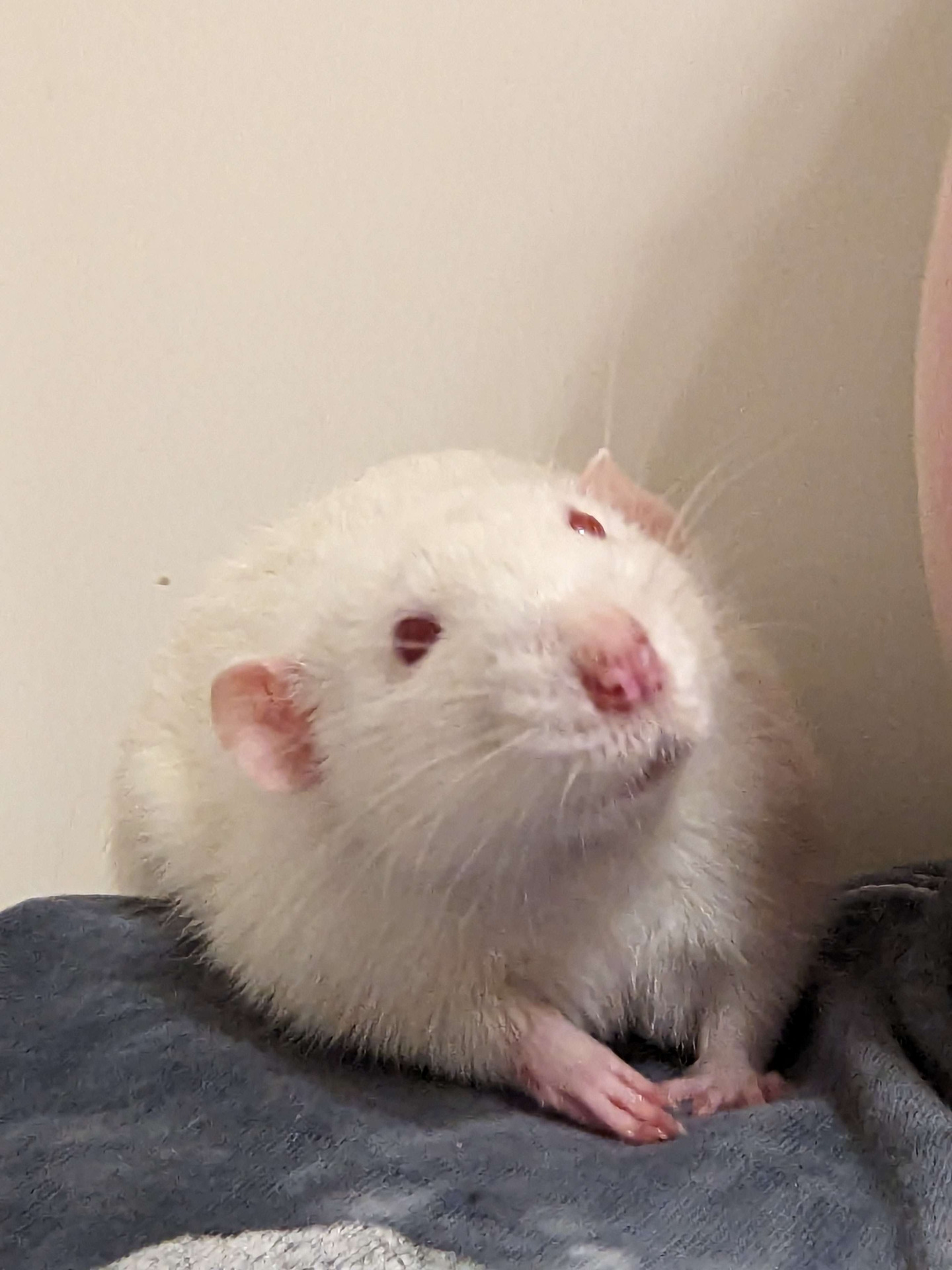
A mild residual head tilt from a rat who recovered from a severe ear infection. Credit: @murids on Discord
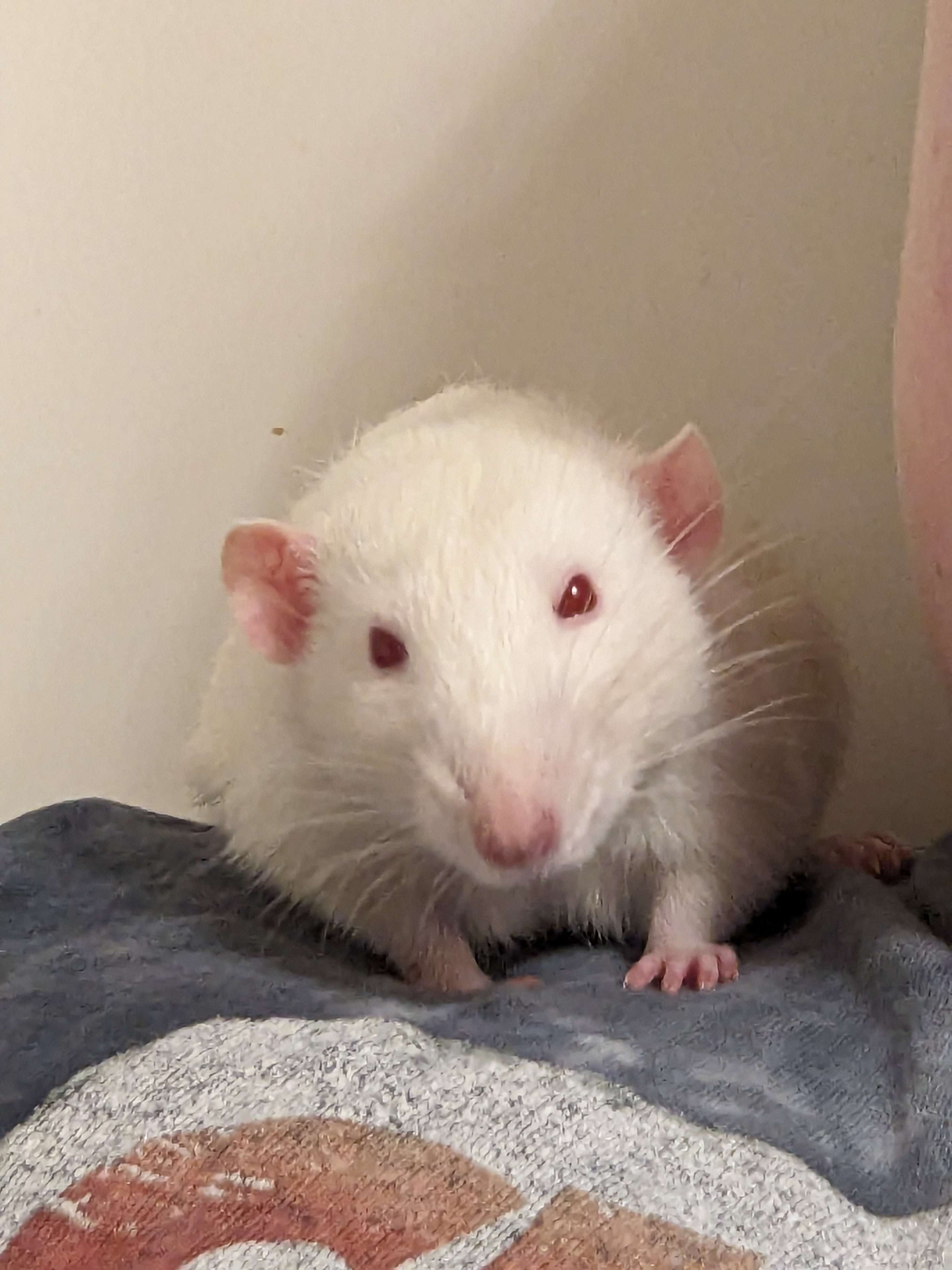
A mild residual head tilt from a rat who recovered from a severe ear infection. Credit: @murids on Discord
Head tilt in rat with ear infection
Credit: @nonkii on Discord
The pituitary gland, which is part of the endocrine system in mammals, is found at the base of the brain and is connected to the hypothalamus. Pituitary tumours are the result of abnormal cell growth in the pituitary gland. While typically benign in rats, they often grow to a size that places significant pressure on neighbouring brain tissue. Pressure against this tissue causes neurological symptoms such as a lack of coordination in the limbs, head tilts, and mobility difficulties. A characteristic posture of stiffly held-out limbs and an inability to hold weight are typically seen as the first signs. Over time, pressure from the growing tumour can also result in the bulging of eye(s), seizures, and sudden aggression due to behavioural change. Unfortunately, there is no cure for a pituitary tumour, and euthanasia is recommended to prevent further suffering, as the rat will eventually lose the ability to swallow.
Classic presentation of a PT with splayed front arms and curled back legs
Credit: @kira.t_ on Discord
Mobility challenges due to PT
Credit: @lucymagie on Discord
Convulsive seizures, which are what are typically seen in humans, are rarely present in rats. Rats most commonly experience nonconvulsive seizures that cause notable behavioural changes such as frantic, sudden movements, intense biting episodes (i.e. biting the same area several times in a row), and unexplained aggression. These episodes, which typically last only a few minutes at a time, can result in serious injury to cagemates, their handler, or themselves. Prognosis is guarded, and is largely based on the type of seizure and frequency.
Examples of suspected seizure episodes
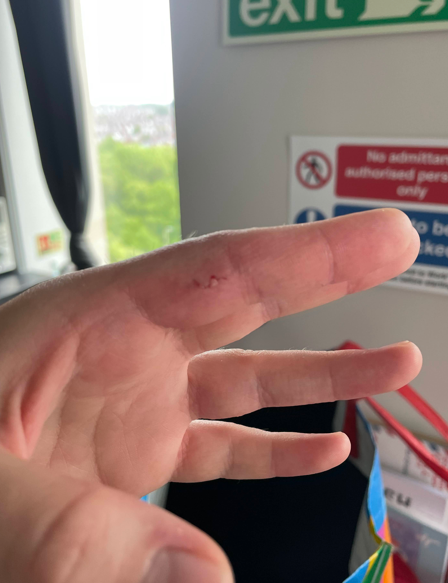
Note the presence of fatty tissue exposed on my finger as a result of the bite.
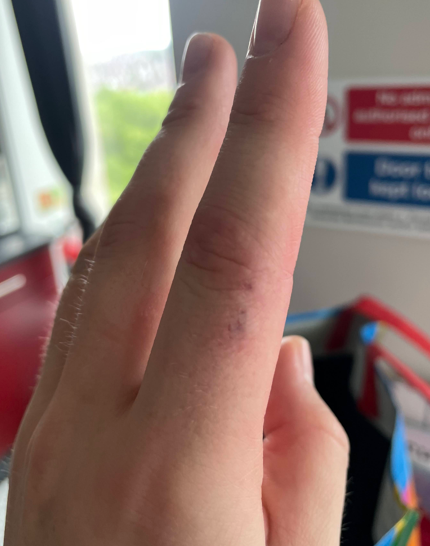
Side view, showing nerve and blood vessel bruising
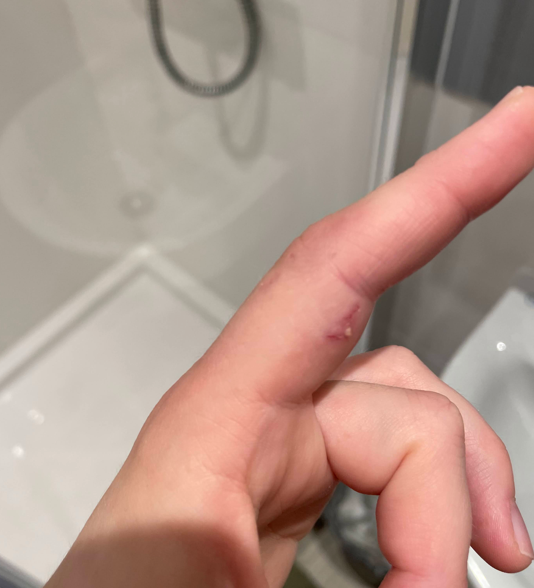
Note the fat tissue present in white on the underside of the bite mark
Strokes occur when blood flow to the brain becomes disrupted. Just like in humans, following a stroke, rats are often left with neurological deficits such as poor grip and difficulties with mobility (ataxia). Unfortunately, euthanasia is the most humane outcome due to the neurological damage sustained.
Mobility issues resulting from a stroke
Uncommonly reported in pet rats, more than 40 million people in the United States alone are infected with the parasite.
Cats are the natural host of Toxoplasma and shed sporulated oocysts in their faeces. This is then passed on to an accidental host, such as a human or a rat, through contact with cat faeces, contaminated soil, or eating undercooked meat. The parasites, which are capable of affecting all organs of the body, form bradyzoite cysts in the brain, muscle tissue, and lymph nodes.These cysts are most commonly found in the brain of the accidental host and persist for life. These cysts are typically harmless, but can cause severe inflammatory responses if a rat becomes immunocompromised, such as when recovering from an upper respiratory infection. This can lead to encephalitis and the compromising of vital organs, resulting in death.
Rodents infected with T. gondii have also been shown to have impaired behaviour for their natural aversion to cat urine,increasing the likelihood of being predated on by felines.
Exceptionally common in older rats (>1y), cataracts are characterised by a cloudiness of the ocular lens. Since rats have fairly poor eyesight and rely almost exclusively on their whiskers and sense of smell for navigation, cataracts pose no cause of concern for the rat and are purely cosmetic.
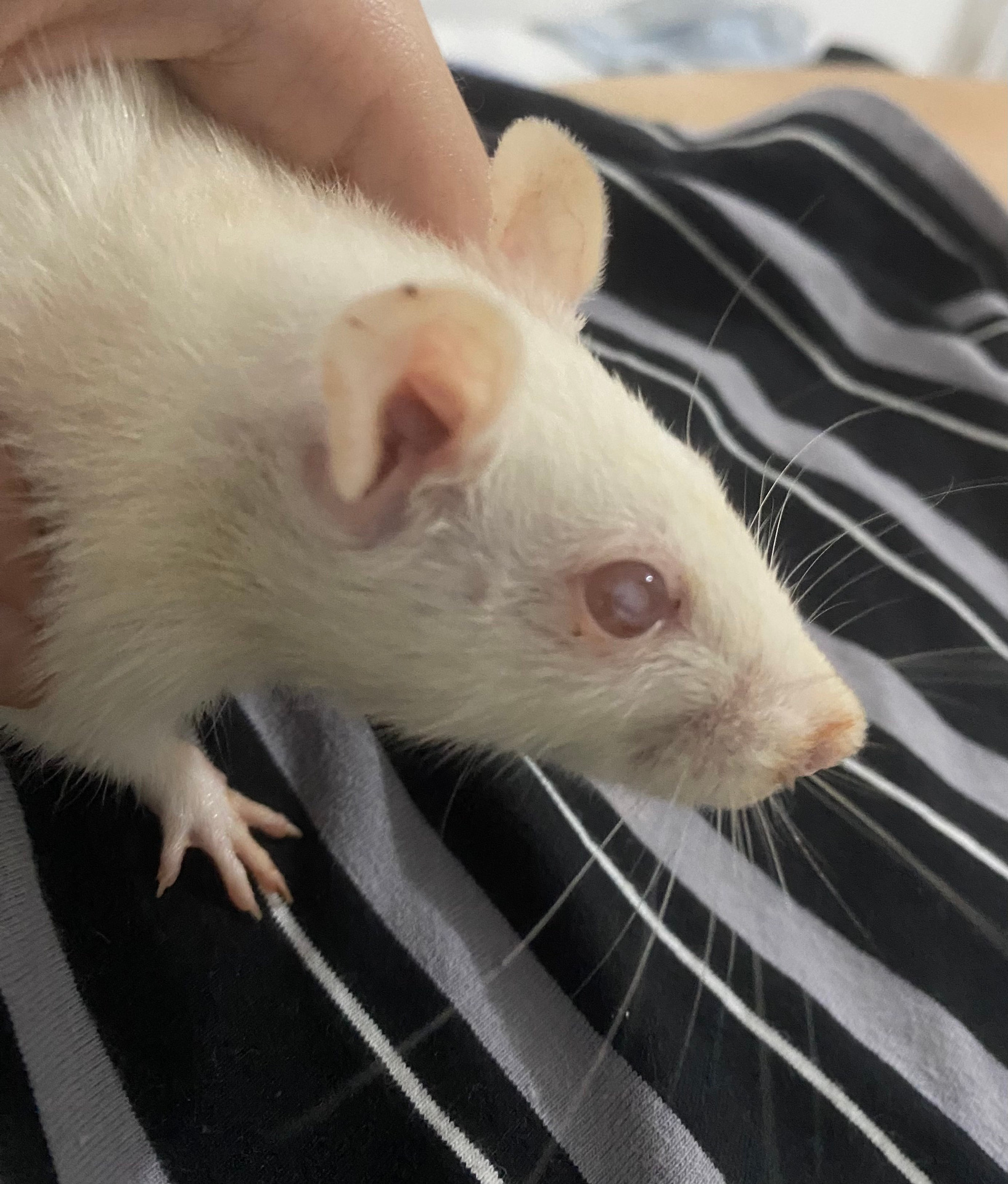
Cataract formation in the center of the eye
Credit: @moongradients on Discord
Conjunctivitis (commonly known as pink eye) is most commonly caused by bacterial infections. Characterised by the swelling of the eyelid coupled with coloured, sticky discharge, the infection requires medicated ointment or eyedrops prescribed by a veterinarian to prevent keratitis. Infection resolves over the course of three to five days following the start of treatment.
Corneal scrapes occur following trauma to the eye. Characterised by excessive grooming and tear production, injuries typically heal on their own without any intervention. In severe cases, a build-up of scar tissue can result in permanent irritation to the eye, requiring a non-medicated eye ointment application for additional lubrication.
Microphthalmia is a congenital defect or absence of part of the eye. Due to rats’ poor vision as-is, the condition is typically harmless. It is important to monitor the eye to ensure that it remains clean and free of any irritation.
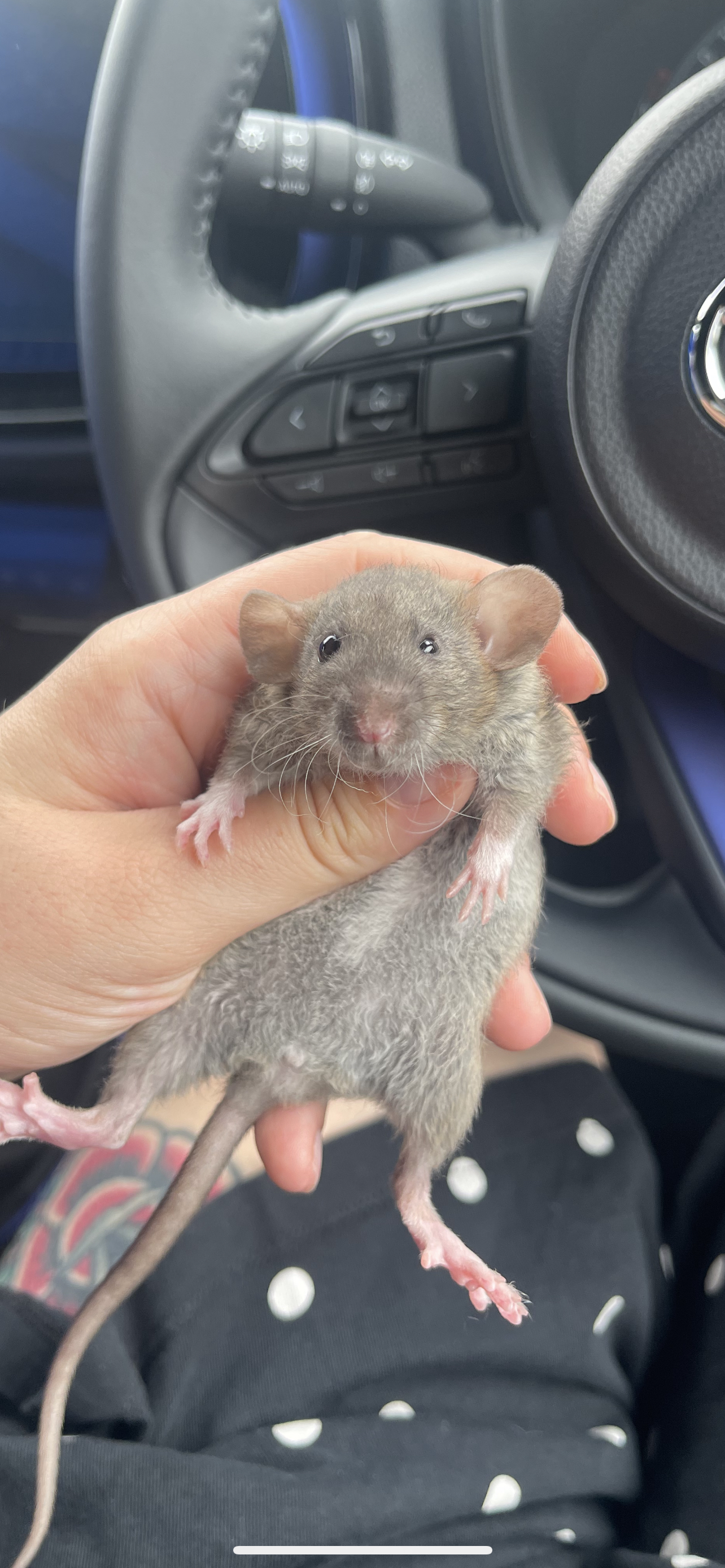
Microphthalmia on the left eye of a dwarf rat
Credit: @lucymagie on Discord
Porphyrin is secreted by the Harderian gland and aids in the movement of the nictitating membrane (the third eyelid). The Harderian gland drains into the nose and is part of the nasolacrimal system. Oftentimes confused for blood by those unfamiliar with rats, it appears as red-coloured tears and nasal discharge. There is minimal cause for concern unless there is excess porphyrin present, which is indicative of stress or illness.
Broken teeth can be the result of trauma such as falling from a significant distance. Teeth will regrow on their own over time, but it is to be cautioned that the regrowth should be monitored to ensure that the tooth does not grow back crooked

Tooth regrowth progression over the course of 8 days
Credit: @antares_anta on Discord
Malocclusion is characterised by the misalignment of the incisors (front teeth). The misalignment results in rats being unable to naturally file down their teeth. Typically, this does not resolve on its own and requires frequent trimming of the teeth. However, since this can only be done under anesthesia, it is important to consider the risks and stress associated with being placed under frequently. Best addressed on a case-by-case basis, prognosis is often guarded and euthanasia is recommended if more than one tooth trim is required.
Most commonly caused by damaged incisors, mouth abscesses are characterised by swelling on the side of the face, coupled with tooth discolouration, red/puffy gums, and a foul odor from the mouth. X-Rays and careful examination are required to determine the cause of the abscess. It is important to rule out periodontal disease in the mouths of rats, as established abscesses are capable of rapidly migrating throughout the entirety of the mouth. An infection in the incisors is capable of destroying bone and tissue, causing teeth to become misaligned, forming malocclusion.
Caused by squamous cell carcinoma, this is a malignant type of cancer that is capable of metastasizing. Typically arising in the mouth, the tumour appears “rough” and is coupled with signs of severe inflammation. Symptoms include difficulties eating, rapid swelling under the jaw/on the sides of the face, and lumpy tumours inside of the mouth. Due to the aggressive nature of this cancer, euthanasia is recommended before it impacts the rat's ability to eat and drink.
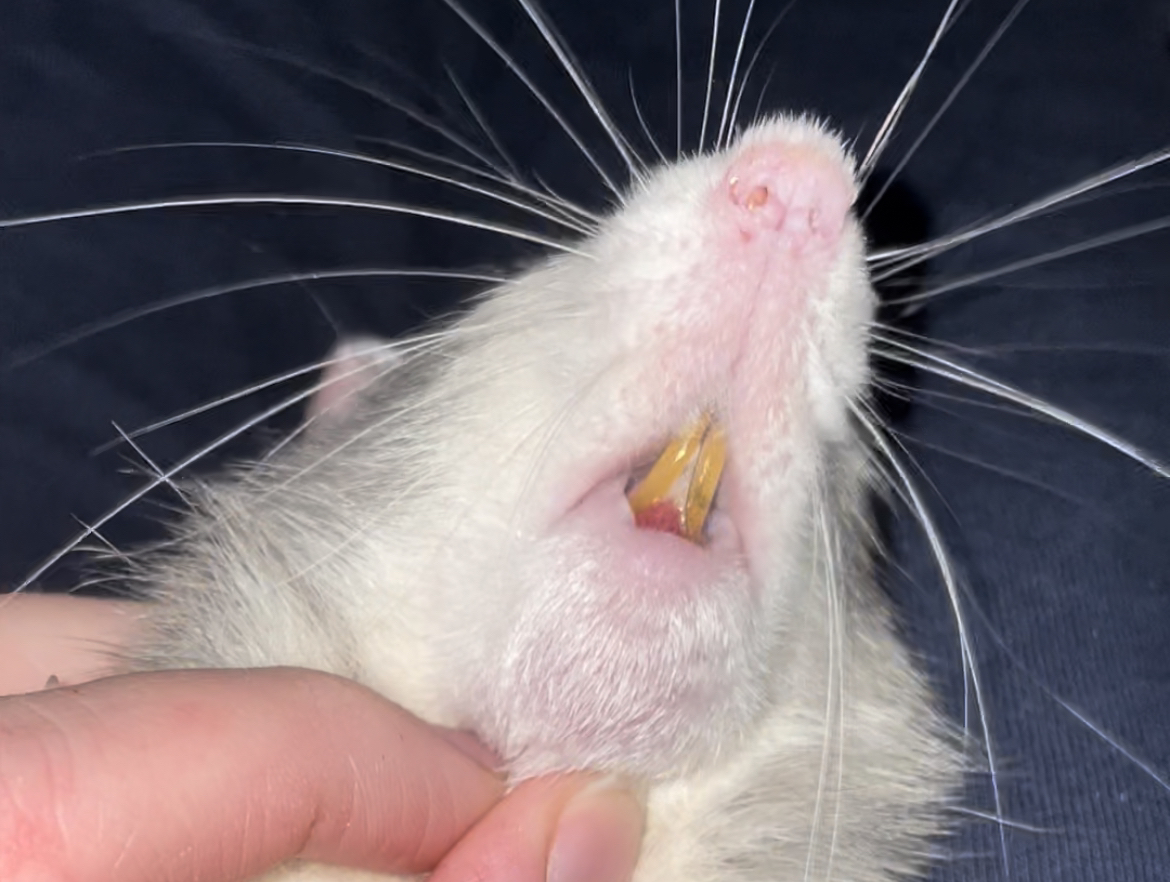
Presence of the oral tumour at the gumline of the bottom inscisors
Credit: @kira.t_ on Discord
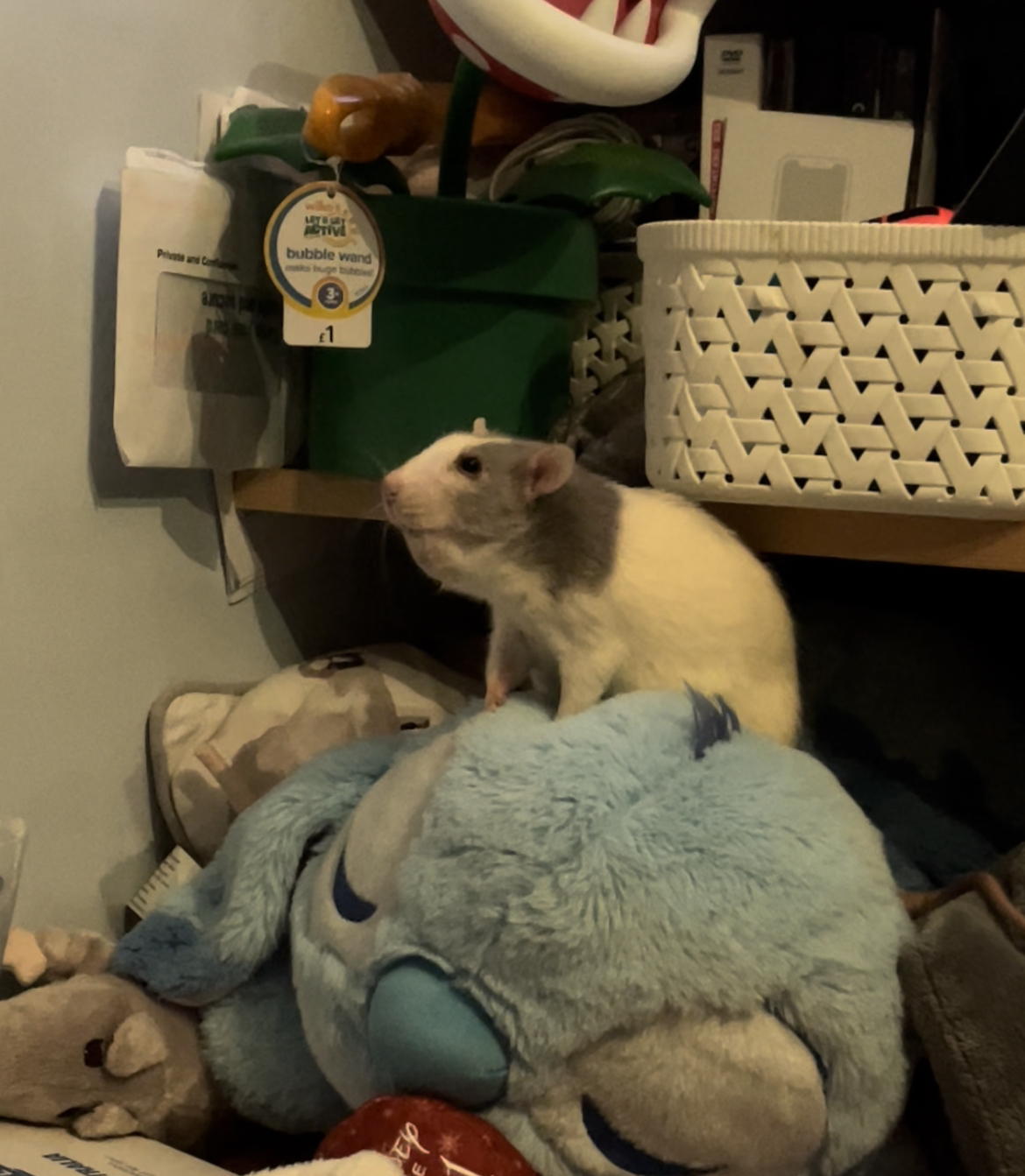
Credit: @kira.t_ on Discord
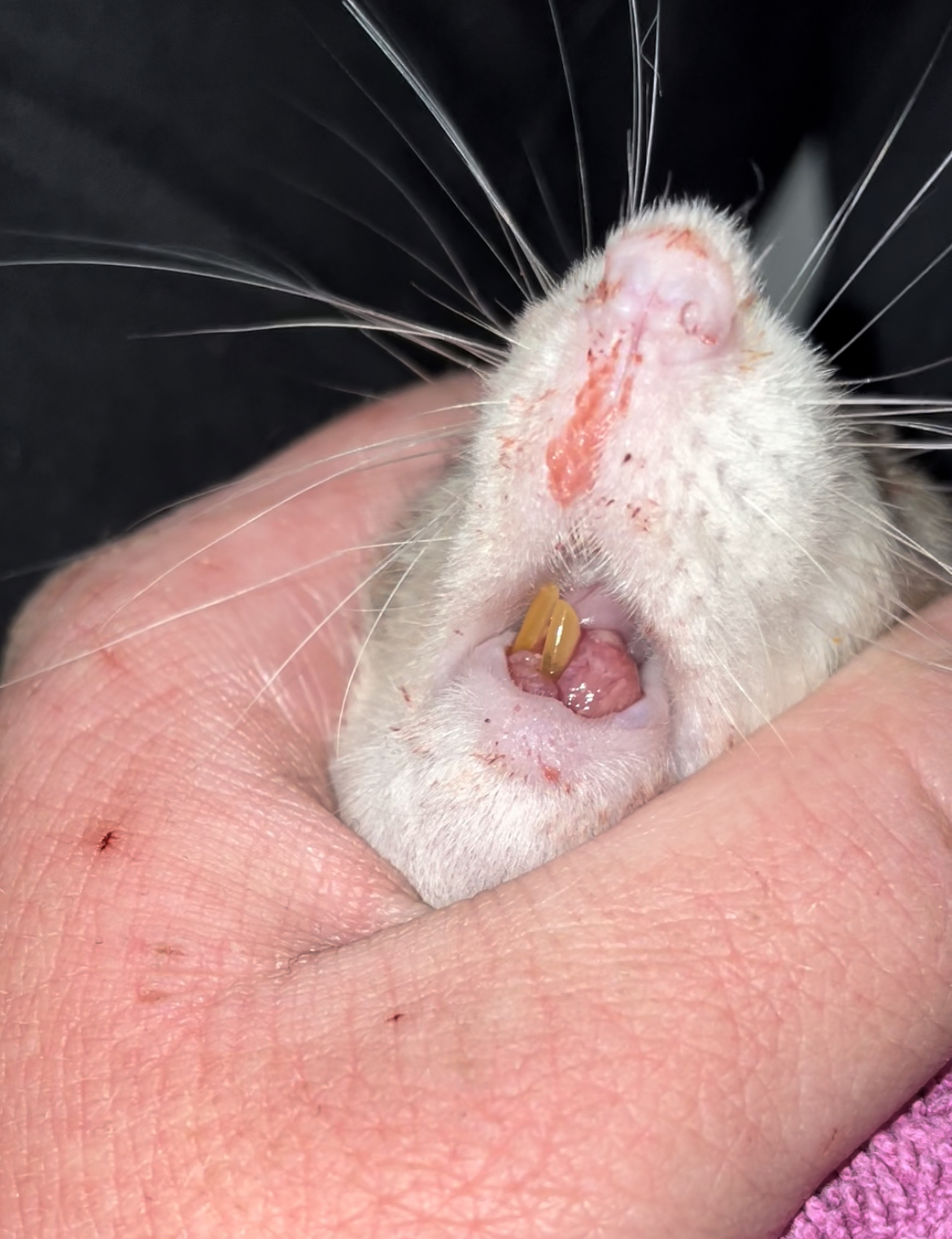
The tumour grew significantly, impacting the bottom incisors
Credit: @kira.t_ on Discord
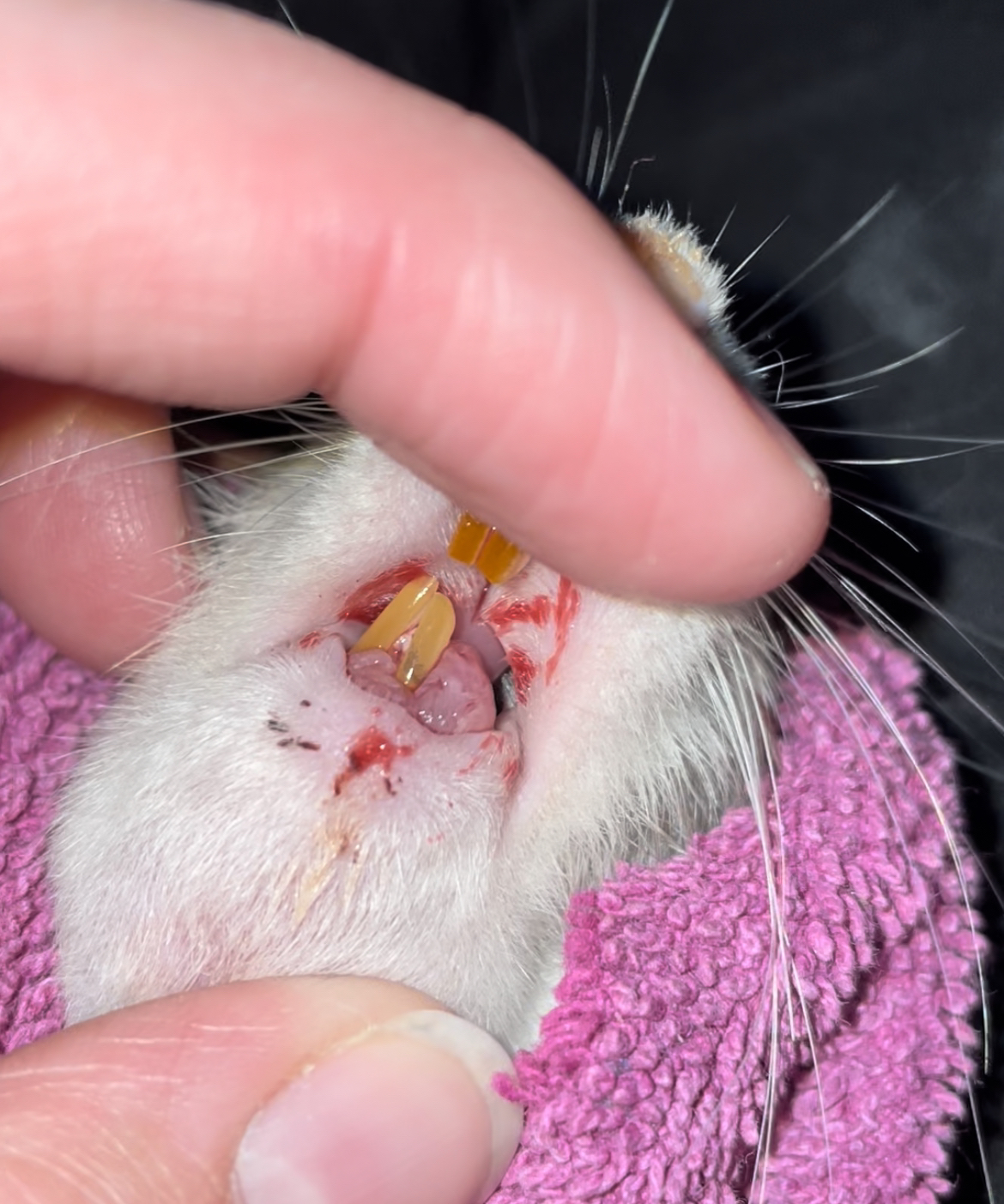
The tumour grew significantly, impacting the bottom incisors
Credit: @kira.t_ on Discord
CPN, commonly known as kidney failure, can be seen in elderly rats >18 months of age. Symptoms include a decrease in kidney function (nephropathy), chronic nephrosis, and elevated protein levels in urine. The kidneys become enlarged and pale due to a decrease in renal blood flow. Treatment typically involves calorie and protein restrictions to the diet (4 to 7% protein versus the normal 13 to 15% range)
Urolithiasis, commonly known as kidney stones, is the presence of calcified minerals in the urinary tract. Much like in humans, this is a severely uncomfortable condition. Rats with urolithiasis can have difficulty urinating (or an absence of urinating), bladder distention, dehydration, blood in the urine (haematuria), and a hunched posture. This is considered a medical emergency, as rats are typically unable to pass stones safely without medical intervention. Stones can vary in size and location, ranging from the kidney to the bladder. Presence of stones are confirmed through X-Rays and can be treated on a case-by-case basis, as directed by a veterinarian, and usually involve fluid replacement therapy and blockage removal.
UTI, also known as cystitis, is commonly caused by a bacterial infection. The urinary tract (except for the urethra) is typically a sterile environment. Bacteria that are normal flora of the digestive tract, such as E. coli, can colonise the urinary tract, resulting in infection. Symptoms include an increase in urination, blood in the urine (haematuria). While UTIs are easily treated by antibiotics, any rat showing signs of a UTI requires immediate veterinary attention, as the disease can rapidly spread to the kidneys, resulting in severe infection (pyelonephritis).
Dystocia, also known as difficult birthing, occurs when complications arise while an animal is in labour. Signs of dystocia include, excessive vaginal bleeding, prolonged labour, multiple stillborns present, severe convulsions (indicative of pain), and the protrusion of a pup visibly stuck in the vaginal opening. A typical rat birth takes between one to two hours. If a rat has not delivered more than one or two pups after three to four hours and is appearing to struggle to give birth, dystocia is likely happening. An emergency vet visit must occur immediately to prevent the death of the mother.
This is the presence of right red, slightly viscous discharge from the vaginal opening in female rats. Unlike in humans, any bleeding/red discharge seen in rats is a medical emergency, as it can be caused by ovarian cysts, neoplasia, and pyometra. In these situations, the only solution is typically an emergency ovariohysterectomy (spay). Vaginal swelling can be accompanied with bleeding in cases of uterine cancer.
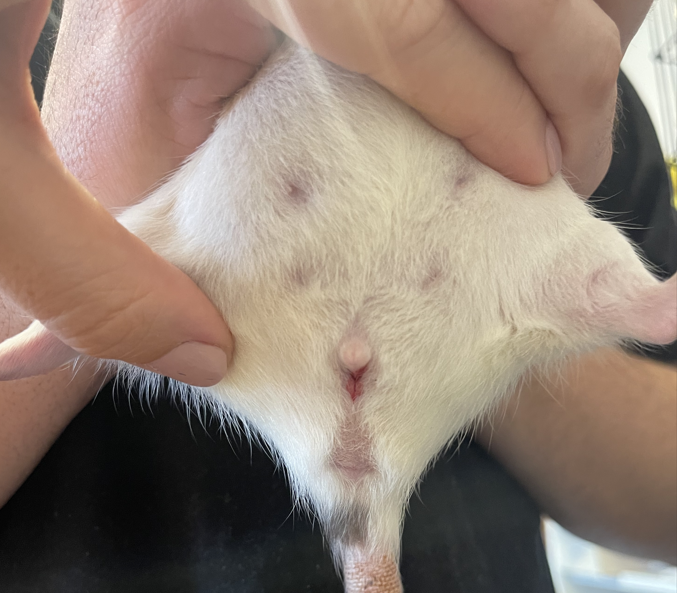
Rat underwent an emergency spay for a uterine tumour
Credit: @lucymagie on Discord
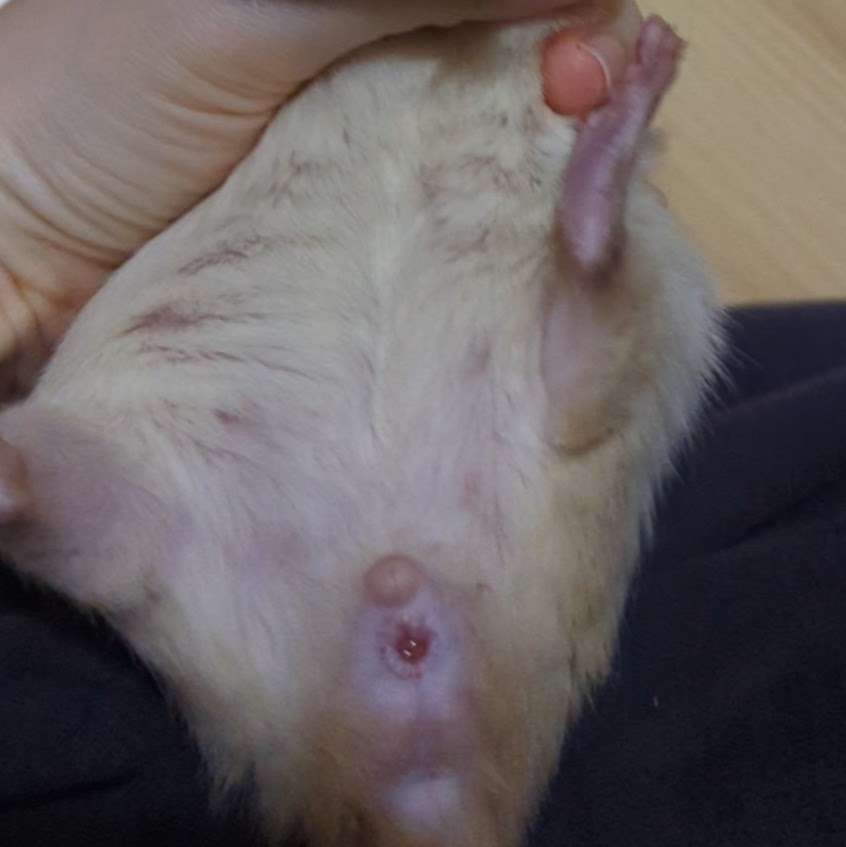
Swelling around vaginal opening was noted following cleaning of the area
Credit: @lucymagie on Discord
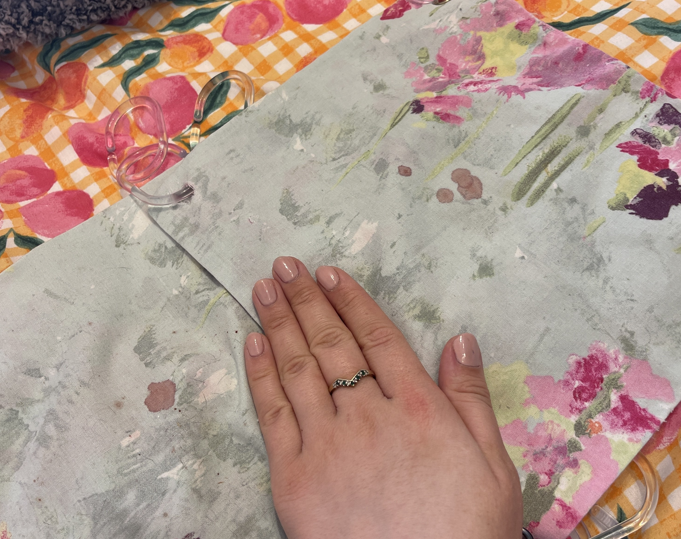
Blood was found in the hammock of the rat vaginally bleeding.
Credit: @lucymagie on Discord
Penile prolapses occur when the foreskin retracts behind the penis and is unable to return to its natural position. As a result, the penis is left exposed. Pressure from the foreskin being stuck behind the penis results in swelling to the area. Paraphimosis most often occurs in elderly male rats due to poor hygiene, as grooming difficulties tend to increase with age. Doing daily health checks and gently wiping the area with a damp cloth is best if hygiene is of a concern.
To encourage retraction of the penis, a small amount of unscented personal lubrication can be applied. The application of plain, granulated white sugar to the affected area is recommended, as gradient osmosis will decrease swelling. If retraction does not resolve itself over the course of about an hour, seek veterinary help immediately. If left untreated, lack of blood flow can result in infection, urinary retention, and necrosis.
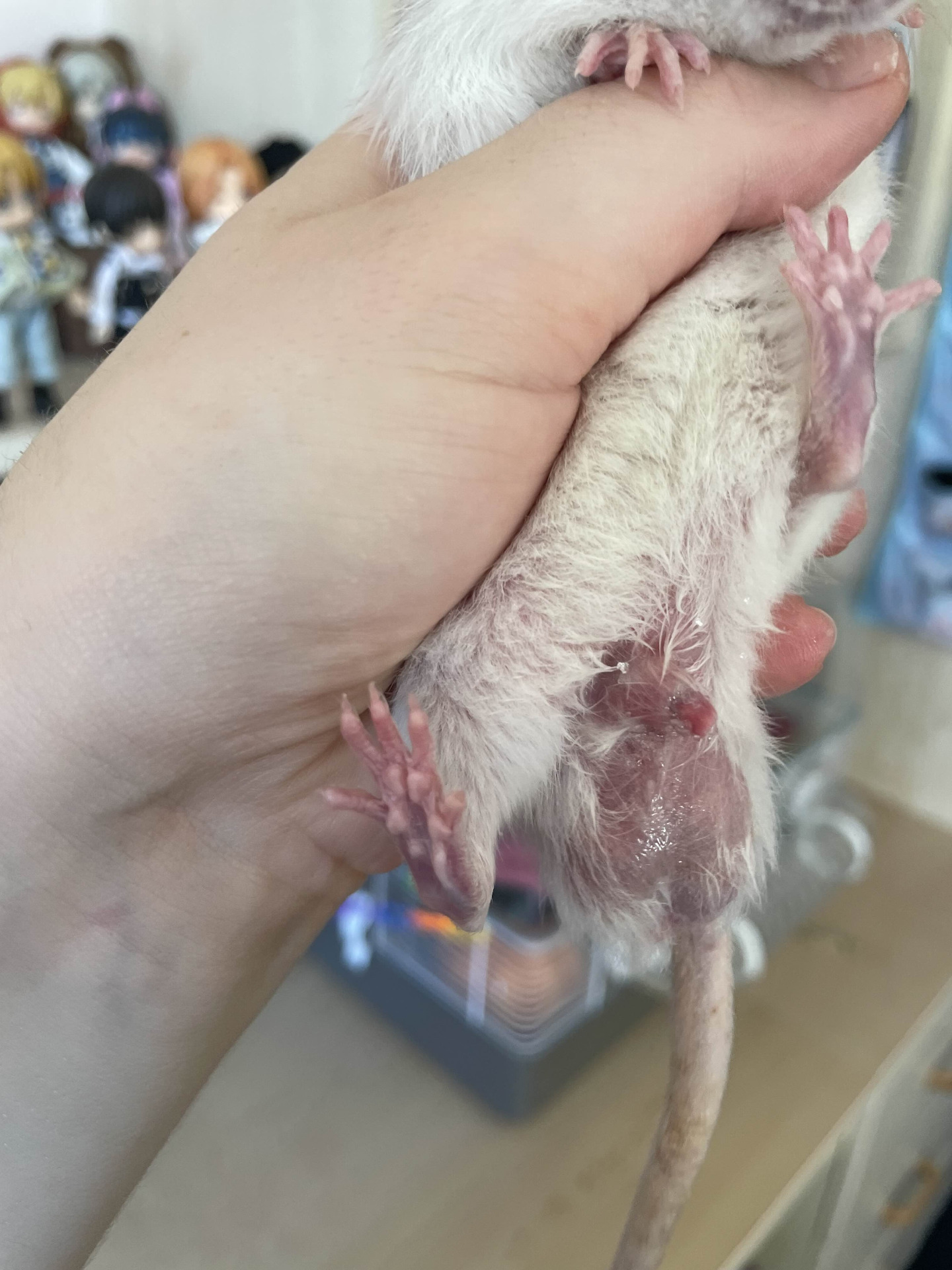
Penile prolapse in an elderly male rat
Pyometra is literally defined as the presence of pus in the uterus. More commonly seen in dogs and cats who have not been spayed, the uterine lining becomes inflamed, abscessed, and filled with pus. Discharge from the vaginal cavity is present and is foul-smelling, purulent, and is often bloody. This is a medical emergency requiring an ovariohysterectomy (spay), as toxins and bacteria from the infection have the potential to leak into the bloodstream, causing sepsis.
Vesical proteinaceous plugs, also known as penis plugs, are incredibly common in older males. The cream-coloured plug is composed of dead skin cells and proteinaceous material. Typically removed by the male rat during the grooming process, plugs can block the urethra, preventing urine from passing. When rats are unable to groom themselves properly, these can block the urinary tract, causing infection. As a result, they may need to be removed manually.
Removal of penis plugs
If a penis plug is found to be blocking the urethra, it needs to be removed. To do so, apply a gentle pressure with your thumb and index finger on each side of the penis. Carefully massage to project the penis outward from the sheath and remove the plug. Ensure to be gentle while removing, as the tissue is extremely fragile. If the plug is too firm, apply a warm, damp cloth to the area to ease removal and prevent further irritation.If there are any signs of infection such as foul-smelling discharge, inflammation, and pain, contact a veterinarian to discuss treatment options.
Murine respiratory mycoplasmosis comprises both upper and lower respiratory infections (however, upper respiratory infections are more commonly seen). Primarily caused by the bacteria Mycoplasma pulmonis (see, Infectious Diseases), this is one of the most commonly seen illnesses in pet rats. Signs include excess porphyrin, increased respiratory rate, weight loss, and lethargy. For more examples of behaviour, see Health Indicators.
Mycoplasmosis can be categorised by three different stages: mild, mid, and late stage.
1. Mild stage - rat may appear slightly “puffy” and sneeze excessively. Congestion may be present, with mild crackling in the lungs. A small chirp/click/wheeze sound can be heard alongside the sneezes.
2. Mid stage - rat will become noticeably puffy, indicating pain and discomfort. The rat may start to be lethargic and drop a small amount of weight. Sneezing and respiratory wheeze will be more prevalent and consistent. Respiratory rate will appear more forceful.
3. Late stage - rat is exceptionally lethargic and feels almost “weak” when lifting them up. Severe respiratory distress will include signs such as side sucking and open-mouth breathing (gasping). This is an IMMEDIATE MEDICAL EMERGENCY as the rat is unable to properly get oxygen to their lungs.
The severity of the infection is time dependent, as mycoplasmosis will not resolve on its own. Veterinary intervention is required for the rat to make a full recovery, regardless of the stage. The sooner a rat is seen, the greater the chance of recovery. If a rat is past stage 2, there is poor prognosis, especially since it can progress to a more severe condition, such as pneumonia. Respiratory illnesses can cause a rat to go downhill in as little as 12 hours from the start of symptoms and needs proper medical attention. If not treated, it will be fatal. Treatment must involve a combination of Doxycycline and Enrofloxacin, or Enrofloxacin and Azithromycin, as one antibiotic alone will not be sufficient enough to treat infections.
Pneumonia is a serious respiratory condition and can be the result of untreated mycoplasmosis, Sendai Virus, or Sialodacryoadenitis virus.
Clinical signs include laboured breathing, gasping, lethargy, loss of appetite, wheezing, hunched posture, and in severe cases, cyanosis of the feet and tail. Immediate medical intervention is necessary, and supplemental oxygen alongside heavy steroids is often prescribed in addition to antibiotics to target any secondary bacterial infections. Confirmation of the disease is often through X-Rays to identify the presence of inflamed lungs when other respiratory infections have been ruled out. Even with treatment, there is a guarded prognosis.
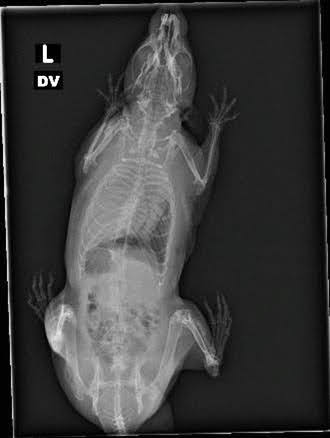
Severe pneumonia characterised on an X-Ray by the "white" in the lungs. Under normal conditions, lungs should appear black on an X-Ray Film
